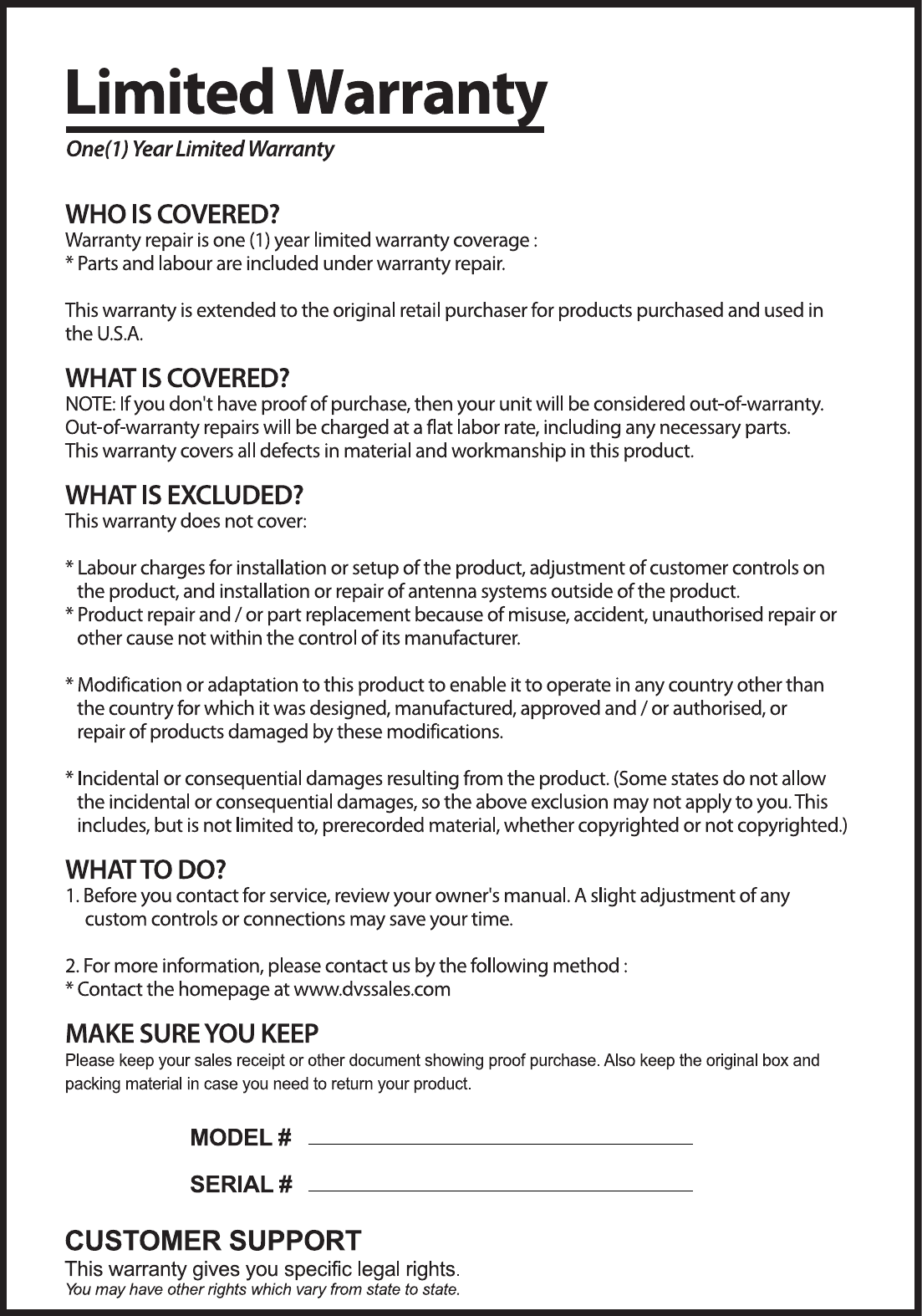DVS Korea VXA-2000 Navigation System User Manual ATT E MANUAL
DVS Korea Co., Ltd. Navigation System ATT E MANUAL
Users Manual

MODEL : VXA-2000
HYUNDAI CALIBRATION & CERTIFICATION TECHNOLOGIES CO., LTD.
SAN 136-1, AMI-RI, BUBAL-EUP, ICHEON-SI, KYOUNGKI-DO, 467-701, KOREA
TEL:+82 31 639 8517 FAX:+82 31 639 8525 www.hct.co.kr
Report No. : HCT-F06-0501 1/1
ATTACHMENT E.
- USER’S MANUAL -
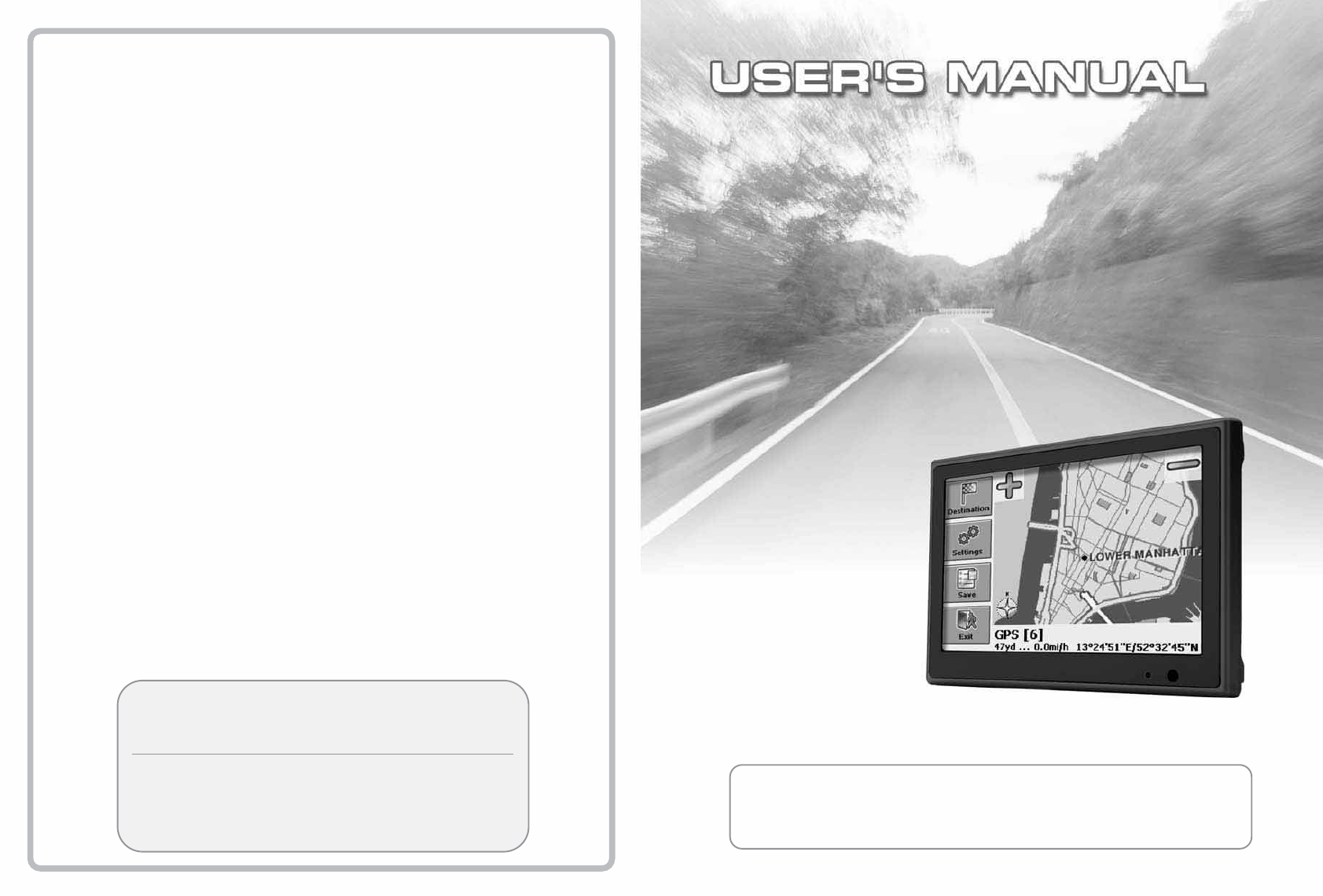
ƕPlease, be sure to read the ũSafety PrecautionsŪcarefully before using this product.
ƕLimited warranty is included in this UserŪs Manual.
ƕSpecifications and design are subject to change without notice.
ҶNavigation function
ҶAudio player function
ҶGame function
ҶAux function
UserŪs Manual
Please write your phurchasing date down here, which is needed for custom
service and registration at our web site.
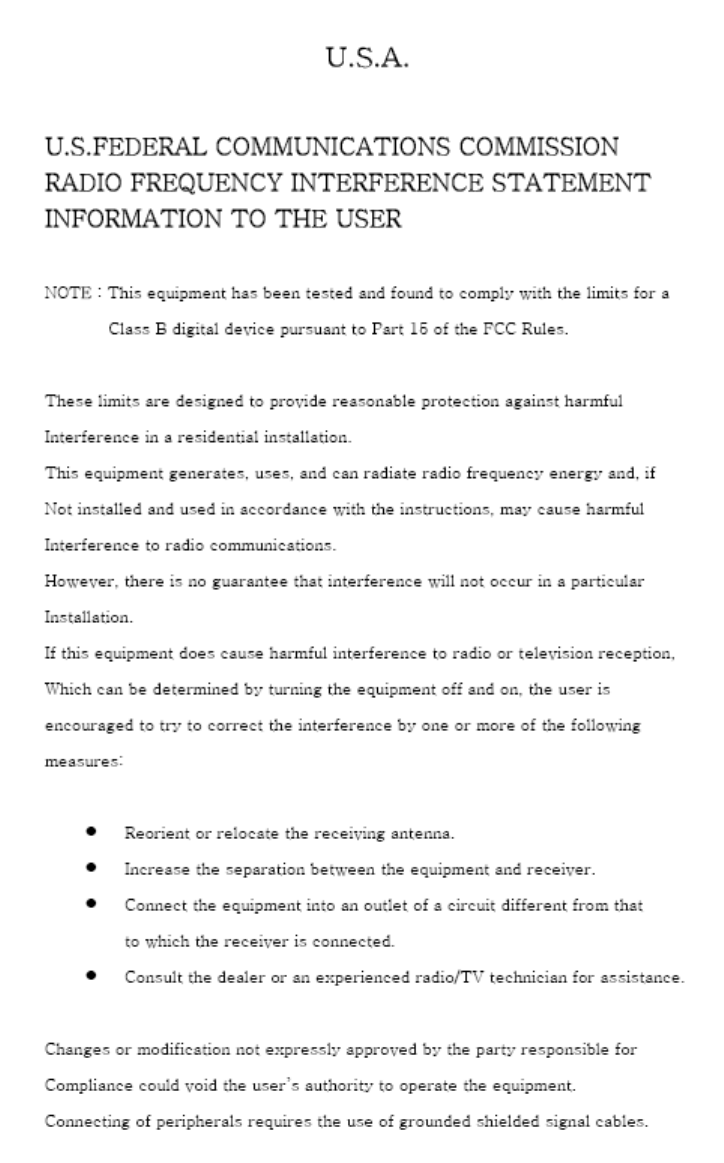
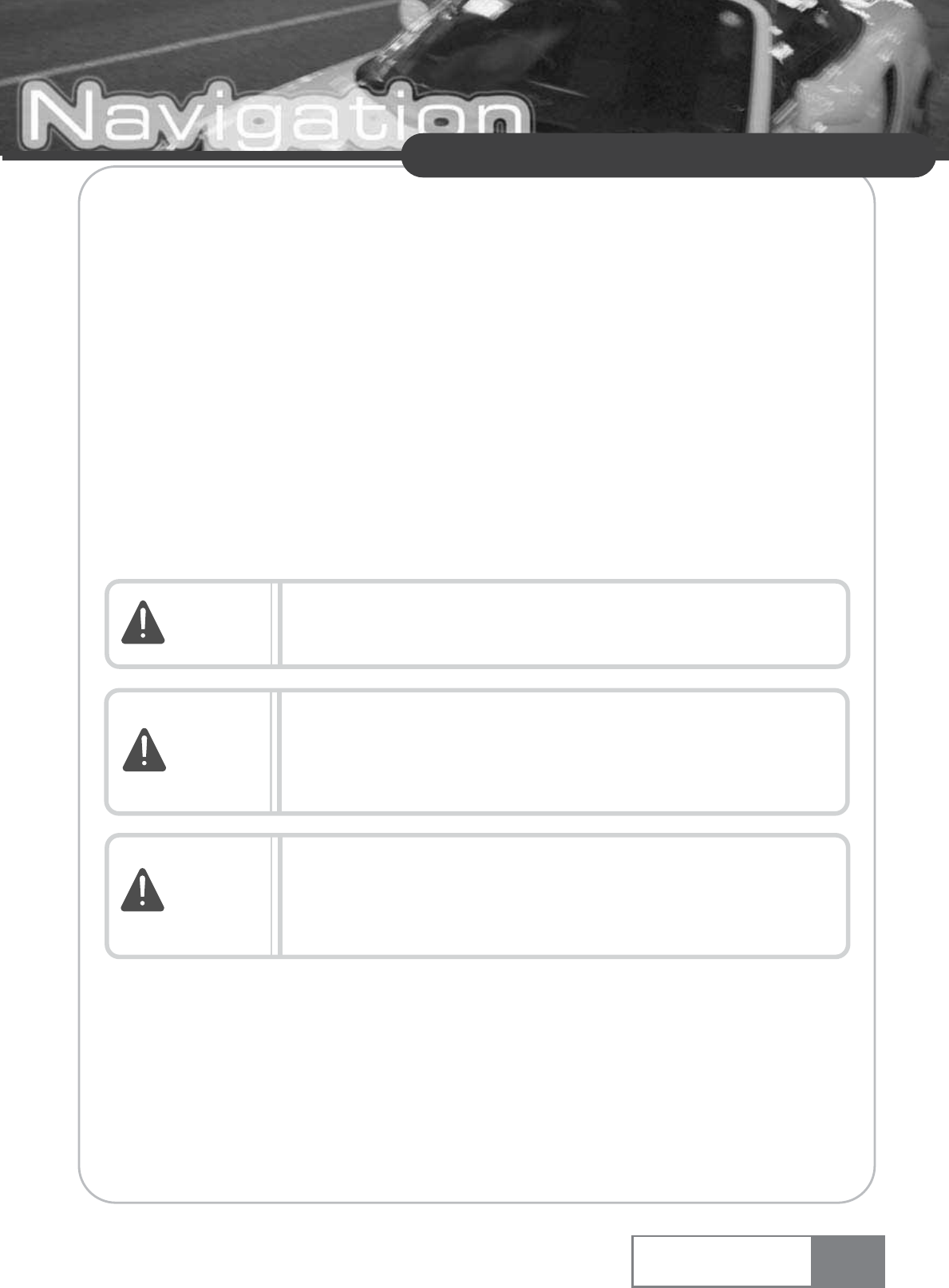
Thank you for purchasing our product.
Navigation System Userœs Manual is designed to support convenient usage of the navigation system
and safe driving. Please read the manual carefully before using the product for safe usage.
The content of this manual can vary according to the navigation system version, and function or
performance of the navigation system and this manual are subject to change without prior notice for
userœs convenience.
Make sure to read this manual for safe driving.
Please comply with the following instructions to prevent the property loss of the driver and user.
1
Warning Do not set or search for a destination while youœre driving. Make sure to park
at a safe place before operating this device.
Warning
Warning
Voice guide and map route can be different from actual road conditions.
Ensure to comply with the actual road signal system and traffic regulations for
safe driving.
Navigation System
It is very dangerous to operate the navigation system or look at the screen
while youœre driving. Be careful of surrounding traffic conditions or
pedestrians if you have to operate the system while youœre driving.

2Navigation System
Table of Contents
Basic Operation
About Navigation System
1. Directions before using this product
1-1. Usage directions
1-2. Installation directions
1-3. Upgrade directions
1-4. Troubleshooting
2. Components
3. Description of external features
3-1. Front/Right side
3-2. Rear/Left side
4. Installing product
Using Navigation System
1. Basic functions
2. Learning basic remote controller functions[Option]
3. Main menu
4. Quick Start
4-1. Start Screen
4-2. Choose a destination
4-3. Navigation Screen
5. Detailed Description
5-1. Choose your Destination
5-2. Plan your Route
5-3. Settings
6. Setup Assistant
6-1. Guides
6-2. Traffic Message Channel (TMC)
7. Frequently Asked Questions
8. Audio player
8-1. Basic screen
8-2. List screen
9. Game
10. Aux
11. Setup
11-1. Slide show
11-2. Background image
11-3. Touch setting
11-4. Volume
11-5. Dimmer
11-6. Upgrade and download using USB
11-7. A/V Input
11-8. Delete file
11-9. Confirm settings
11-10. Cancel settings
11-11. Restore default
3
3
3
3
4
5
5
6
7
7
8
9
11
11
12
14
14
15
16
17
19
19
31
33
37
37
37
39
41
42
43
44
45
46
49
49
50
51
52
52
52
55
57
57
57
56
56
56
56
56
58
59
60
66
72
79
79
79
80
81
81
81
V-Up Pro
V-Up Pro
1. Installing ActiveSync and V-Up Pro
Program
1-1. Install ActiveSync Program
1-2. Install V-Up Pro Program
2. Running V-Up Pro Program
3. Closing V-Up Pro Program
4. System Upgrade
5. Music Management
6. Bitmap Management
Upgrading Navigation System
Downloading Navi or OS
What is V-Up Pro?
Specification
Customer Support and Product
Enquiry
Customer Support and Product
Enquiry
Customer Service Center
Limited Warranty
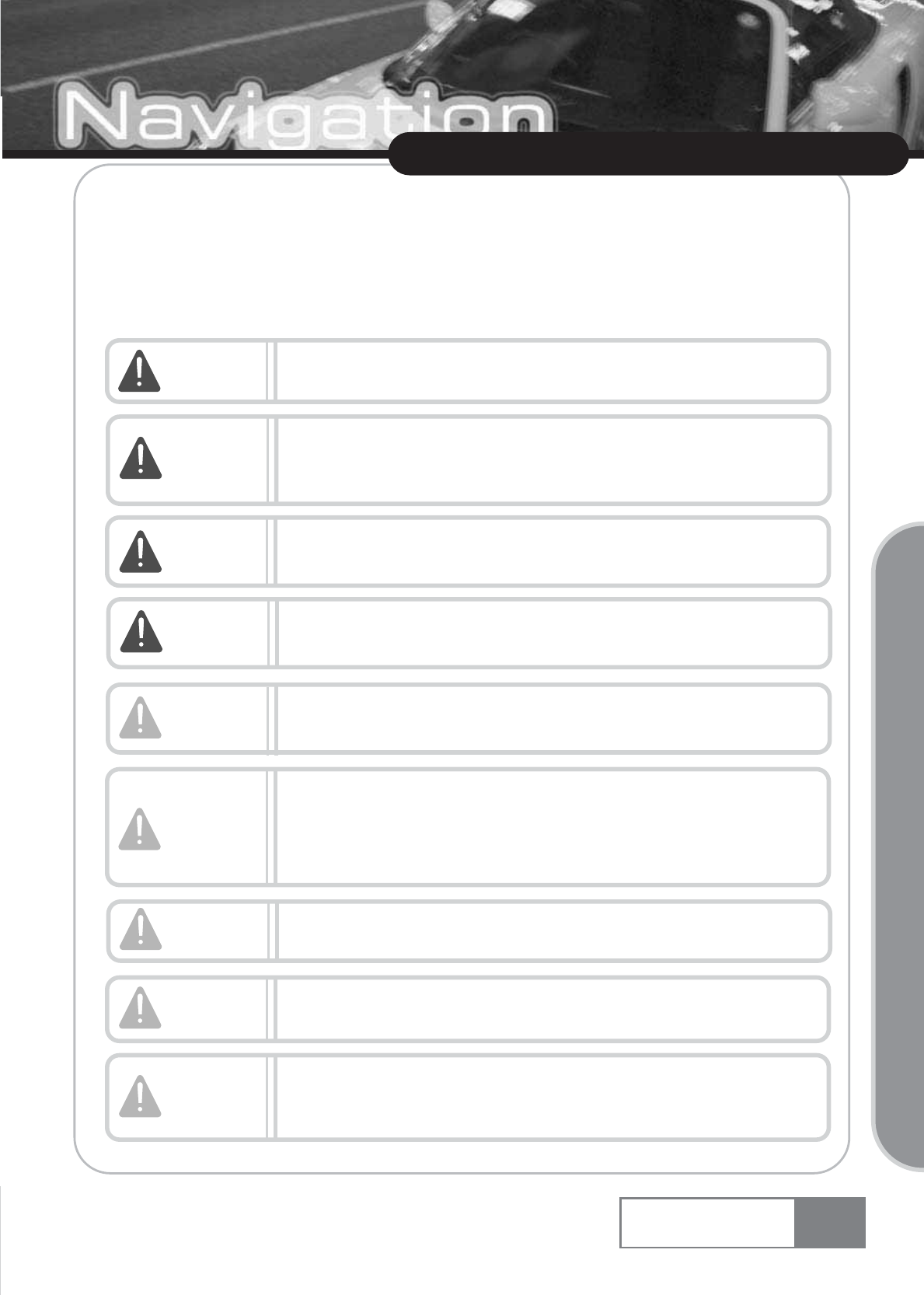
1. Directions before using this product
Read this ŔUserœs Manualŕwithout fail before using this product to use this product safely.
1-1. Usage directions
3
About Navigation System
Navigation System
Warning Refrain from operating the product in motion. Please park the car at a safe
location when operating the product, because there is danger of a traffic accident.
Voice guide and map route can be different from the actual road
condition. Ensure to comply with the actual road signal system and
traffic regulation for safe driving.
Warning If you modify the car to install this system, safe driving can be
endangered.
Caution Do not use this product for a long time after stopping the engine. The car
battery can be discharged completely.
Caution
Do not use other cables than those provided. Turn off the power when
connecting the external cable like A/V input, stereo output, and indoor
TV antenna. If you connect the cable while the power is on, the product
can be damaged.
Caution Do not disassemble or apply shock to this product.
Warning
Caution Touch the touch panel with a round edge object or fingertip softly. If you press the
touch screen strongly with a sharp and hard object, it can damage the product.
Caution
Turn off the power and use the clean and dry cloth when cleaning the
screen. Keep the screen away from water or chemical substance like
detergent or solvent.
Basic Operation
Warning
Navigation system will not be liable for any damages arising out of any use of
this product. The user will bear the sole responsibility.
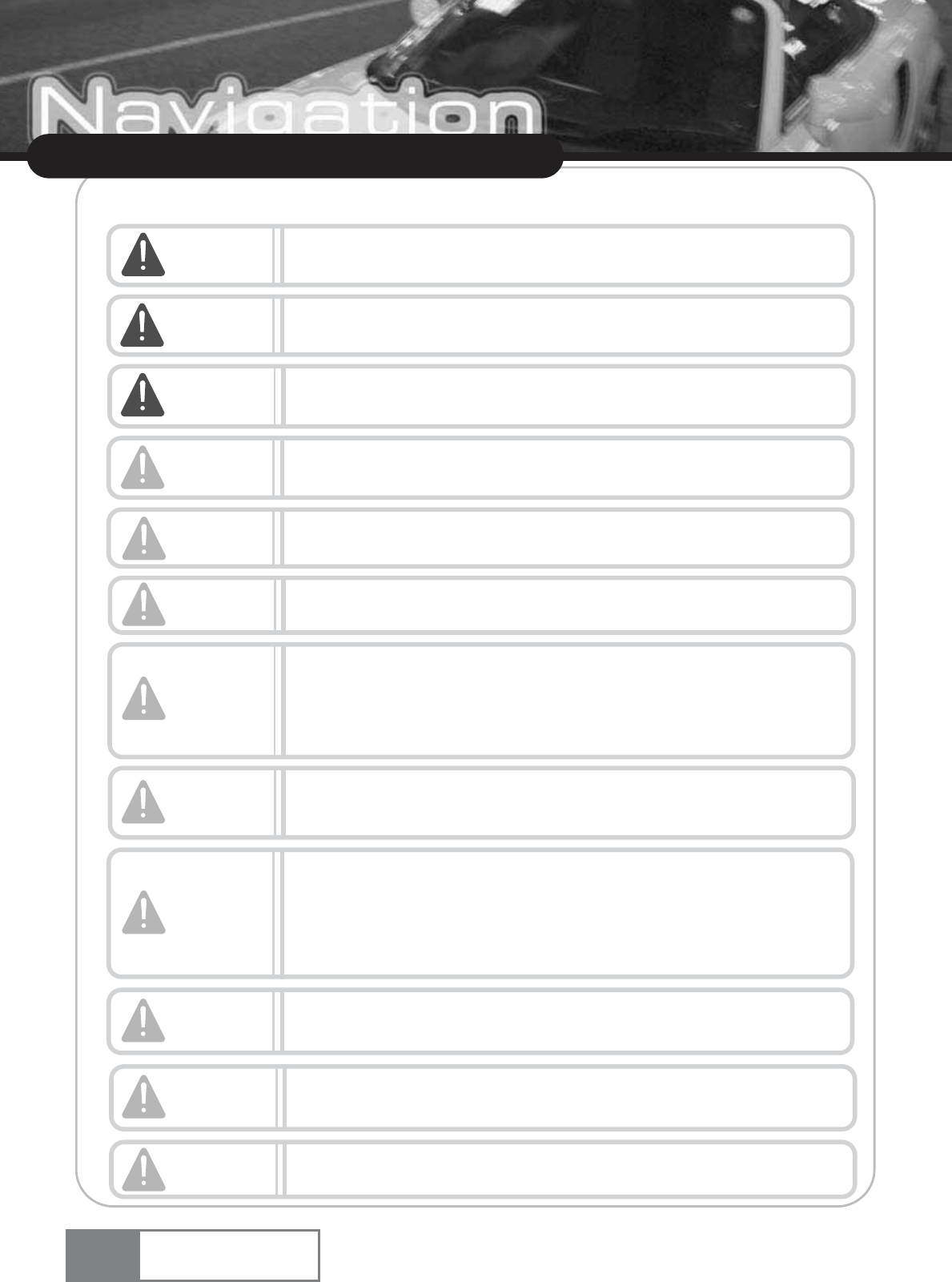
1-2. Installation directions
4
About Navigation System
Navigation System
Warning Connect the wires properly by referring to ŔInstalling productŕsection.
Otherwise, malfunction or accident may occur.
Caution Use only the connection cable for vehicle that was provided at the time
of product purchase to ensure stable system operation.
Warning Do not install the product in a position where driving can be interfered
or driverœs field of vision can be blocked.
Caution This product must be used with 12V car power only. Do not use 24V power.
Caution
Some functions of this system are disabled for driverœs safety when the car is in
motion. Remove the test jack installed in the safety terminal and connect the
hand brake cable to the car hand brake. If this cable is not connected, only
Ŕaudioŕwill be supported in Aux mode.
Caution Connect the Aux cable such as line out or A/V in after turning the power off.
If the power is on while connecting the cable, the product can be damaged.
Caution Do not install the product in a place with water, humidity, vapor, dust, oil, or smoke.
Warning Install the product in a position that does not interfere with driving or
safety devices like an air bag.
Caution
If you donœt use the product for a long time after purchasing this product, car
position sensing time can be prolonged, since the GPS antenna backup battery
can be discharged.
In this case, charge the battery for 2 ~3 hours while using the navigation system.
Caution
Do not put objects that interfere with GPS signal reception around the GPS
receiver. Radio interference may occur.
Caution
Do not install electronic products that generates heavy electromagnetic waves
like a radio transmitter around the GPS antenna.
Caution
GPS reception can be blocked if the car windshield is specially tinted.
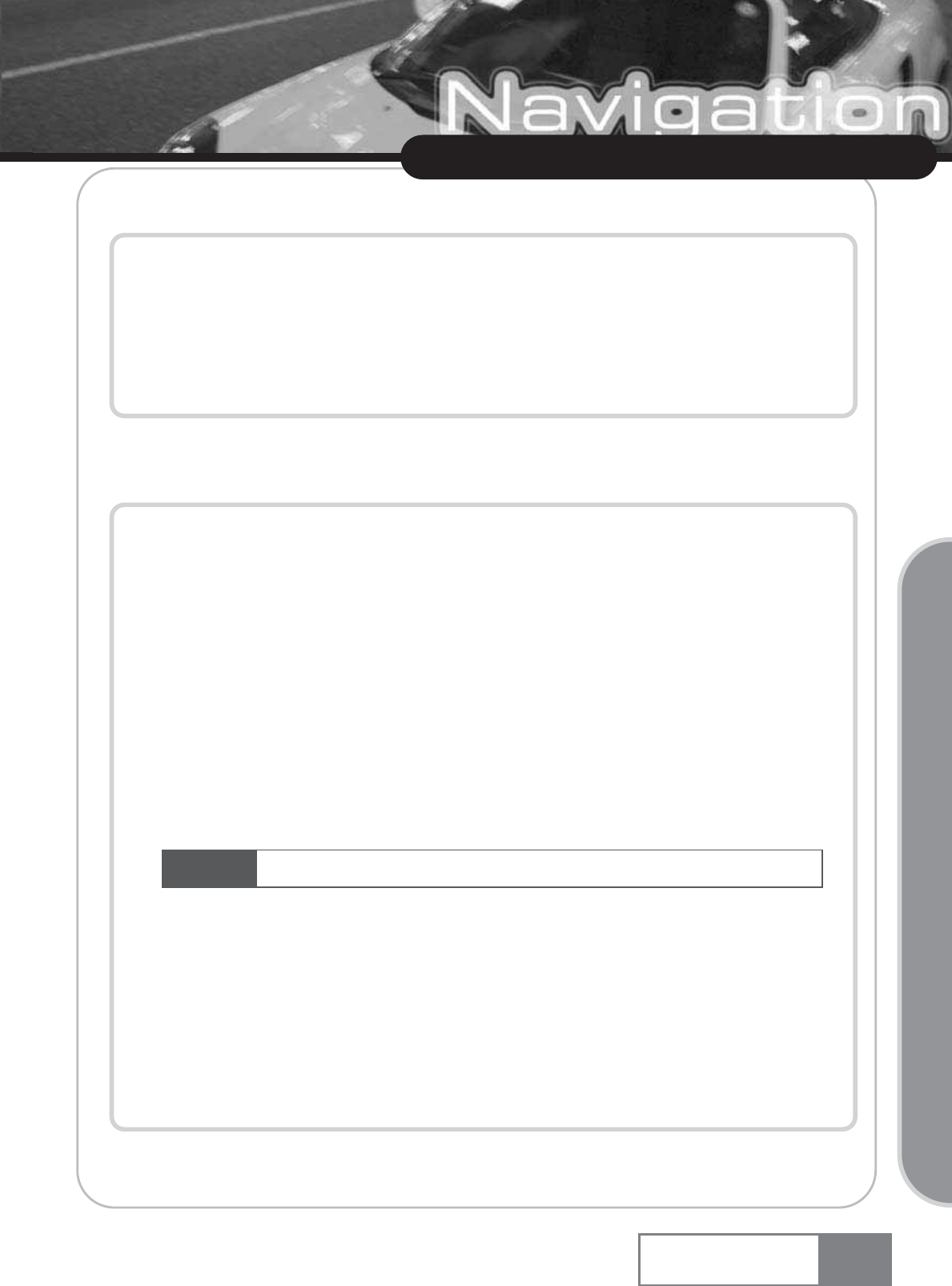
1-3. Upgrade directions
1-4. Troubleshooting
1) Touchscreen does not work
If you cannot set up the touchscreen in the Setup menu due to wrong setting, use the remote
controller instead.
ȘPress the [Initial Screen] button on the remote controller to open the main menu screen.
ȘPress the [SUB-T] ō> [ZOOM] ō> [INFORMATION] ō> [REPEAT] button sequentially
in the DVD box of the remote controller to open the Touch Setting screen.
ȘPress the 5 cross marks using the test jack or touch adjustment rod, according to the
instructions displayed on the screen.
ȘPress the screen once to close the Touch Setting screen.
2) The LED turns on or flashes in red during self-diagnostic:
In addition, when the temperature inside the car is too high or low, the red LED flashes. In this
case, follow the steps below.
ȘTurn the product power off and ventilate the car to get normal temperature.
ȘTurn the power on after a little while and observe the LED color.
ȘIf the red LED still flashes in normal temperature, contact customer service.
5
About Navigation System
ȘDo not connect 12V power when connecting ActiveSync.
ȘDepending on the USB memory product, the USB sensing time may vary or sensing
may fail.
ȘOnly the USB memory with FAT32 format is supported.
Format the USB memory as FAT32 before using it.
Navigation System
Park the car in a safe place for touchscreen setting.
Basic Operation
Caution
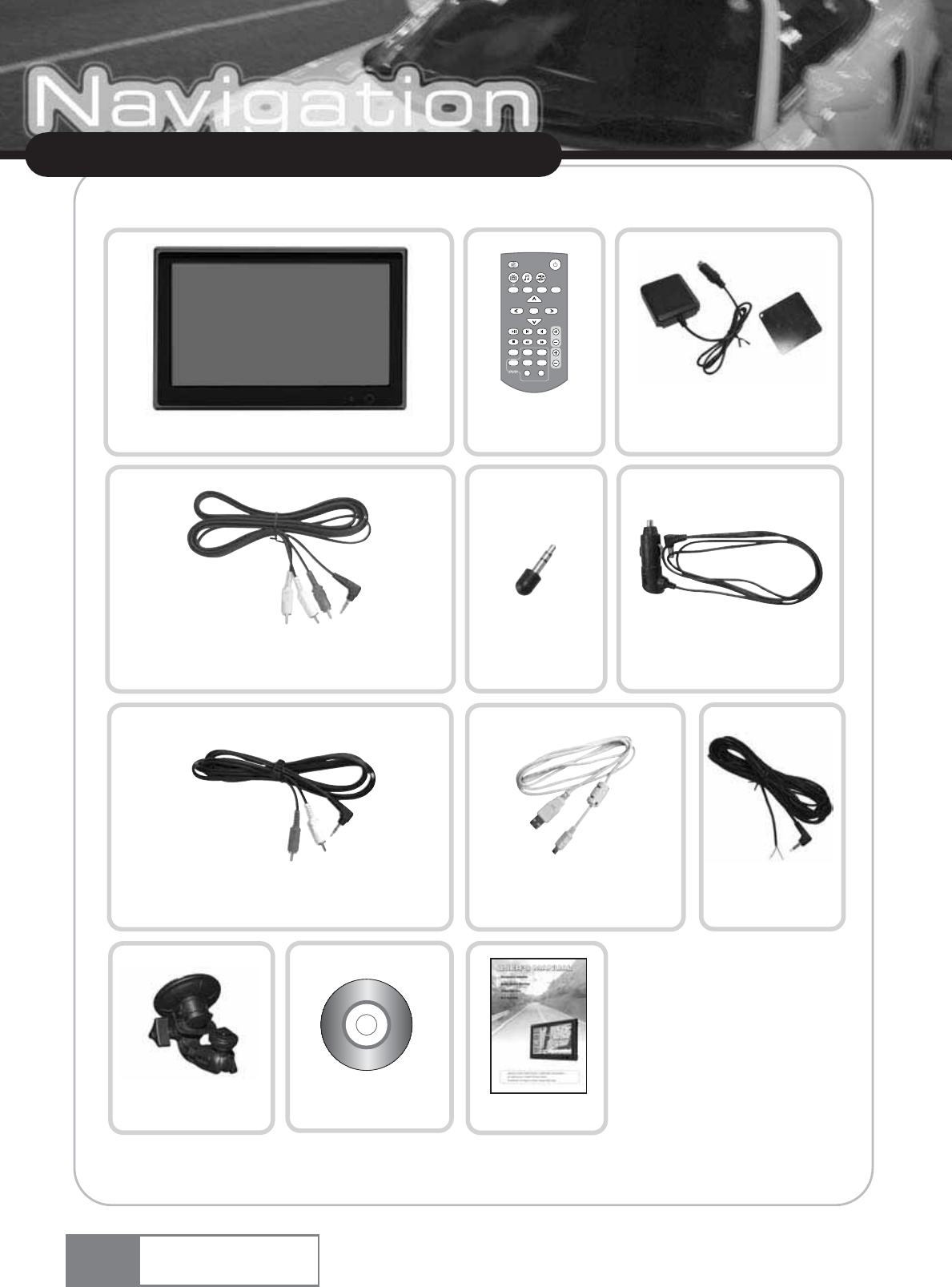
6
About Navigation System
2. Components
MUTE
AUX
MAIN FILE LIST DIMMERCH.SCAN
ENTER
CH
VOL
PLAY TYPE ZOOM
SUB-T LANGUAGE DISPLAY
A-B SETUP
TITLE
SCREEN
OFF
AUDIO
Remote
controller[Option]
Test jack
Navigation System unit
Stereo output cable
[Option] Hand brake
connection cable
USB cable
Suction cap Userœs manual
Navigation System
Red : + : Black
-
GPS antenna/
mount plate
Aux cable(AV In terminal)
[Option] Cigar jack cable
DVD-ROM
ƕSpecifications and design are subject to change without notice.
ƕDVD-ROM includes MAP DB, activesync, usb driver, V-Up Pro, and manual file.
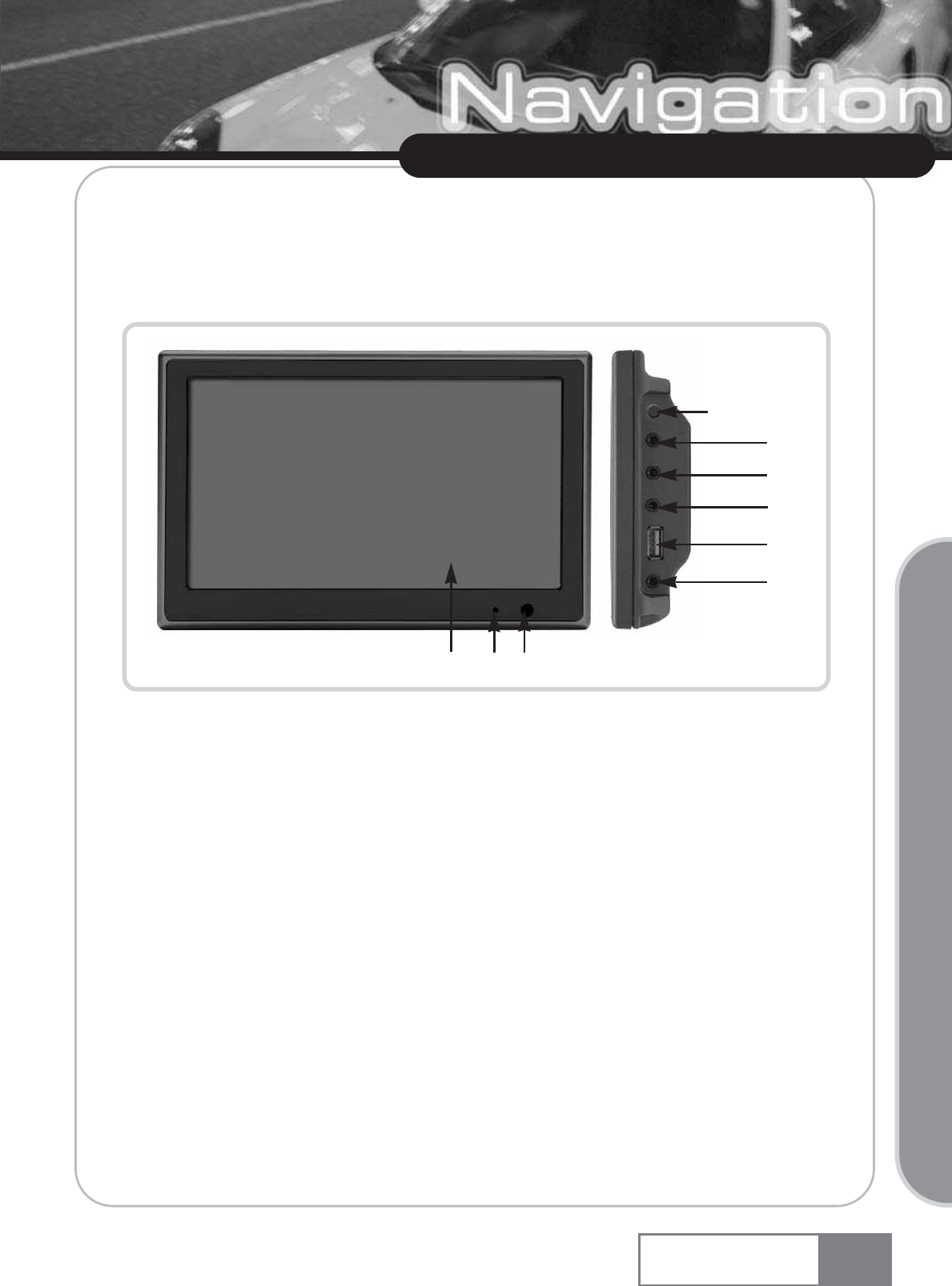
3. Description of external features
3-1. Front/Right side
ڡTOUCH SCREEN : Handles user touch input.
ڢLED : Displays the product status.
(Blue : Normal operation, Red : Malfunction diagnostic)
ڣREMOTE IR WINDOW : Receives the remote control signal.
ڤAUDIO OUT : Output the audio signal to the external device.
ڥAUDIO/VIDEO IN : Receives the A/V input from the external device like a DVD player or
gaming device.
ڦCOMM : Connects to the car DVD player (optional). Controls the DVD player using
the touch screen. (Compatible model : VXM family, VXD)
ڧUSB HOST PORT : Connects to the USB memory. Supports convenient upgrade and MP3
playback function.
ڨSAFETY : Connects to the car hand brake after removing the test jack, which is installed in
advance for safety.
7
About Navigation System
ڤ
ڥ
ڦ
ڧ
ڨ
ڡڢڣ
Navigation System
Basic Operation
Not supported
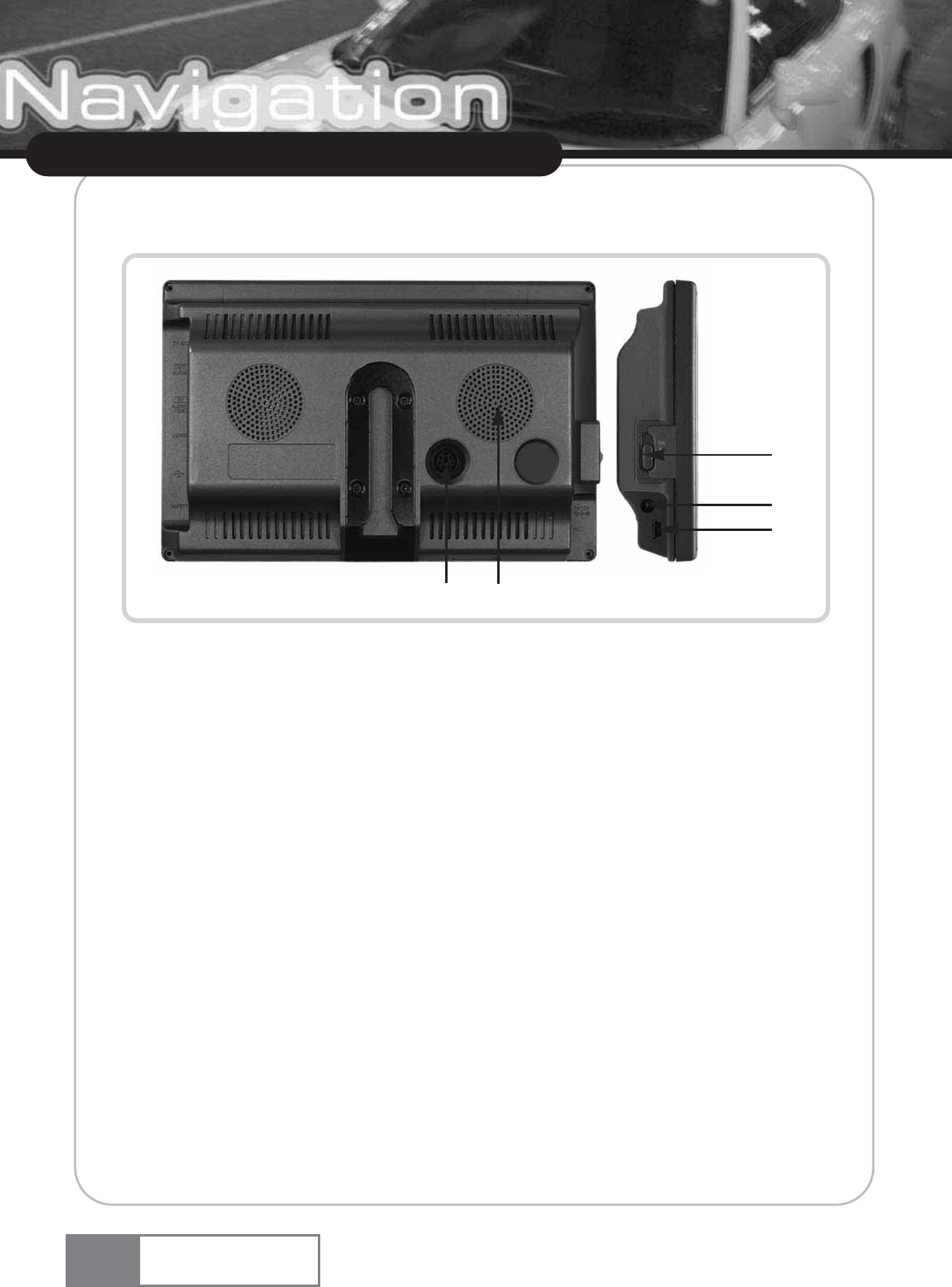
3-2. Rear/Left side
ڡGPS : Connects to the GPS antenna cable.
ڢSPEAKER : Outputs 1 watt audio.
ڣPOWER SWITCH : Turns the power on/off.
ڤDC 12V : Connects to the provided cigar jack.
ڥUSB SLAVE PORT(Activesync Port) : Connects to the PC using the provided USB cable for map
upgrade or background download.
8
About Navigation System
ڣ
ڤ
ڥ
ڡڢ
Navigation System
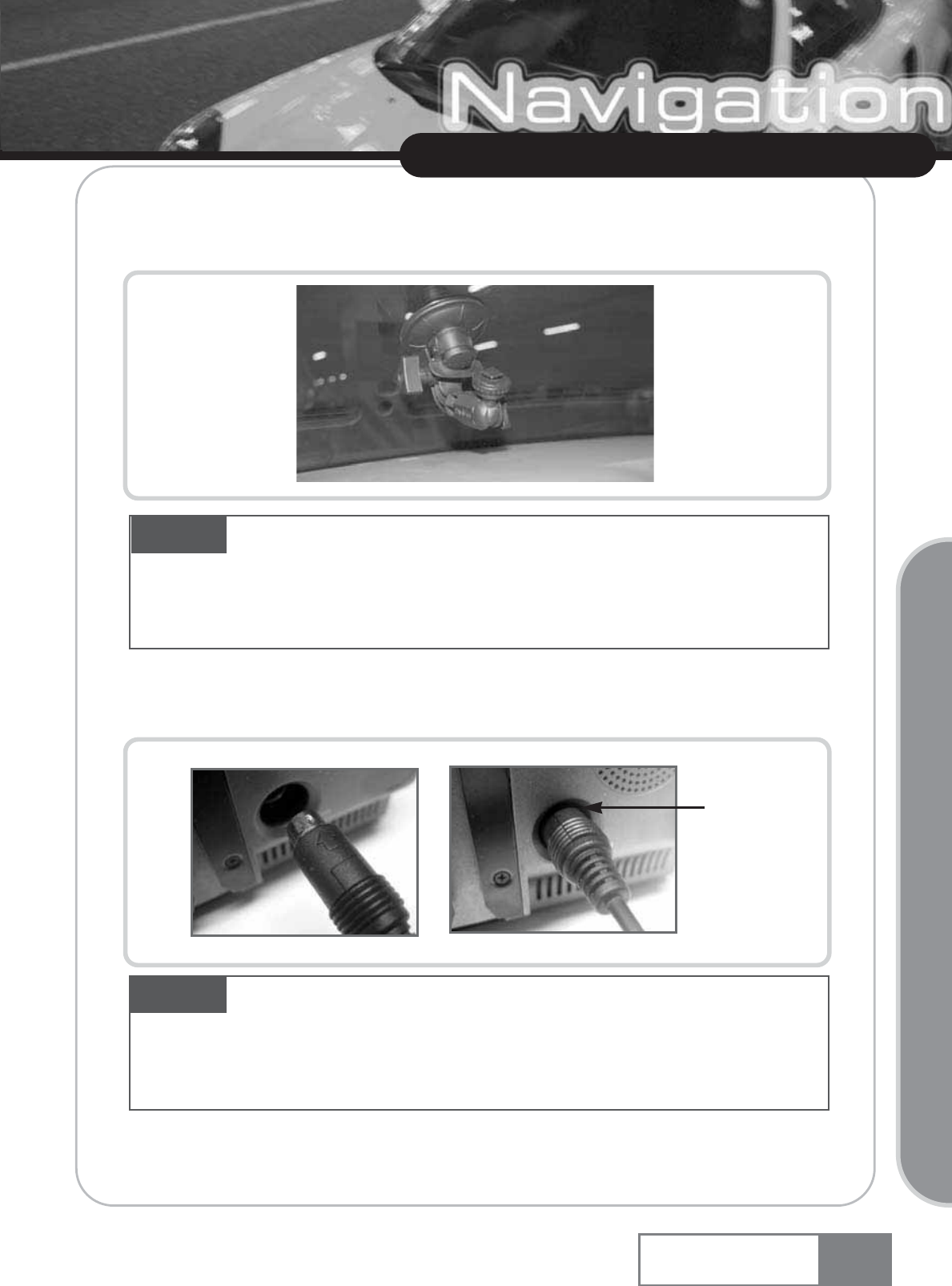
4. Installing the product
1) Fix the suction cup on the car windshield where the driver feels comfortable.
2) Connect the GPS cable to the product.
9
About Navigation System
Caution Remove any dust or foreign object from the windshield so that the suction cup can be
attached firmly. Then, fix it with knob to prevent falling down due to shock.
Do not install the navigation set in a position that hampers driverœs vision or driving. Be careful not to interfere
with driving or safety devices like an air bag.
Caution Plug in the GPS cable as described above.
Install the GPS mount plate in the position that can be exposed to the sky as much as possible for better
GPS reception, and fix the GPS antenna on the GPS mount plate by setting the GPS logo to face upward.
GPS sensitivity will increase if you use the GPS mount plate.
Navigation System
Basic Operation
Connect here
(GPS)
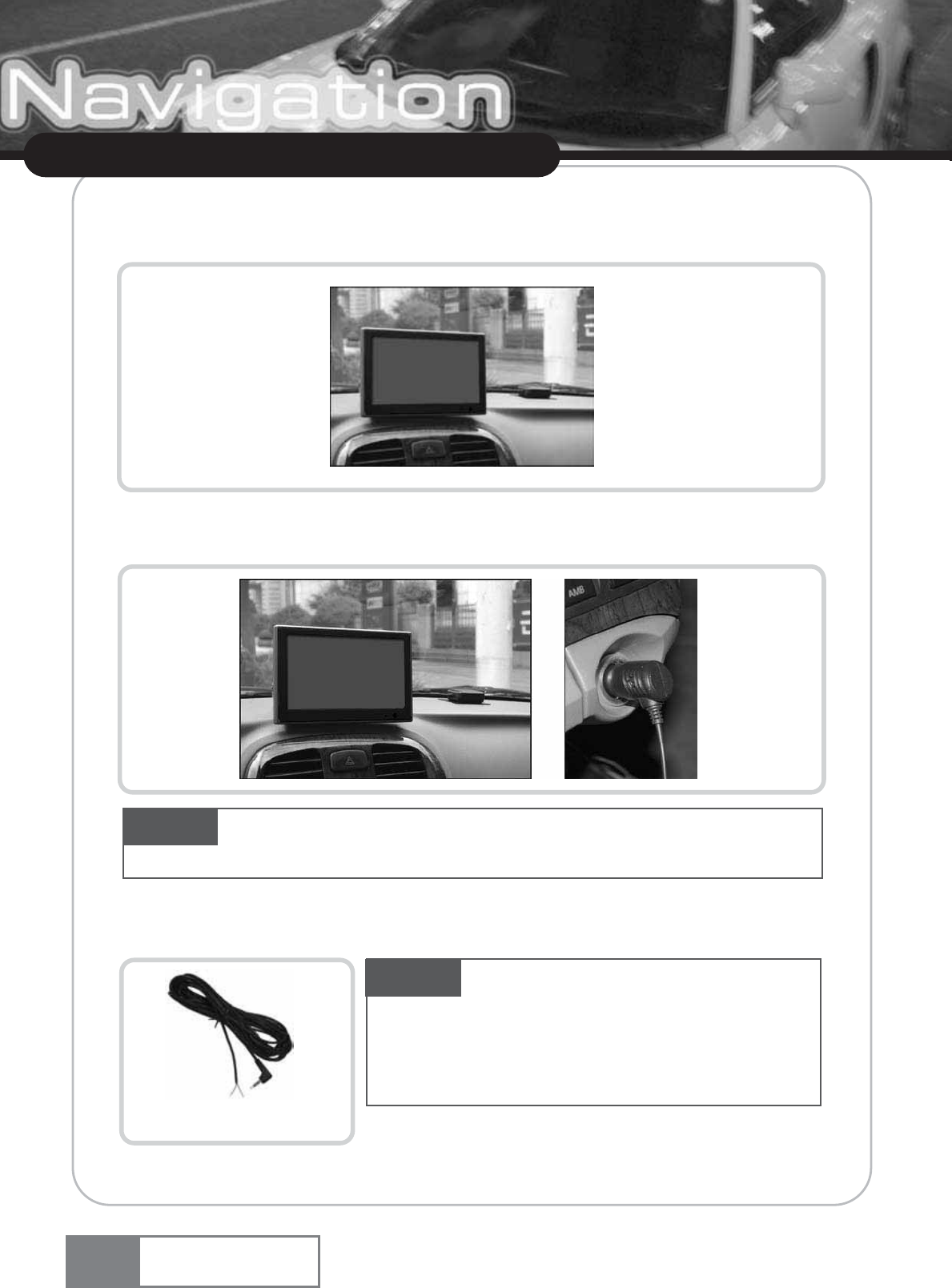
3) Adjust the position to fit into the driverœs field of vision after fixing the product on the
suction cup.
4) Connect the power cable to DC 12V terminal located at the left side of the product.
5) Remove the test jack from the Safety terminal and then, connect the cable to the hand brake.
10
About Navigation System
Caution Use the car cigar jack that is included in the product package. If you use other cigar
jack, the product may not work properly.
Caution Make sure connect the cable to the car hand
brake to prevent operation while in driving. If the hand brake
connection cable is not connected, only Ŕaudioŕexternal input will
be supported.
Navigation System
Red : + : Black
-
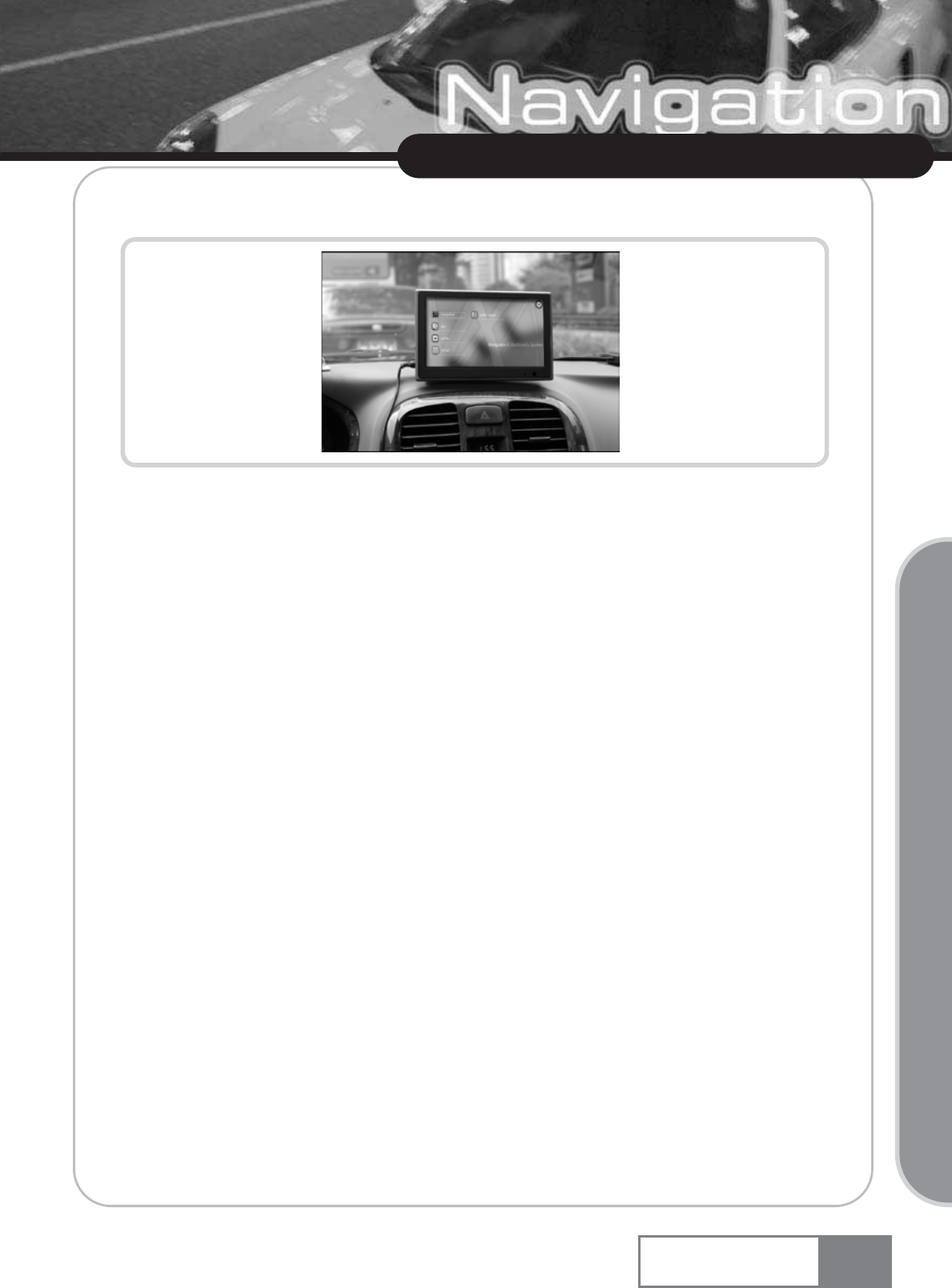
6) Flip the power switch ON that is located at the left side of the product.
1. Basic functions of Navigation System
1) Navigation function : Helps car navigation using GPS (Global Positioning System)
engine and antenna, and electronic precision map.
2) Audio player function : Plays back MP3, WMA, and WAV music file.
3) Game function : Provides enjoyable games.
4) Aux function : Displays external A/V sources such as DVD players or gaming devices. When connected
to a VXM or VXD series DVD player, touch screen controls can be wired to control the DVD player.
5) Setup setting function : Various functions can be configured such as slide show,
background screen, touchscreen setting, volume control, dimmer control, USB upgrade, A/V
input, file deletion.
11
Using Navigation System
Navigation System
Basic Operation
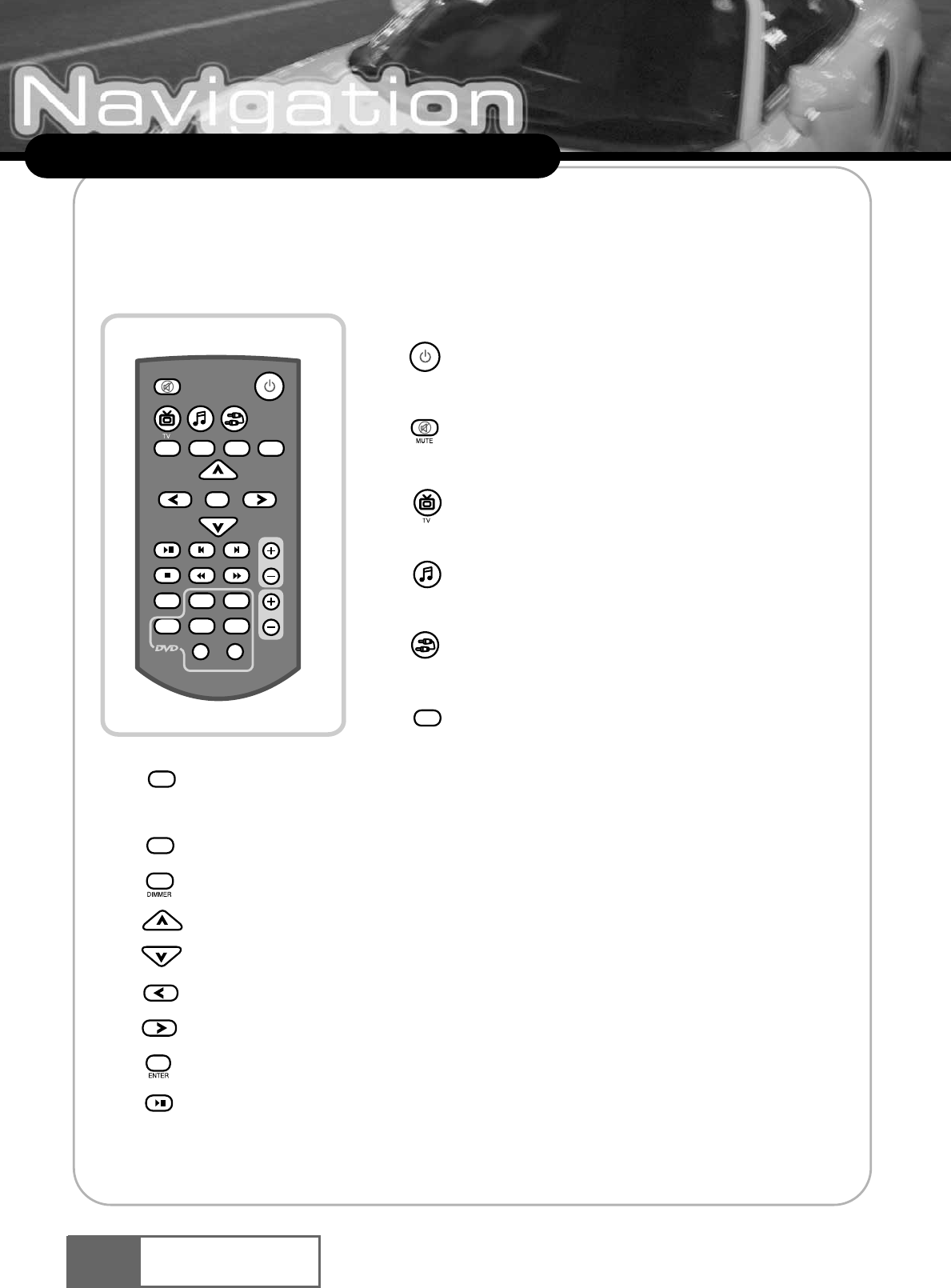
2. Learning basic remote controller functions
You can access frequently used function using the remote controller, in addition to the touch screen
for more convenient usage of Navigation System.
ȯ9Chrok`xrsgdCUCldmtvgdmbnmmdbsdcsnCUCok`xdq+nqsgdok`xkhrshmsgd`tchn
ok`xdqlncd-
ȯ9Rb`mrsgdSUbg`mmdk-ZNoshnm\
ȯ9Bnmsqnkrrbqddmaqhfgsmdrrhm4chrbqdsdkdudkr-
ȯ9Lnudrsgdbtqrnqtov`qc-
ȯ9Lnudrsgdbtqrnqcnvmv`qc-
ȯ9Lnudrsgdbtqrnqkdes-
ȯ9Lnudrsgdbtqrnqqhfgs-
ȯ9Rdkdbsrsgdbtqrnqsg`sv`rlnudcaxsgdchqdbshnmjdx-
ȯ9Ok`xra`bj.O`trdrLO2nqCUCok`xa`bjhmsgd`tchnok`xdq.@twlncd-
ƕCUCbnmsqnktrhmfsgd@twsdqlhm`khrrtoonqsdcnmkxvgdmCUCok`xdqeqnlsghrbnlo`mxhrbnmmdbsdcrtbg`rUWL.UWC-
ȯ9
Stqmrnm.neesgdKBCrbqddm-Unhbdfthcd`mc`tchnok`xa`bj
vhkkbnmshmtddudmvgdmsgdKBCrbqddmhrstqmdcnee-
ȯ9Ltsdrsgdrntmcsdlonq`qhkx-
ȯ9ChqdbskxrvhsbgrsnsgdSUetmbshnm-ZNoshnm\
ȯ9Chqdbskxrvhsbgdrsnsgd`tchnok`xdqetmbshnm-
ȯ9Chqdbskxrvhsbgdrsnsgd@twetmbshnm-
ȯ9Chqdbskxrvhsbgdrsnsgdhmhsh`krbqddm-
12
About Navigation System
Navigation System
AUX
MUTE
AUX
MAIN FILE LIST DIMMERCH.SCAN
ENTER
CH
VOL
PLAY TYPE ZOOM
SUB-T LANGUAGE DISPLAY
A-B SETUP
TITLE
SCREEN
OFF
AUD IO
SCREEN
OFF
AUD IO
MAIN
FILE LIST
CH.SCAN
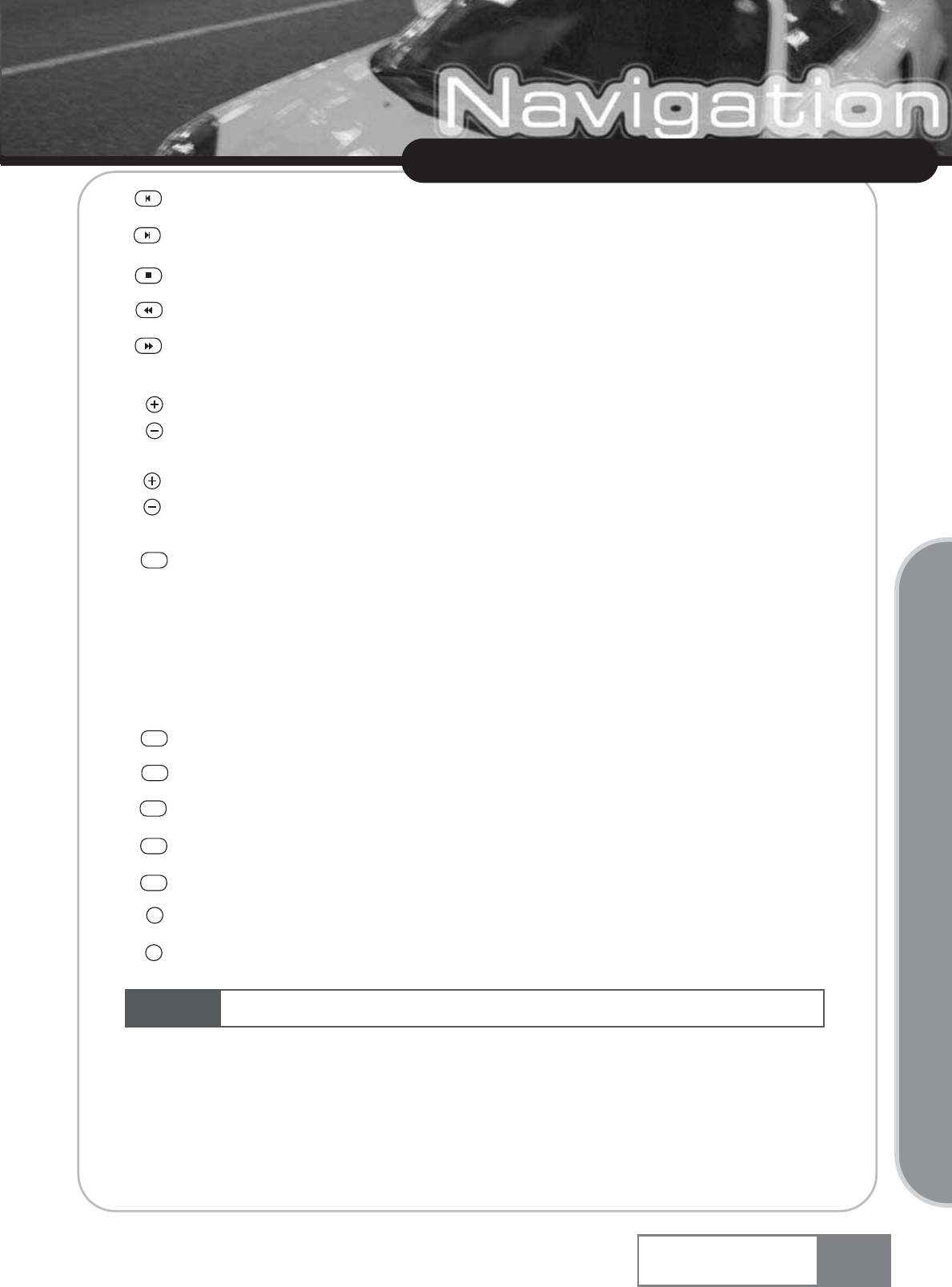
Ș: Moves MP3 or DVD playback section backward in the audio player/Aux mode.
Ș: Moves MP3 or DVD playback section forward in the audio player/Aux mode.
Ș: Pauses MP3 or DVD playback in the audio player/Aux mode.
Ș: Rewinds MP3 or DVD playback in the audio player/Aux mode.
Ș: Fast forwards MP3 or DVD playback in the audio player/Aux mode.
Ș: Sets channel up or down in TV mode. [Option]
Ș: Sets volume up or down.
Ș: Sets Repeat All/Repeat Start when playing back DVD, or Repeat All/Repeat
Selected/Random Selection when playing back MP3.
[Following functions are enabled only when DVD player from this company is connected.]
Ș: Zooms in/out the DVD screen.
Ș: Displays the DVD title.
Ș: Selects the caption in the DVD.
Ș: Selects the sound type provided by the DVD.
Ș: Displays DVD player information.
Ș: Repeats the section in the DVD.
Ș: Displays the configuration screen of VXM/VXD DVD player.
13
Using Navigation System
Caution Navigation and game functions are not accessible using the remote controller.
Navigation System
Basic Operation
VOL
PLAY TYPE
ZOOM
TITLE
SUB-T
LANGUAGE
DISPLAY
A-B
SETUP
CH
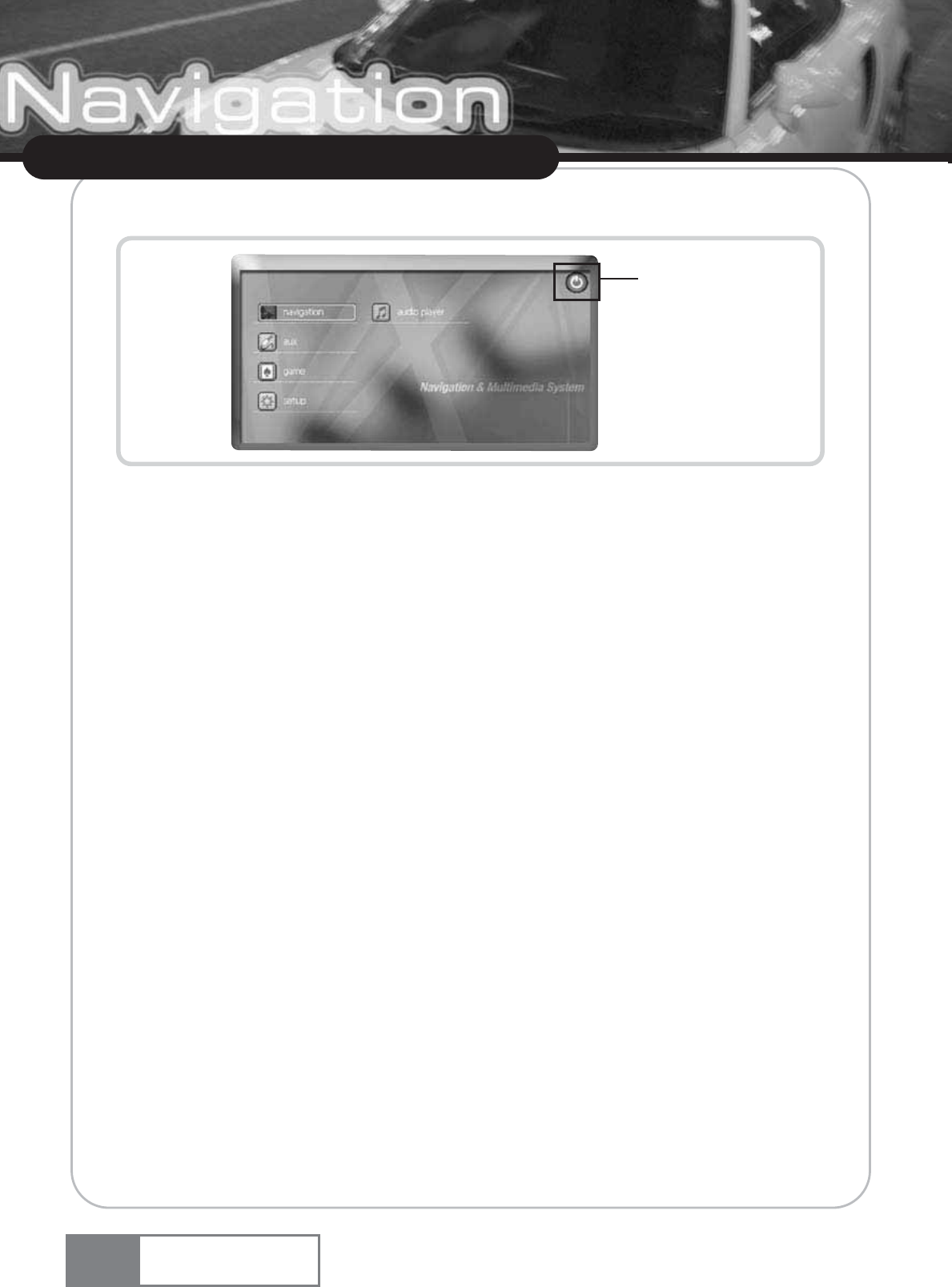
3. Main menu
The main menu is composed of Navigation, Audio Player, Game, Aux, Setting, and Screen On/Off
button.
4. Quick Start
This section will walk you through using your Personal Navigation Device for the first time,
acquainting you with the basic operation of the navigation system.
ҶSwitch on the unit and tap on NAVI or NAVIGATION in the first screen.
ҶIf more than one language is available on your device, you are prompted to choose your
language.
After the application loads, a screen with safety precautions will be shown. Please read them
carefully. Afterwards, you can choose to hide these notes for future start-ups.
You will be presented an earth view of your country. Please enjoy while you fly over your country
and touch down on your current location. (You can also choose to skip this intro by tapping on
the screen.)
At the end of your journey, the start screen will be shown.
14
Using Navigation System
Screen on/off
Navigation System
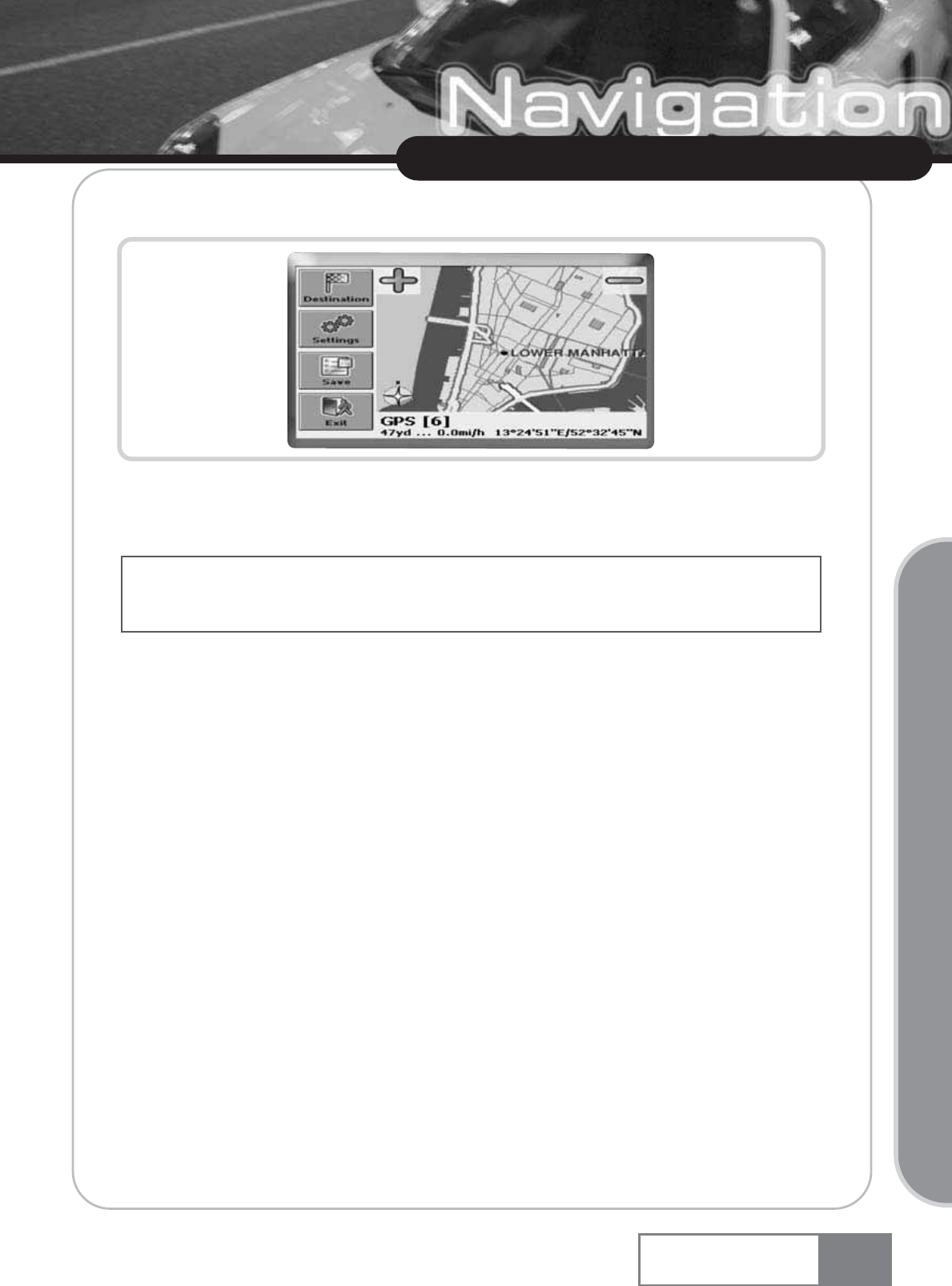
4-1. Start Screen
The start screen is split in two. On the left hand you will find the menu buttons, on the right you see
a map with your current GPS position.
With the buttons on the start screen you access all functions of the application:
ҶPress Destination to choose your destination.
ҶPress Settings to adjust the application to suit your needs.
ҶPress Save to save your current position.
ҶPress Exit to quit the application.
On the bottom of the start screen, the following information will be shown:
Ҷyour GPS status
Ҷthe number of satellites the system is tracking
Ҷthe name of the current street
Ҷyour speed
Ҷyour elevation above mean sea level
15
Using Navigation System
Navigation System
Basic Operation
It is not possible to browse the map in the start screen. This screen merely shows your current GPS position,
provided that you have a GPS connection.
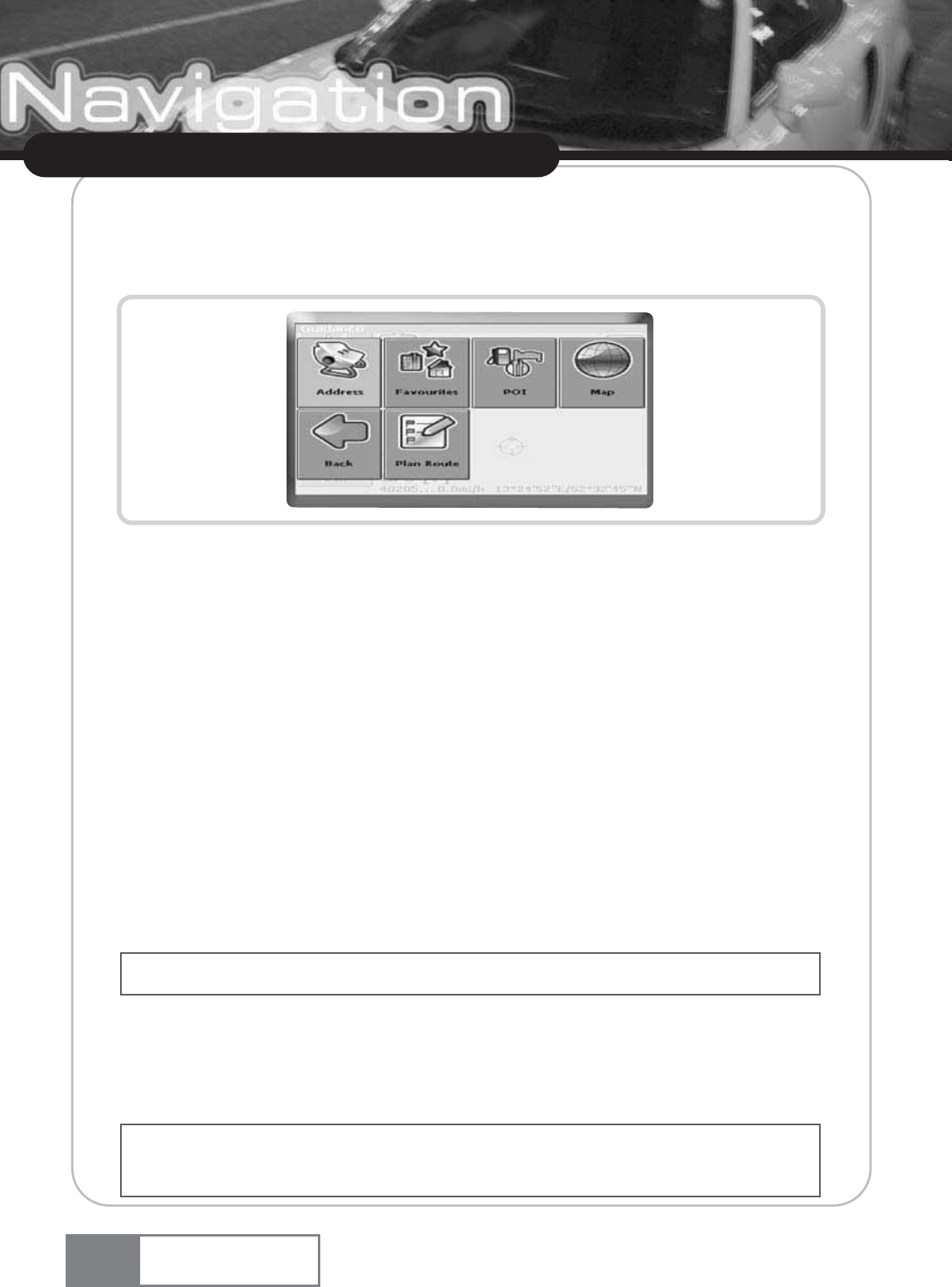
4-2. Choose a destination
ҶSelect Destination to set your destination.
A menu will open where you can choose a destination:
You have various ways to select your destination:
Address: If you know the city and street address for your destination, simply enter it and the
application will guide you directly there. (See Address Search on page 19.)
Favorites: Through Favorites you can choose to be guided to your home address (My Home) or
work address (My Work), select a previously saved location (Bookmarks) or a recently visited place
(Recent). (See Favorites on page 22.)
POI: (Points of Interest): Through POI you can quickly find points of interest like gas stations and
restaurants and choose them for navigation. Those POIs are chosen from a database of millions of
POI, either nearby or at a remote location. You can also search branded travel/city Guides, which
contain loads of valuable information about attractions, restaurants, hotels, etc. with detailed
descriptions. (See POI/Guides on page 25.)
Map: Another way of choosing your destination is selecting it on the Map. (See Map on page 29.)
Plan Route: By selecting Plan Route you switch to the advanced route planning options. There you
may plan your route by choosing multiple stopovers. (See Plan your Route on page 31.)
16
Using Navigation System
Navigation System
Guides are an optional feature and may be purchased at customer service web site(please, see page 81).
With the back and forward arrows you may always step one level back/forward throughout the whole
application.
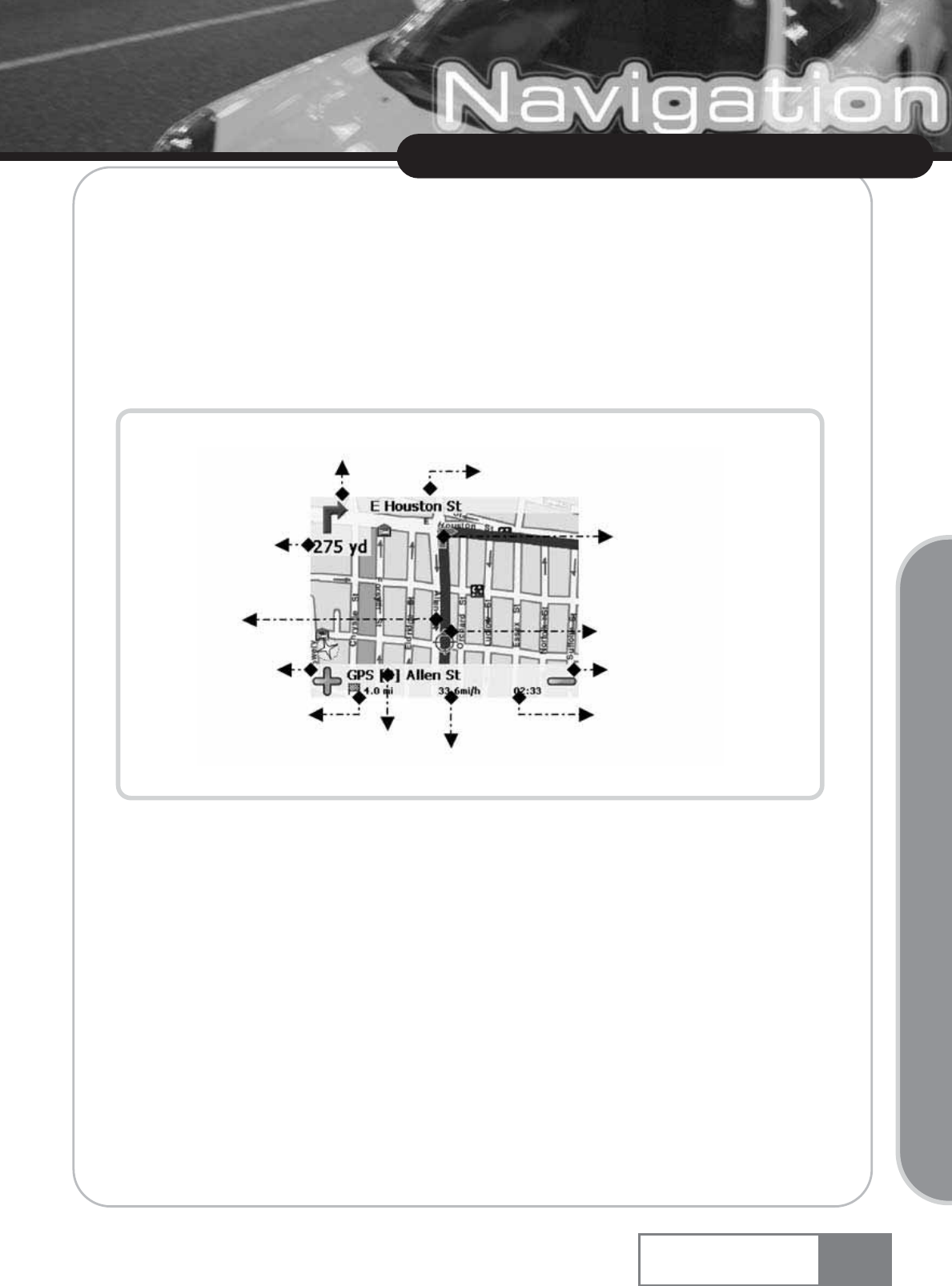
4-3. Navigation Screen
On the navigation map, the route will be shown in blue. The red arrow will indicate the direction of
your next maneuver. Crosshairs identify your current position. When you come up to a turn or other
maneuver, you will hear a voice command at the appropriate time.
For one-way streets, the transit direction is indicated with a red arrow.
17
Using Navigation System
Navigation System
Basic Operation
Current speed
Next junction/exit no.
Direction
Current position
Zoom out
Remaining time to
destination
Manoeuvre icon
Distance to next
manoeuvre
Current Street
Distance to
destination GPS info
Zoom in
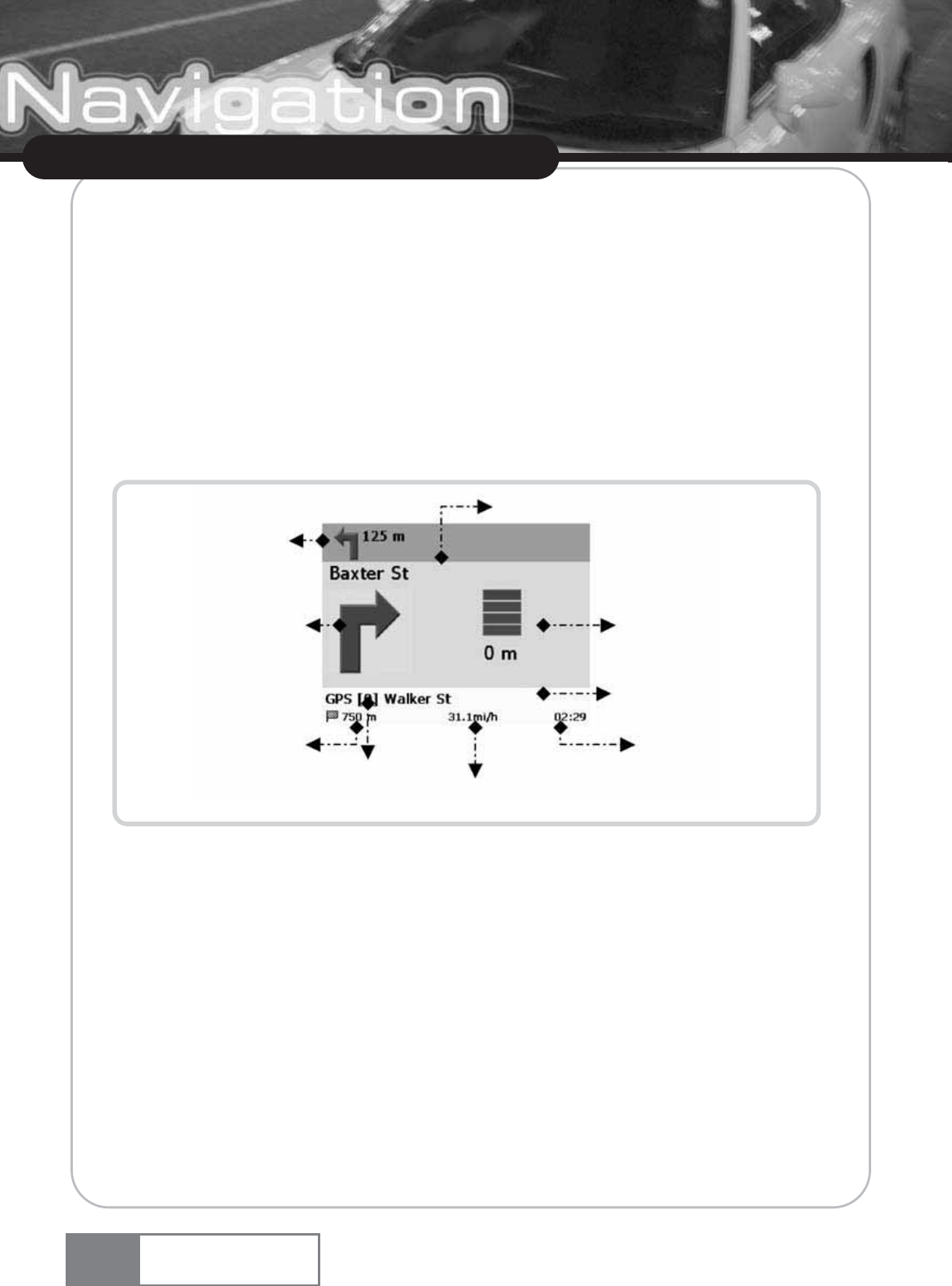
Arrow mode
You can choose to display the navigation screen in a simpler mode, the so called arrow mode. In
this mode, only the most essential information will be shown — like arrows, street names, speed and
time information.
ҶTap on the screen during navigation to open the navigation options (see Change settings
during navigation on page 36).
ҶChoose Settings.
ҶChoose the Arrows/Map symbol to switch between map and arrow modes.
18
Using Navigation System
Navigation System
Current speed
Next junction/exit no.
Distance to next street
Current Street
Remaining time to
destination
Distance to next
manoeuvre
Manoeuvre icon
Distance to
destination GPS info
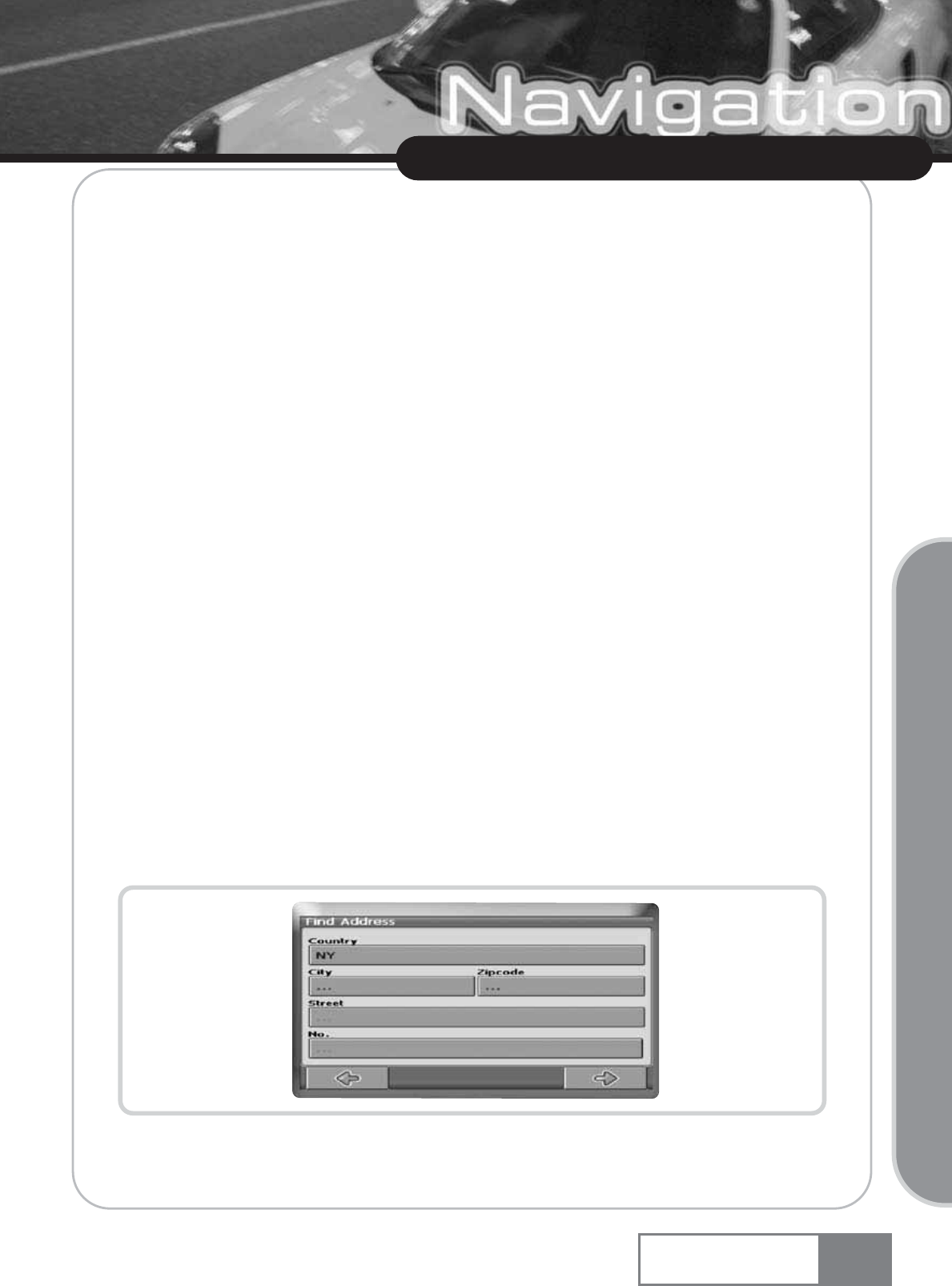
5. Detailed Description
This chapter describes the functions of your Personal Navigation Device in detail. On the following
pages you will learn how to
- Choose your destination (see page 19)
- Plan your route (see page 31)
- Configure the application (see page 34)
5-1. Choose your Destination
This section describes the different ways of setting your destination. You may search for an address,
choose a favorite (like home and work address, your bookmarks and recently visited locations),
browse through POI lists and guides and choose an address on the map.
Address Search
Through the address search you can perform a search by entering information about the desired
target (street and town/city). You may then select a hit from the hit list and start navigating.
ҶOn the start screen, choose Destination.
ҶOn the following screen, choose Address.
The Find Address window will show in the display:
19
Using Navigation System
Navigation System
Basic Operation
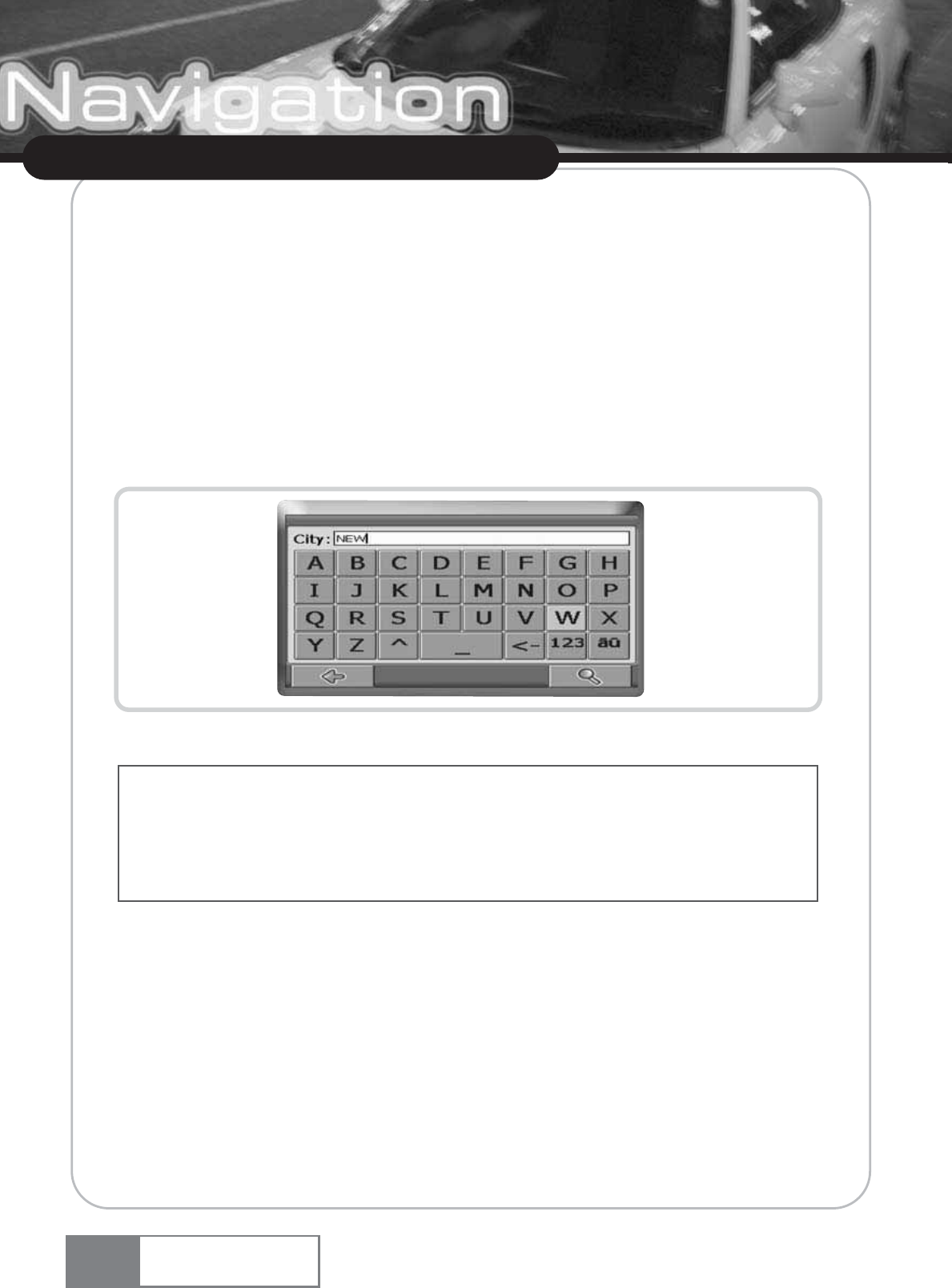
Enter the appropriate data to find your address.
Set the State
ҶPress State to select your state.
ҶChoose your state from the list.
The State field will be populated with the name of the chosen state.
Search for the city
ҶPress City to select your city.
The keypad screen will show on the screen:
ҶEnter the name of the town/city you are looking for (at least three characters).
ҶPress the search symbol (magnifying glass).
A hit list will be displayed.
ҶChoose the appropriate town/city from the list.
You will return to the Find Address screen. The City field will be populated with the name of the
chosen town/city.
Search for the zip code
Instead of the city you may also enter the zip code.
20
Using Navigation System
Navigation System
Switch between letter and number mode by pressing 123 or ABC. Switch between upper case and lower
case by pressing ^.
If at any point you want to backspace and delete characters, press the backspace button <- on screen. To
add a space, press the space bar _.
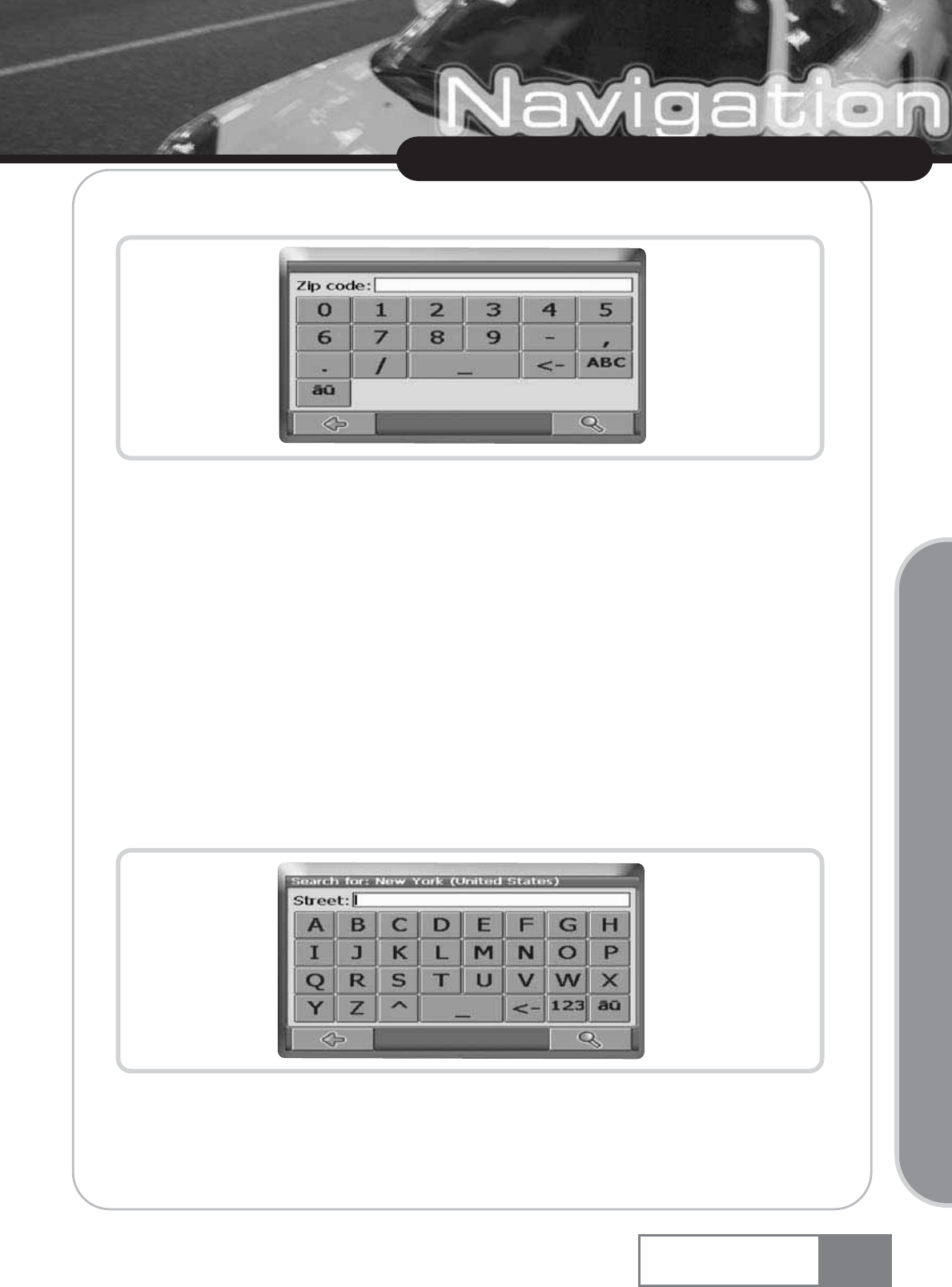
ҶPress Zip code to enter a zip code.
ҶEnter the zip code of the town/city you are looking for.
ҶPress the search symbol (magnifying glass).
A hit list will be displayed.
ҶChoose the appropriate town/city from the list.
You will return to the Find Address screen. The City and Zip code fields will be populated with the
chosen city/zip code.
Search for the street
Once you have found the city or zip code you are ready to look for the street name.
ҶPress Street to enter a street.
21
Using Navigation System
Navigation System
Basic Operation
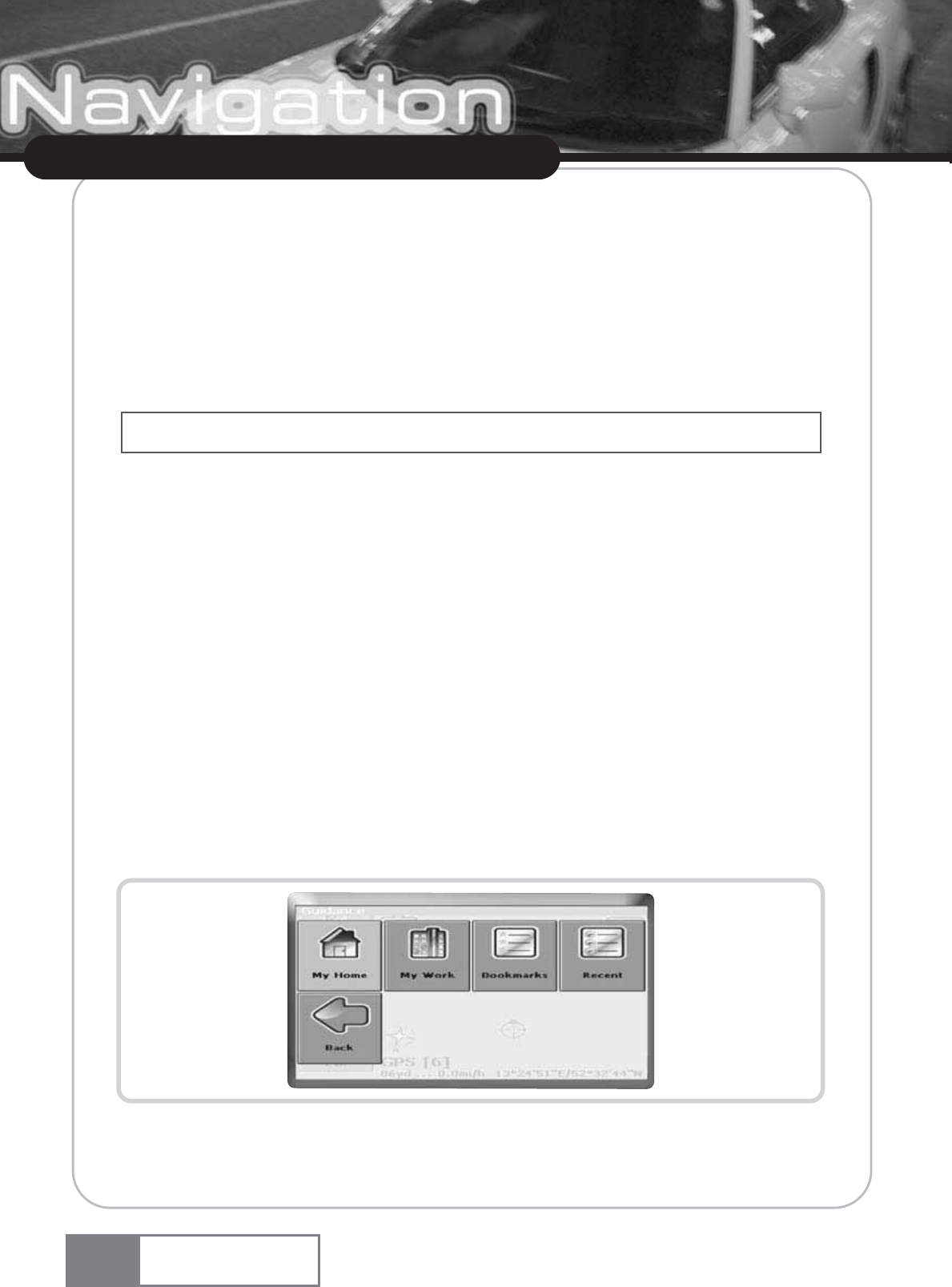
ҶEnter the name of the street you are looking for (at least three characters).
ҶPress the search symbol (magnifying glass).
A hit list will be displayed.
ҶChoose the appropriate street from the list.
You will return to the Find Address screen. The name of the chosen street will be shown in the Street
field.
Navigate to the address found
Once you have narrowed down your search to a unique address, you can start navigation.
ҶPress the forward arrow.
Navigation will start immediately.
Favorites
Use your frequently used or favorite destinations for guidance. You can choose among your home,
your work place, a set of personal bookmarks, and recently visited locations.
ҶOn the start screen, choose Destination.
ҶOn the following screen, choose Favorites.
The Favorites menu will show on the screen:
22
Using Navigation System
Navigation System
Additionally you may enter the number.
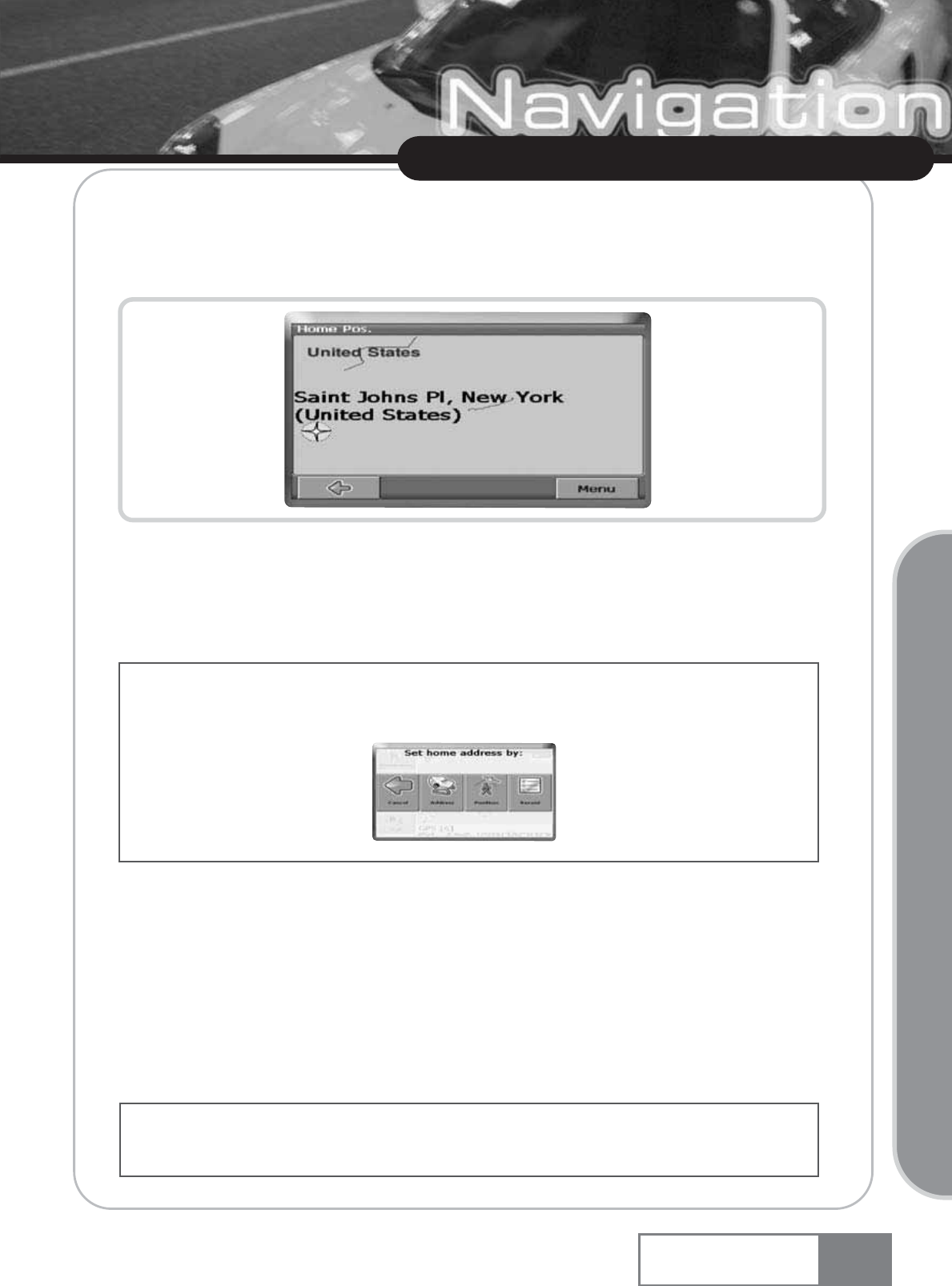
23
Using Navigation System
Navigation System
My Home
ҶPress My Home.
Your home address will be displayed on a map:
ҶChoose Menu.
ҶOn the following screen, choose Navigate to be guided to your home address (press Change
or Delete if you want to change/delete your home address).
Navigation will start immediately.
My Work
ҶBy pressing My Work, your work address will be displayed on a map.
ҶChoose Menu.
ҶOn the following screen, choose Navigate to be guided to your work address (press Change
or Delete if you want to change/delete your work address).
Navigation will start immediately.
Basic Operation
If no home address has been set, you are prompted to do so. You can choose it by searching for an
address, through your current GPS position or by choosing a recently visited location.
If no work address has been set, you are prompted to do so. You can choose it by searching for an
address, through your current GPS position or by choosing a recently visited location.
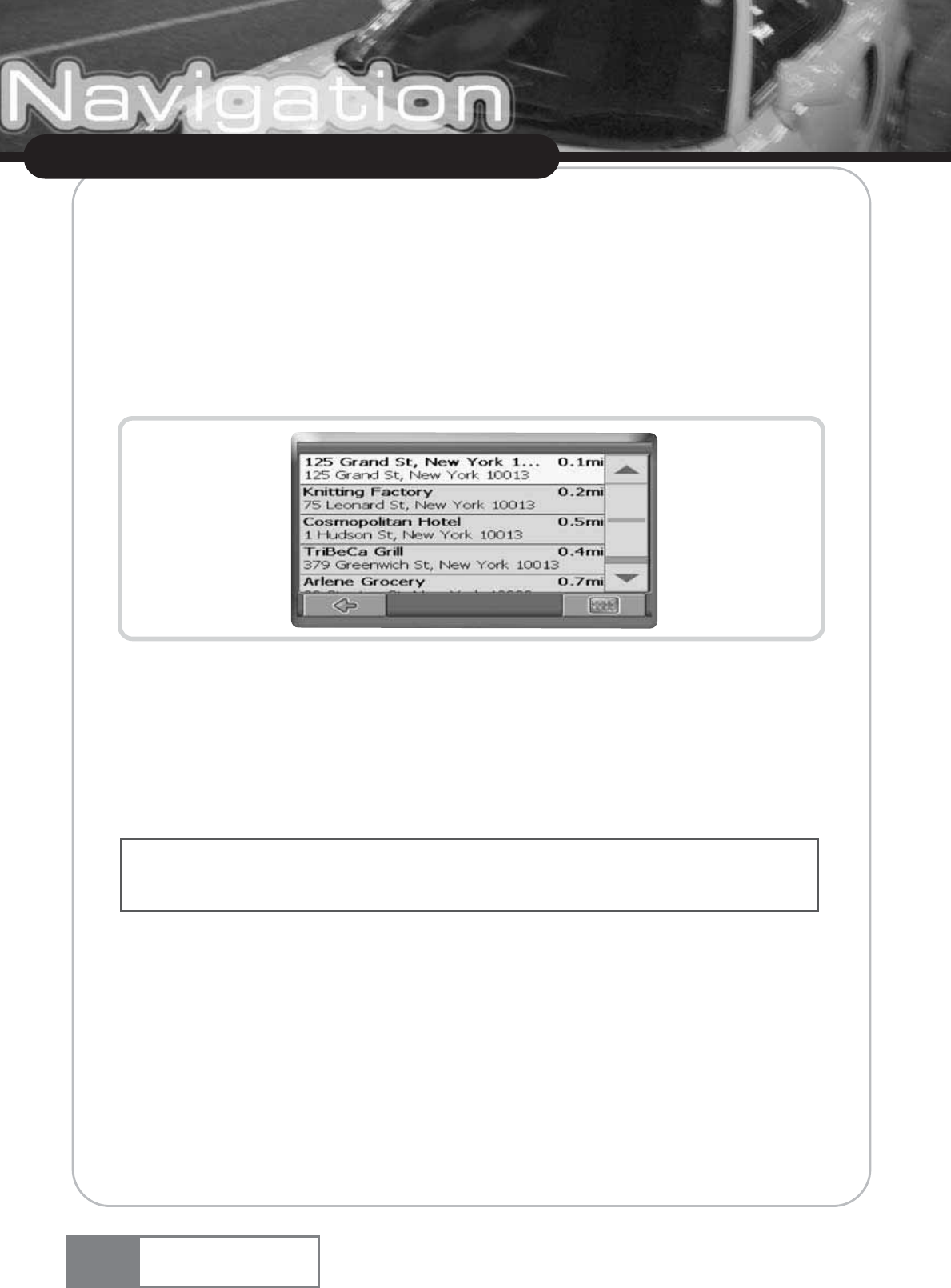
Bookmarks
The bookmarks list contains the destinations you have saved as favorites (from the guides, by
choosing it on a map, etc.). This means that you do not need to perform repeated searches for those
destinations.
ҶPress Bookmarks.
The bookmark list will show on the screen:
Use the up and down arrows to scroll up and down in the list.
ҶSelect an item by clicking on it.
ҶOn the following screen, choose Navigate to be guided to your bookmark (press Rename or
Delete if you want to rename/delete your bookmark).
Navigation will start immediately.
Recent
By pressing Recent a list of recently visited or looked-up destinations will be opened.
ҶPress Recent.
The list of recent items will show on the screen:
24
Using Navigation System
Navigation System
All user information like e.g. settings, bookmarks and recently visited locations will be stored on the
memory card and not on the device.
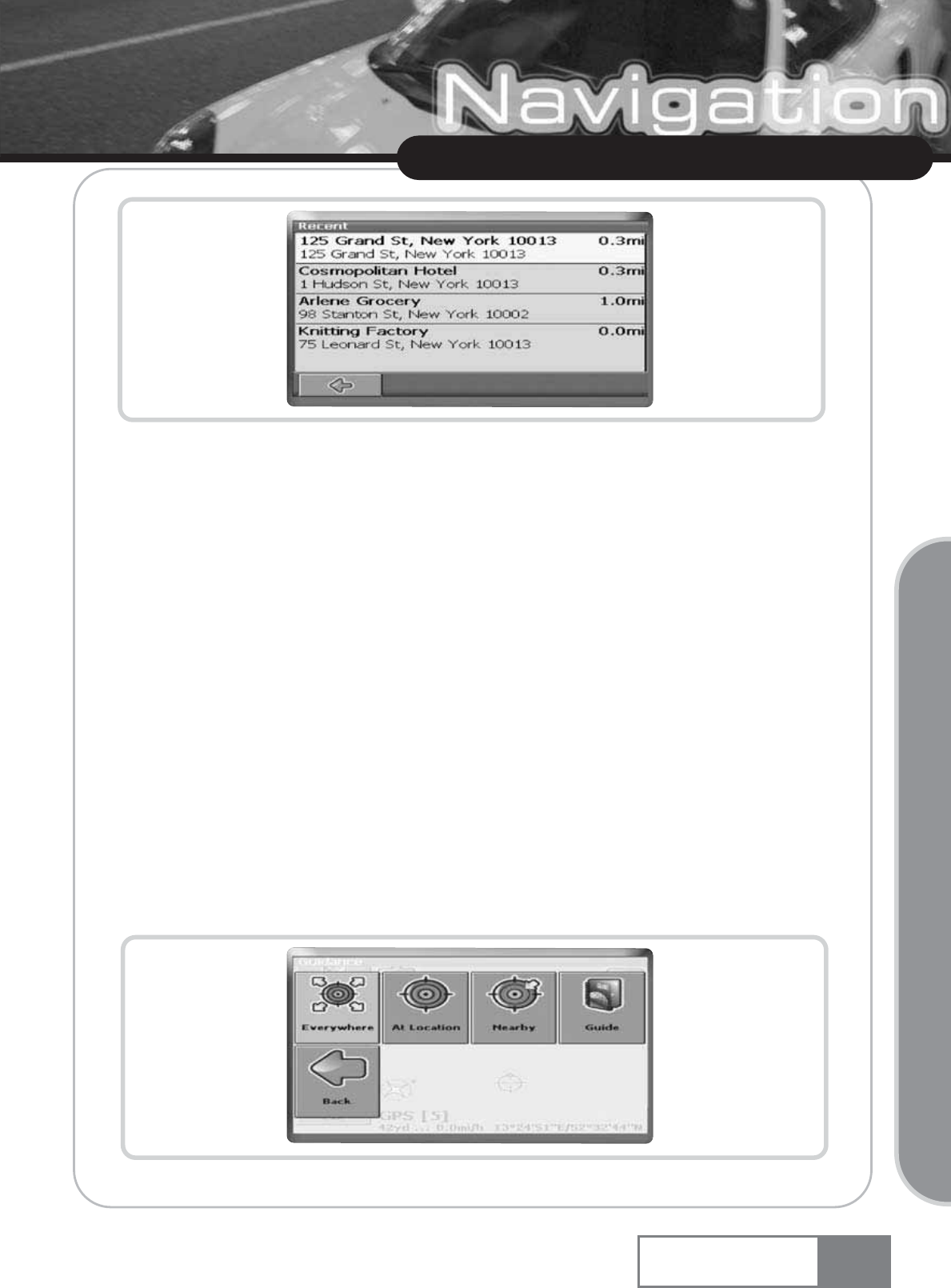
25
Using Navigation System
Navigation System
Use the up and down arrows to scroll up and down in the list.
ҶSelect an item by clicking on it.
Navigation will start immediately.
POI/Guides
With the POI finder you can quickly find points of interest like gas stations and restaurants that are
chosen from a database of millions of POI, either nearby or at a remote location.
Within the POI menu you will see the guides, an optional and highly recommendable feature.
Branded travel/city guides will help you to find out what is nearby and will give you valuable
information about attractions, restaurants, hotels, etc. with detailed descriptions.
POI/Guides
ҶOn the start screen, choose Destination.
ҶOn the following screen, choose POI.
The POI menu will show on the screen:
Basic Operation
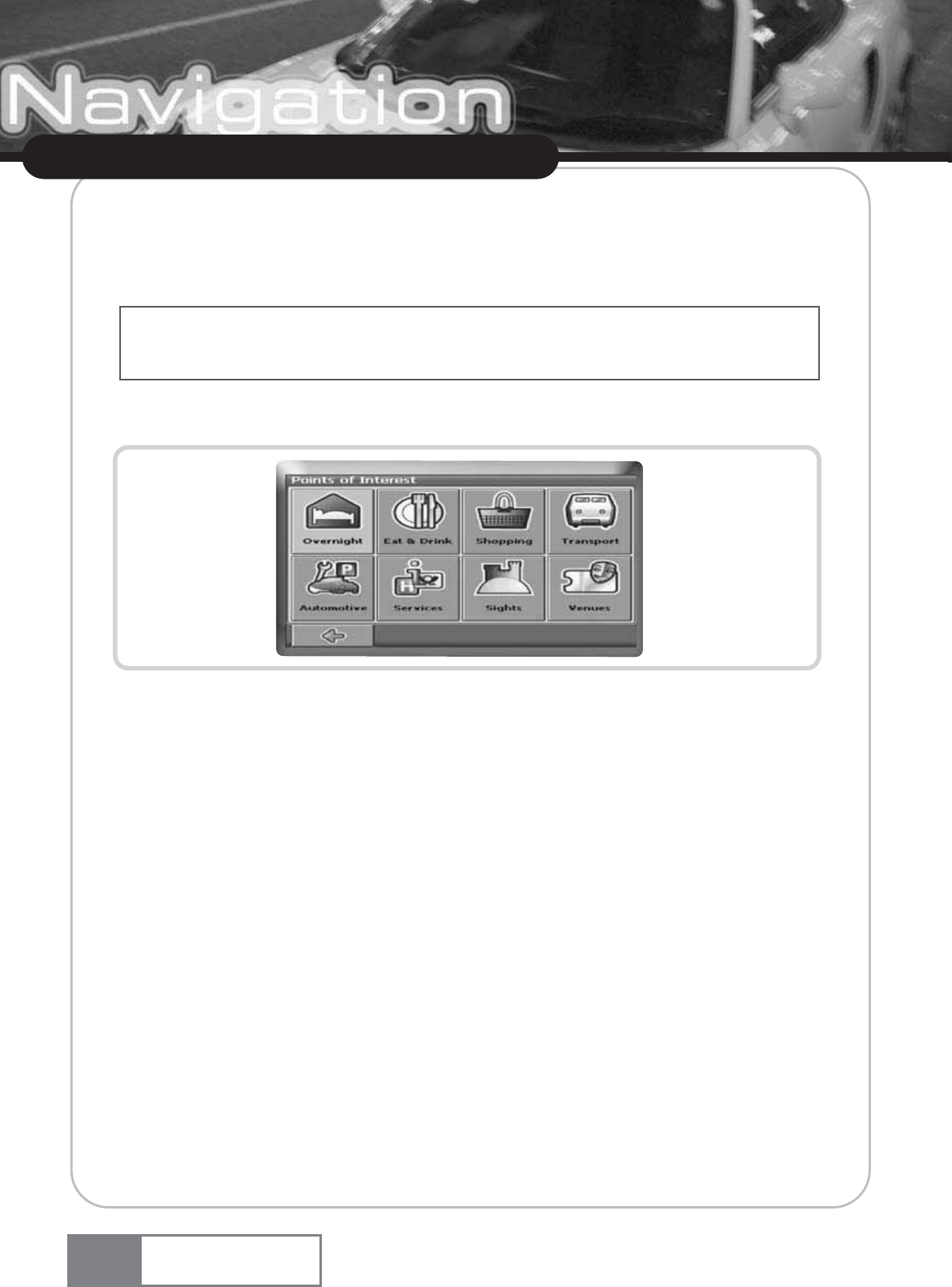
ҶPress At location to look for POIs at a remote location. You need to enter a city or zip code
through the keypad, similar to the address search (see Address Search on page 19).
ҶPress Nearby to open a list of POIs near your current location.
A menu showing the POI categories will be shown:
ҶPress on the desired POI category.
A menu with subcategories will be shown.
ҶChoose a subcategory.
A list of POIs will be shown.
ҶSelect a POI by clicking on it.
ҶOn the following screen, choose Navigate to be guided to the POI (press Info to show further
details about the POI; press Map to show the POI on the map; or press Save to save the POI
as a bookmark).
Navigation will start immediately.
Guides
Within the POI menu you will see the guides, an optional and highly recommendable feature.
Branded travel/city guides will help you to find out what is nearby and will give you valuable
information about attractions, restaurants, hotels, etc. with detailed descriptions. You may use the
items contained in the guides for navigation or save them as bookmarks.
26
Using Navigation System
Navigation System
By pressing Everywhere you can perform an overall search, encompassing the whole POI directory as well
as all guides.
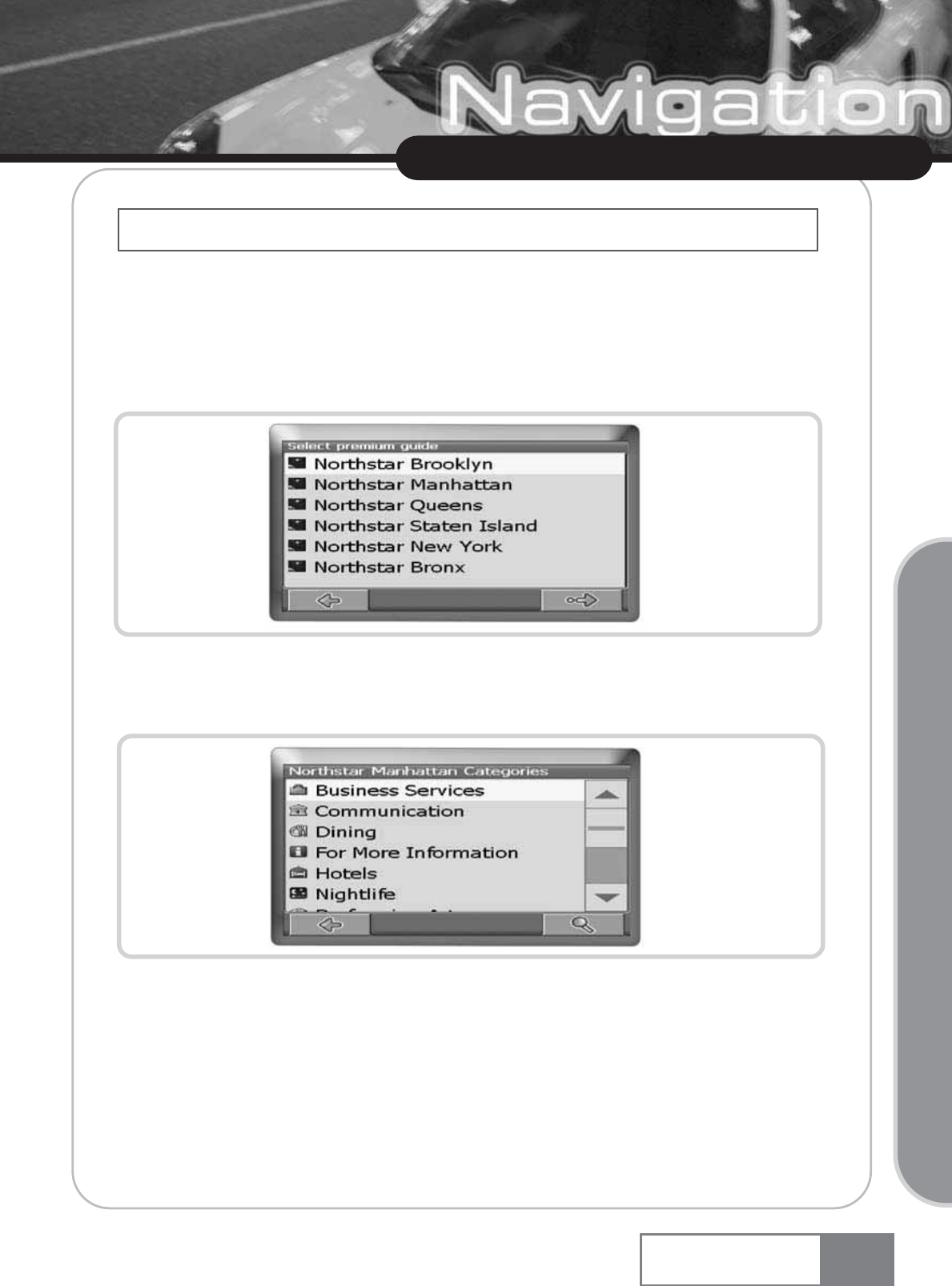
ҶOn the start screen, choose Destination.
ҶOn the following screen, choose POI.
ҶChoose Guide.
The guide list will be shown:
ҶSelect the guide you wish to use by clicking on it.
The categories page of the chosen guide will be displayed:
You can now browse the guide by categories or search the guide.
27
Using Navigation System
Navigation System
Basic Operation
Guides are an optional feature and may be purchased at customer service web site(please, see page 81).
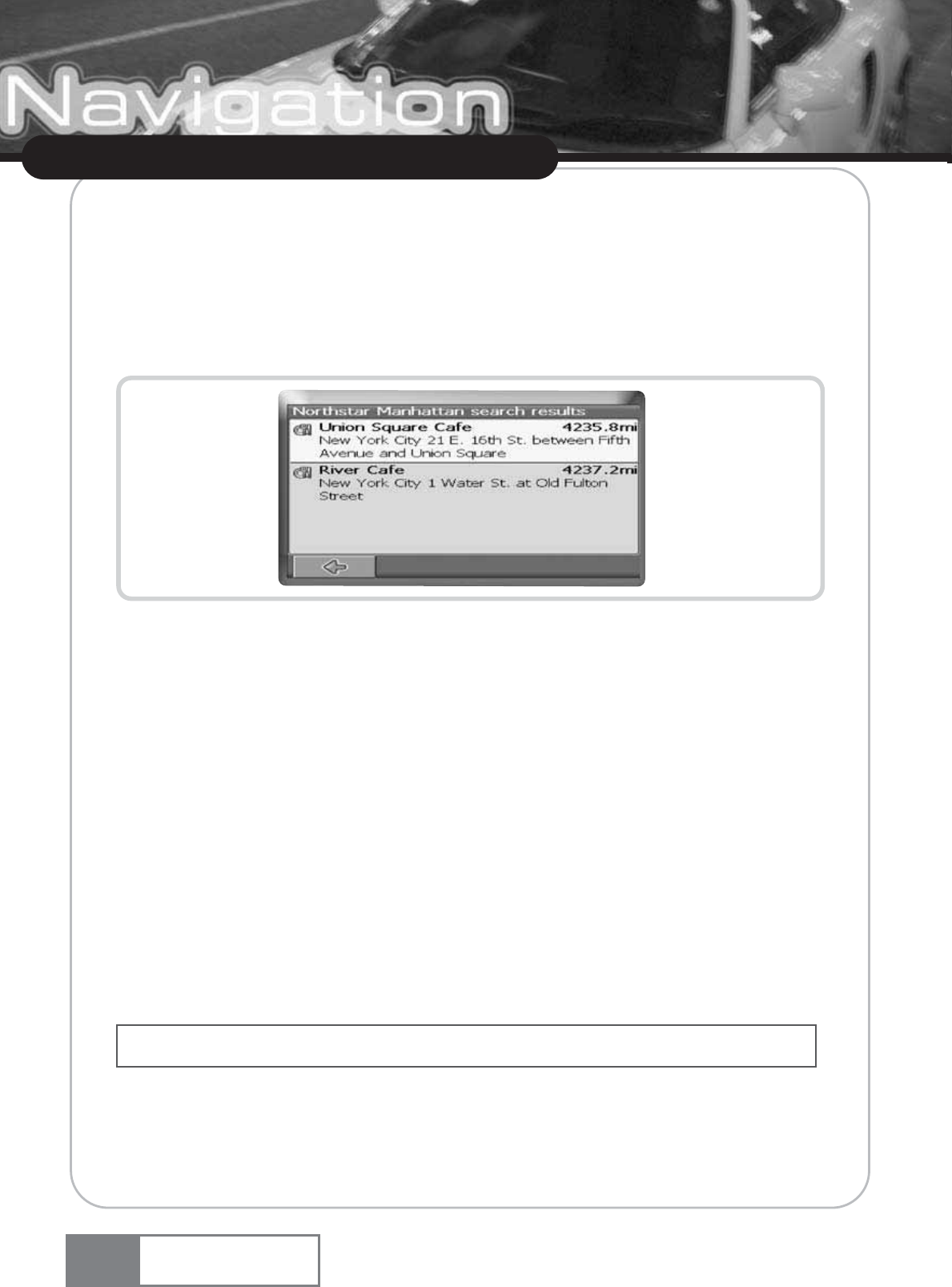
Search the guide
ҶPress the search symbol (magnifying glass).
ҶIn the search window, enter a search term (at least three characters), and start searching by
pressing the search symbol (magnifying glass).
The hit list will be displayed:
ҶSelect an entry by tapping on it.
On the following menu you can .
Ҷget detailed information about the selected location by pressing Detail.
Ҷexplore the location s surroundings by pressing Map.
Ҷuse the item for guidance by pressing Navi.
Ҷsave the item as a bookmark by pressing Save.
Browse the guide by categories
On the categories page you may select from the different categories of the Guide (e.g. restaurants,
hotels, bars, museums etc.).
ҶUse the up and down arrows to scroll in the list.
ҶClick on a category or subcategory to search for relevant items.
The search results will be shown in the hit list, sorted by distance.
ҶSelect an entry by tapping on it.
28
Using Navigation System
Navigation System
Some guides also offer subcategories.
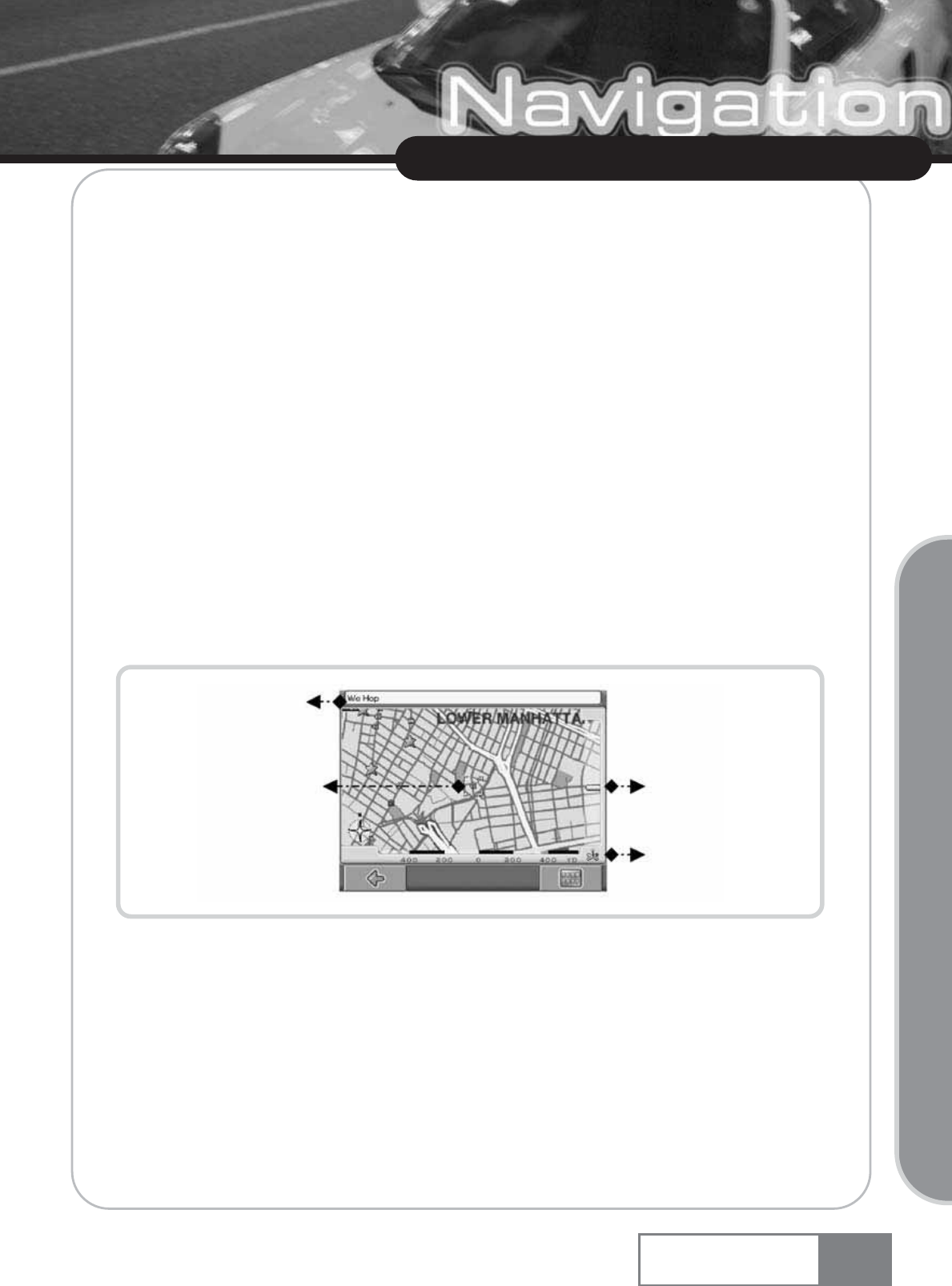
On the following menu you can .
Ҷget detailed information about the selected location by pressing Detail.
Ҷexplore the location s surroundings by pressing Map.
Ҷuse the item for guidance by pressing Navi.
Ҷsave the item as a bookmark by pressing Save.
Map
The map not only shows roads and squares, but also points of interest such as restaurants, cultural
attractions, parking garages, etc. You can zoom out or zoom in to see all kinds of details.
ҶOn the start screen, choose Destination.
ҶOn the following screen, choose Map.
ҶChoose Guide.
The general map will now be shown in the display:
29
Using Navigation System
Navigation System
Basic Operation
Zoom In (down)
and Out (up)
Toggle between
2D and 3D Mode
Street/POI
Information
Selected
POI/Street
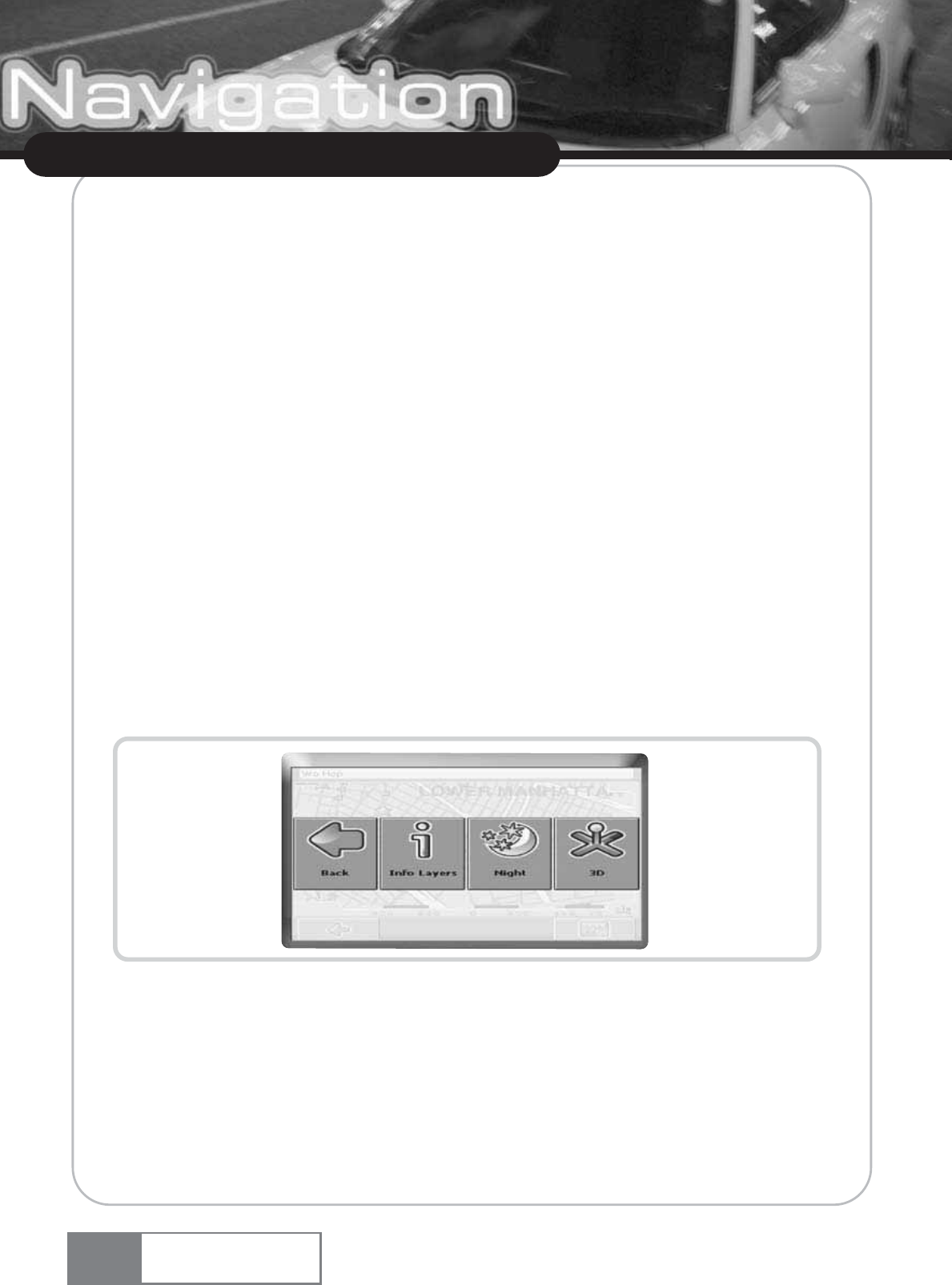
Functions of buttons
Discover your surroundings by dragging the map with your finger (or with the pen).
ҶPoint at the symbol of a location to display its name.
ҶUse the scroll bar on the right to zoom in (down) or out (up).
ҶUse the symbol in the bottom right-hand corner of the map to toggle between 2D and 3D view.
ҶWith the compass icon (in the bottom left hand corner) you may adjust the orientation.
By pressing the menu symbol (bottom right-hand corner of the screen), you can access to further
options, like saving the actual location as a bookmark, moving to the actual GPS position,
navigating to the selected location, searching for an address, and accessing to a bookmark or a
nearby point of interest. You can also change your settings:
Map settings
ҶPress the menu symbol below the map.
ҶOn the menu displayed, press Settings.
The map settings menu will be displayed:
ҶToggle between night and day modes by pressing the corresponding symbol.
ҶToggle between 2D and 3D mode by pressing the corresponding symbol.
ҶChoose Info Layers to choose which kinds of elements are to be shown on the map:
30
Using Navigation System
Navigation System
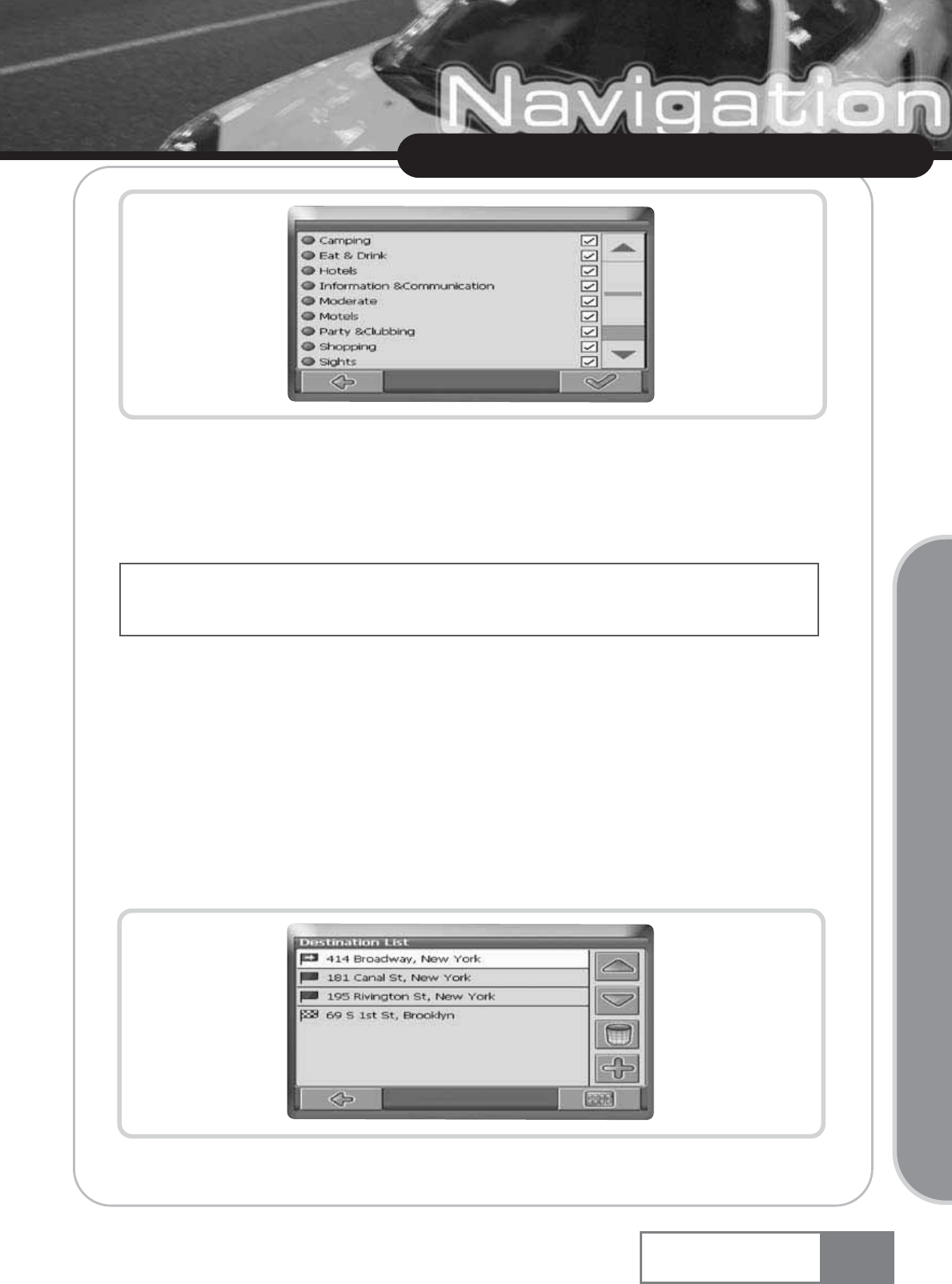
ҶCheck the boxes of any category you want to have displayed on the map. Uncheck those that
should be hidden.
ҶPress the confirmation symbol in the bottom right-hand corner to select/deselect all categories.
ҶPress the arrow symbol to return to the map.
5-2. Plan your Route
This section describes the route planning feature. This feature allows you to plan your route in
advance, choosing multiple stopovers along your journey.
ҶOn the start screen, choose Destination.
ҶOn the following screen, choose Plan Route.
The Destination List will be displayed:
ҶPress the + symbol to add a stopover.
31
Using Navigation System
Navigation System
Basic Operation
It is not possible to browse the map in the start screen. This screen merely shows your current GPS position,
given you have a GPS connection.
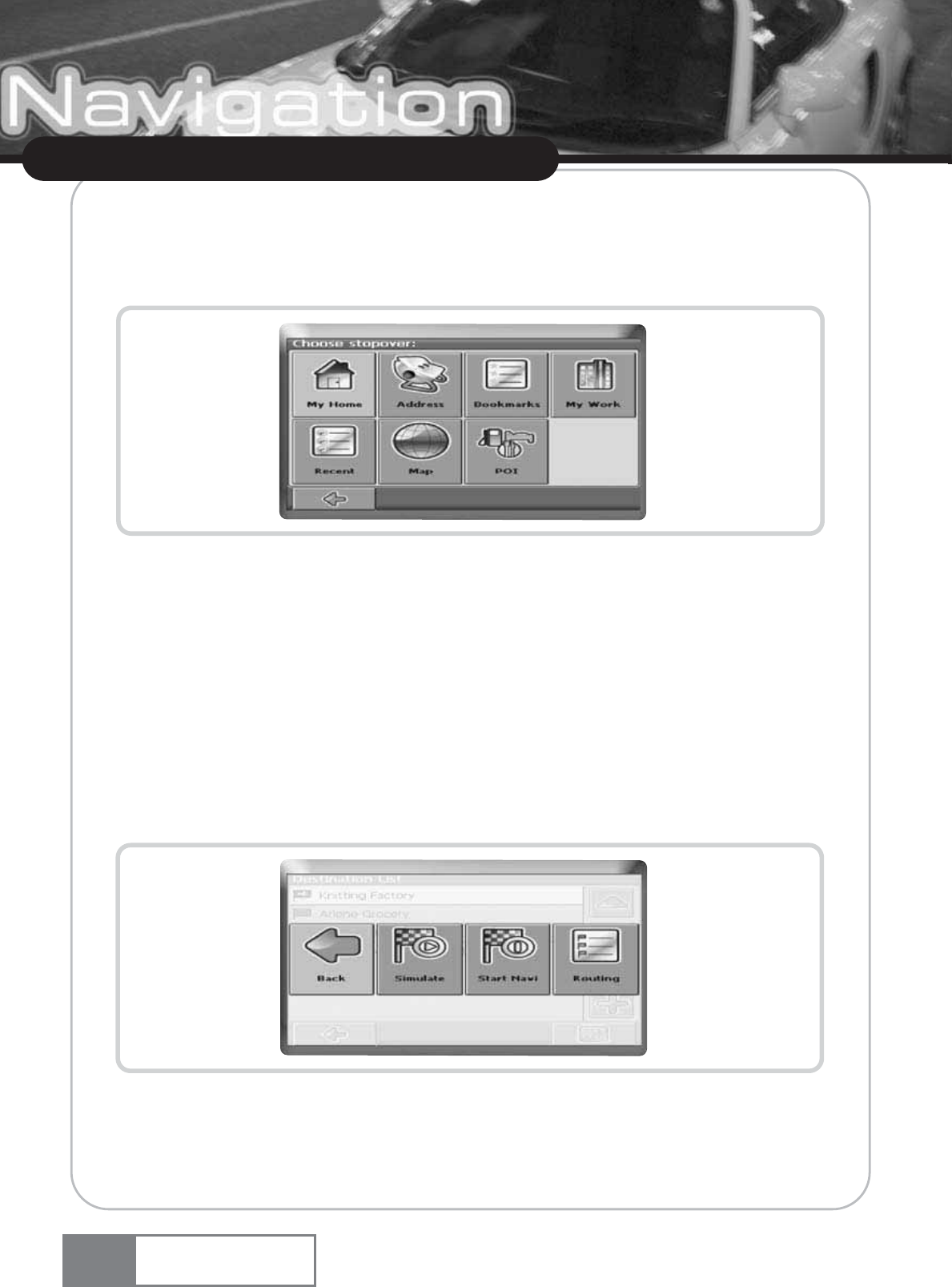
You will switch to the Choose stopover screen. You may choose stopovers like your home or work
addresses, a bookmark, a point of interest, a recent location or by searching for an address or
pinpointing a destination on the map.
Once you have added stopovers (with the + symbol) and returned to the Destination List, you have
several options:
ҶWith the + symbol you can choose additional stopovers.
ҶTo change the order of the stopovers, select a stopover and then use the up and down arrows
to move it up/down in the list.
ҶWith the trash symbol you can delete a selected stopover.
Once you have chosen your route, you have several options. You reach those options by pressing
the menu symbol (bottom right-hand corner of the screen).
32
Using Navigation System
Navigation System
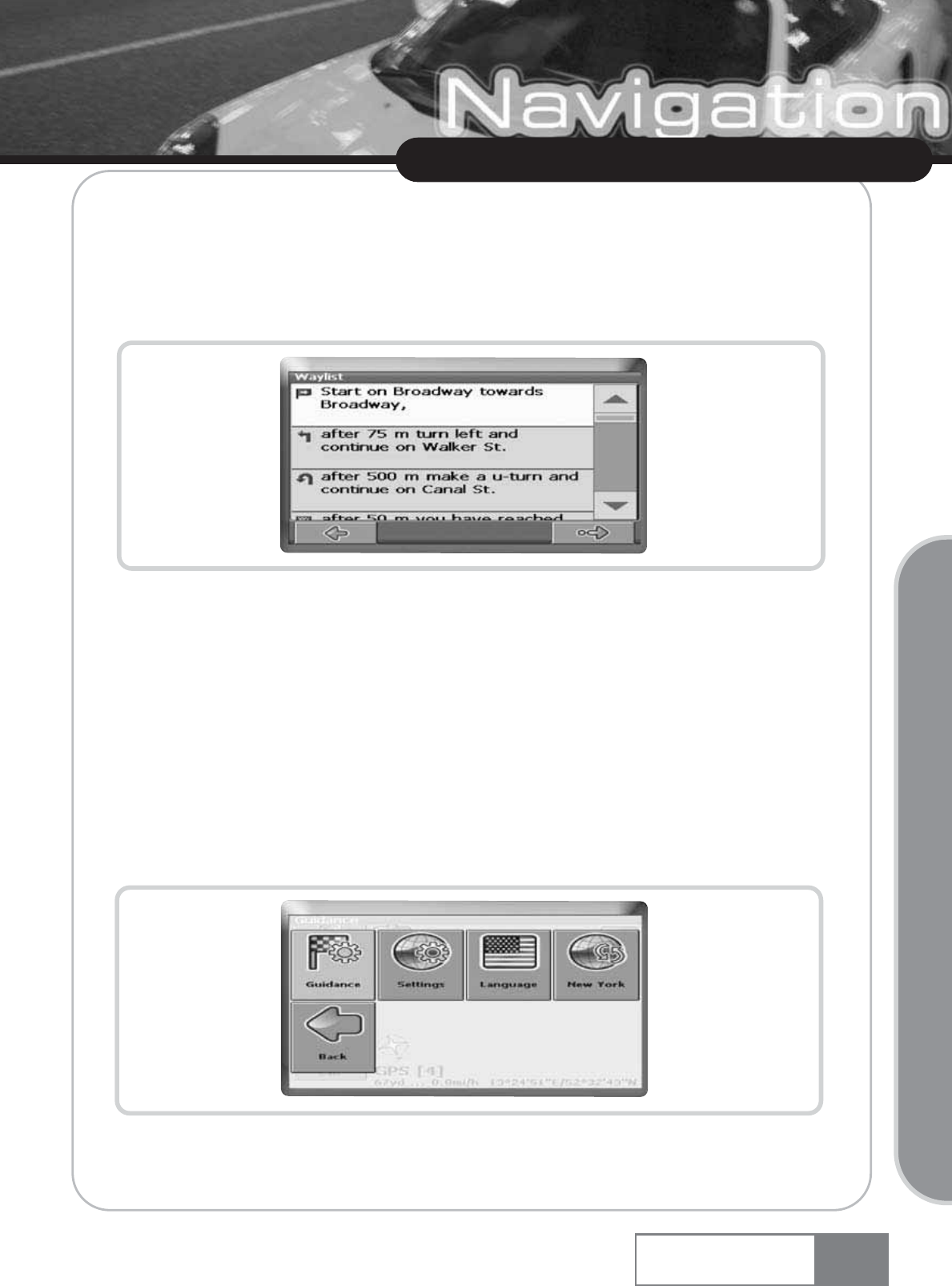
ҶPress Simulate to simulate the route to come.
ҶPress Start Navi to start guidance. The display will switch to the navigation map.
ҶWith Routing the system will calculate your route. The Route Summary will be displayed. Tap
on one of the items in the Route Summary to display the Waylist. Tap again to show the map view.
5-3. Settings
You can configure your Personal Navigation Device to suit your needs. When it comes to
navigating, you can, for example, choose to avoid or allow toll roads or ferries or select your mode
of transportation, like a fast or slow car, a scooter or even your own feet. You can also edit several
display settings, like 2D or 3D mode, day or night mode, map complexity, etc.
ҶOn the start screen, choose Settings.
The settings screen will be shown:
33
Using Navigation System
Navigation System
Basic Operation
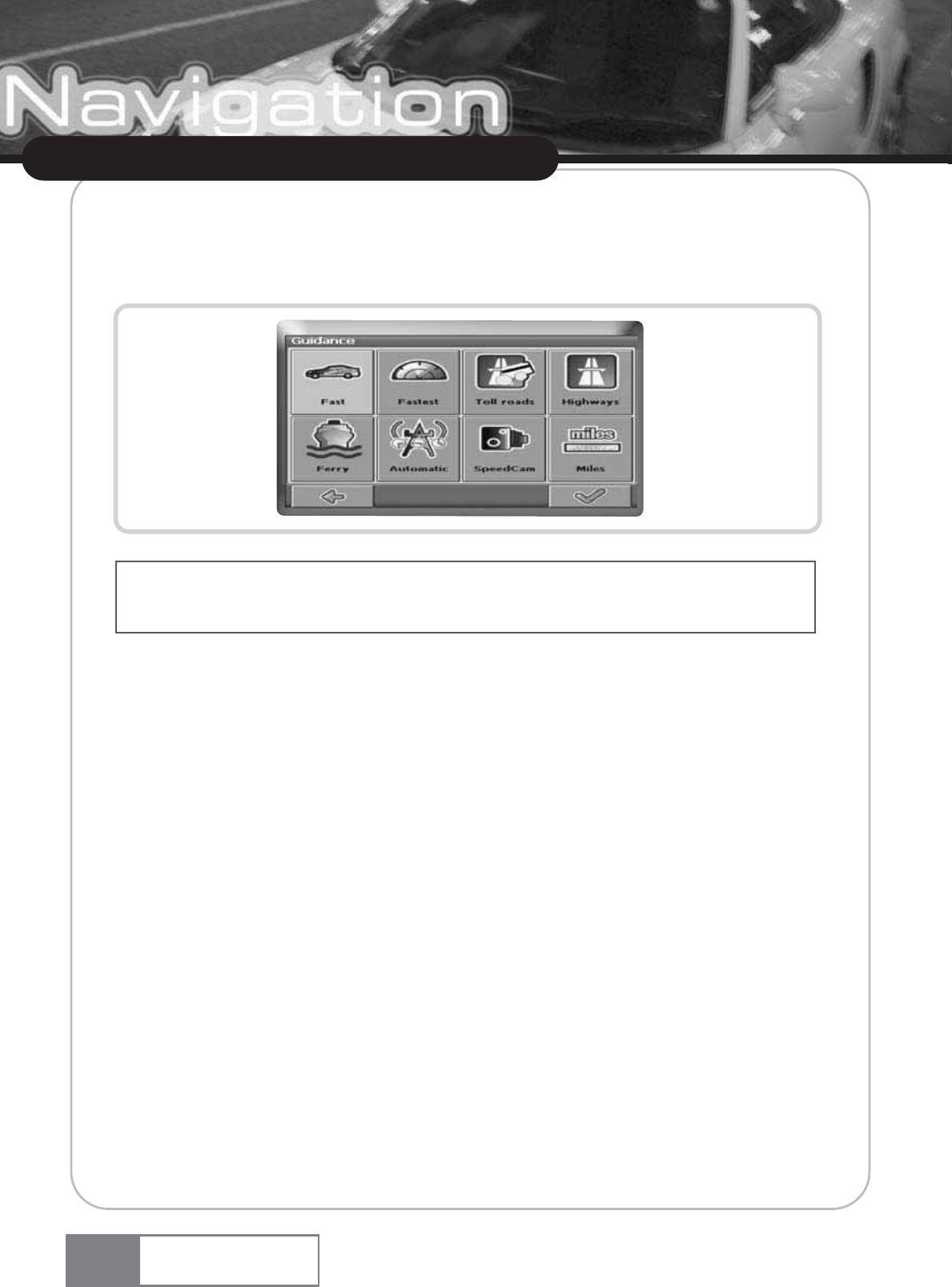
Guidance Settings
ҶChoose Guidance to change the guidance settings.
The window with the guidance settings will be displayed:
ҶTo switch between the modes just touch the icons. These will toggle so you can quickly see the
activated settings.
You can choose among the following options: Mode of transportation (fast car, slow car, motorbike,
pedestrian, etc.), fastest or shortest route, allow or avoid toll roads, highways, and ferries. You can
also choose the distance unit (miles/kilometers).
Once you have chosen your settings, press the confirmation symbol to return to the main menu.
34
Using Navigation System
Navigation System
If you have purchased additional features (see Optional Features on page 37), like TMC, SpeedCam Alert
or Route Recording, you can switch them on or off through this menu.
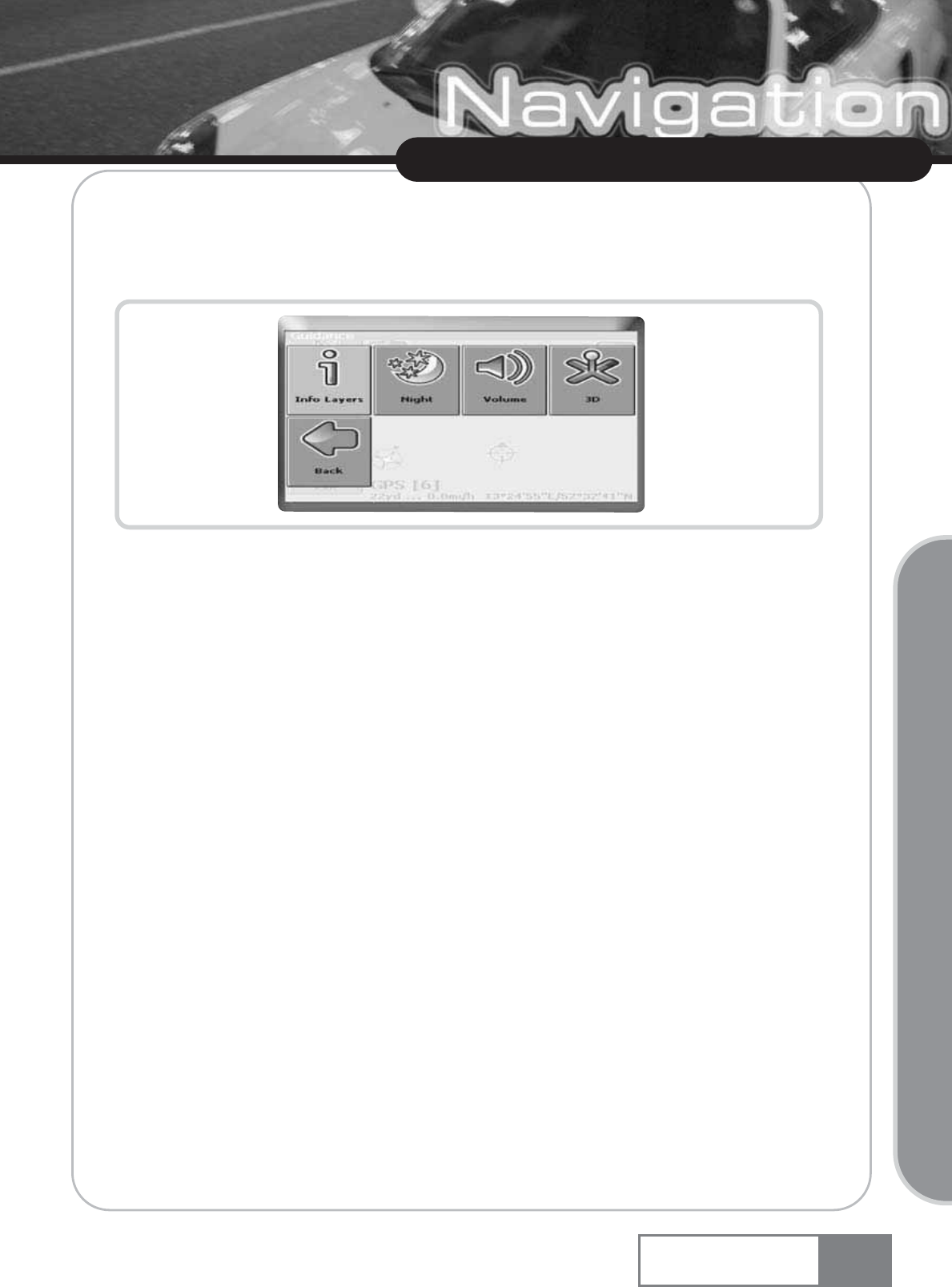
Settings (General Settings)
ҶChoose Settings to change the general settings.
The windows with the general settings will be shown:
ҶPress Info Layers to adjust the complexity of the map, i.e. to select which items are to be
shown on the map (see Map on page 29).
The other settings include switching between day and night as well as 2D and 3D mode and
adjusting the Volume.
ҶPress Back to return to the start screen.
Language
Choose Language to select the language of your navigation system.
Map
If you have map data for different regions/cities on your memory card, tap on the name of the
current region (e. g. Northeast). All available maps on the memory card will be listed. You can
choose the desired region by simply tapping on its name.
35
Using Navigation System
Navigation System
Basic Operation
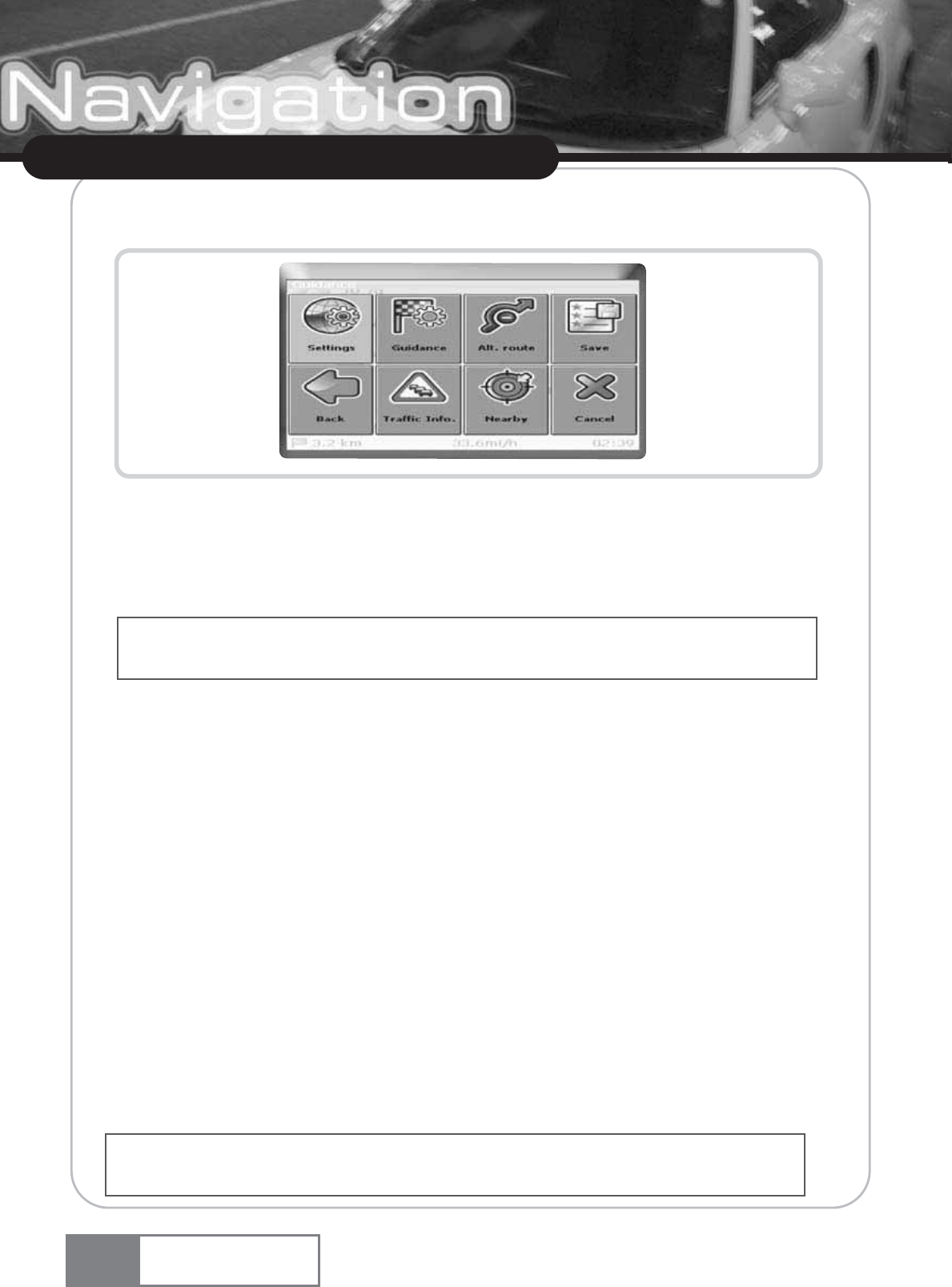
Change settings during navigation
ҶTouch the screen during guidance to open the settings screen:
Here you will find the following items:
Settings
Open a menu with general settings, as described in Settings (General Settings) on page 35.
Additionally you can toggle between map and arrow mode for guidance.
Guidance
Change the guidance options, as described in Guidance Settings on page 34.
Alt. route:
With this option, you can choose to block the calculated route for a given distance (e. g. 0.5 km)
and force an alternative route. Simply tap on the icon which shows the desired distance. Your route
will be recalculated, and the previous route will be discarded for the given distance.
Save
Save your actual position as a bookmark.
Traffic Info
Show a list of traffic jams. Traffic jams along your route will be displayed in red.
Nearby
You can redirect your route by choosing a point of interest (POI), like a gas station.
36
Using Navigation System
Navigation System
When you change to the arrow mode, the navigation screen will not show the map but only an arrow
indicating the upcoming maneuver.
All user information like e.g. settings, bookmarks and recently visited locations will be stored on the
memory card and not on the device.
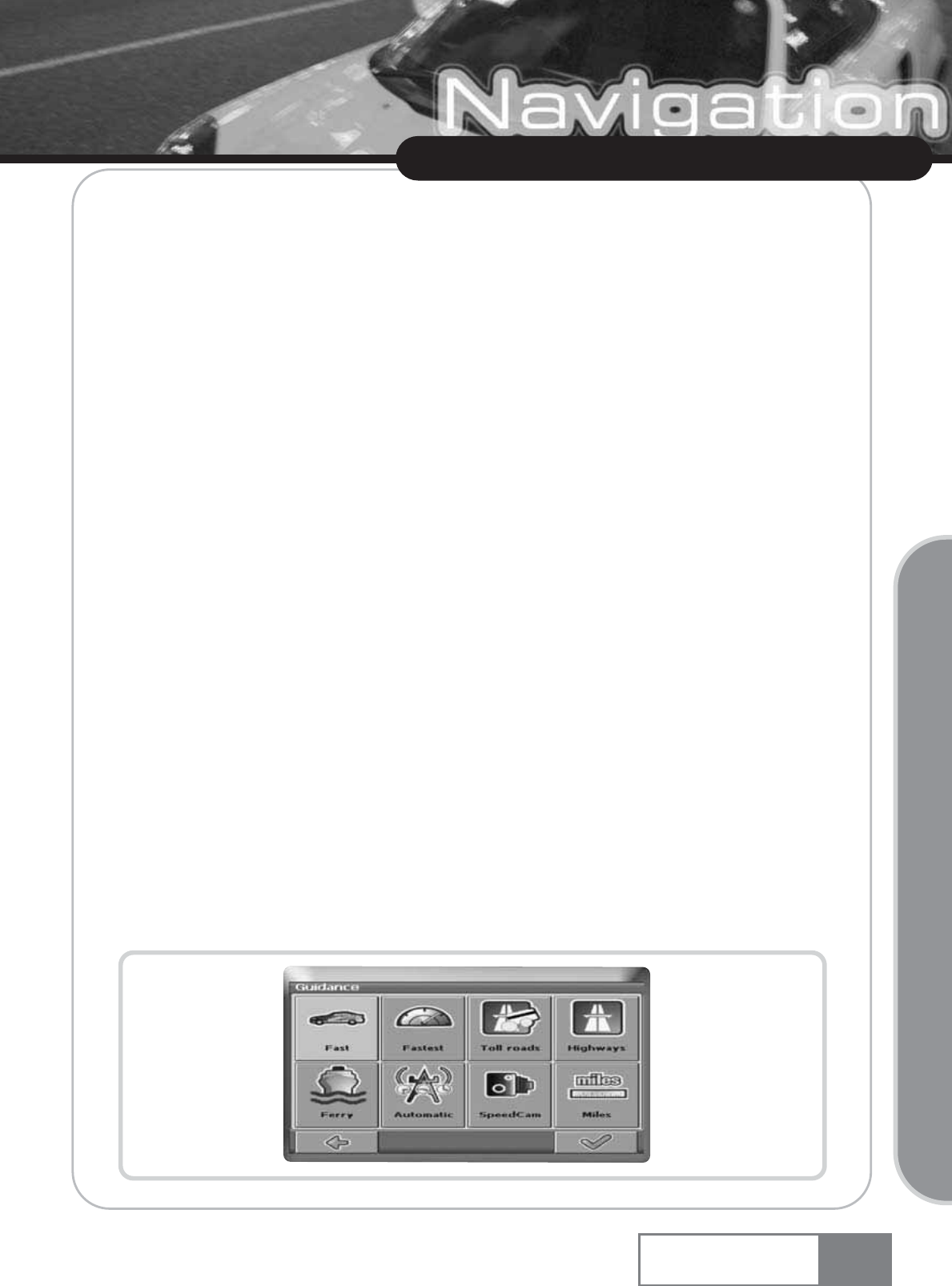
6. Optional Features
You can further enhance your Personal Navigation Device through a set of optional features. The
following features are available as options for your navigation system:
ҶGuides
ҶTraffic Message Channel (TMC)
ҶRoute Recording
ҶSpeed Camera Alert
6-1. Guides
At www.navi-plugins.com you can find lots of valuable information services, including directory
services, WiFi hotspot locators, and city guides. City guides contain detailed information about
locations, such as descriptions, contact information, prices, opening times, etc.
To purchase the guides and to learn how to download them, please go to customer service web
site(please, see page 81).
To learn how to use the guides, see POI/Guides on page 25.
6-2. Traffic Message Channel (TMC)
Depending on your device, you may upgrade your navigation system and receive dynamic traffic
information (Traffic Message Channel, TMC).
ҶIn the start screen choose Settings and then Guidance.
The window showing the guidance settings will be displayed:
37
Using Navigation System
Navigation System
Basic Operation
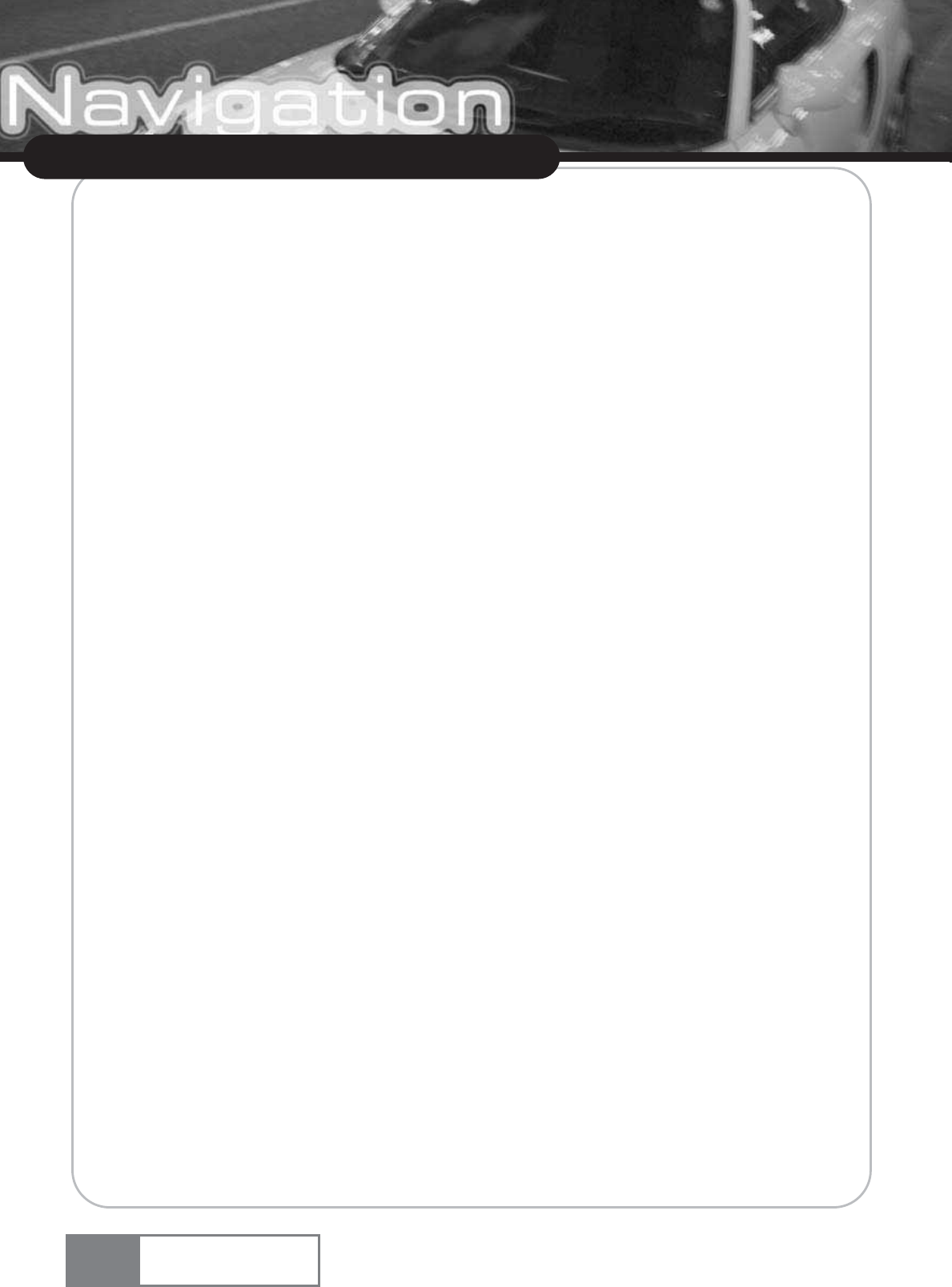
ҶPress the TMC button (transmitter symbol) to switch between the TMC settings Automatic,
Manual and Off.
With the Automatic option, your Personal Navigation Device will automatically guide you around
all the traffic jams on your route. With the Manual option your navigation system will alert you
about traffic jams and ask you if you would like to switch to an alternate route.
38
Using Navigation System
Navigation System
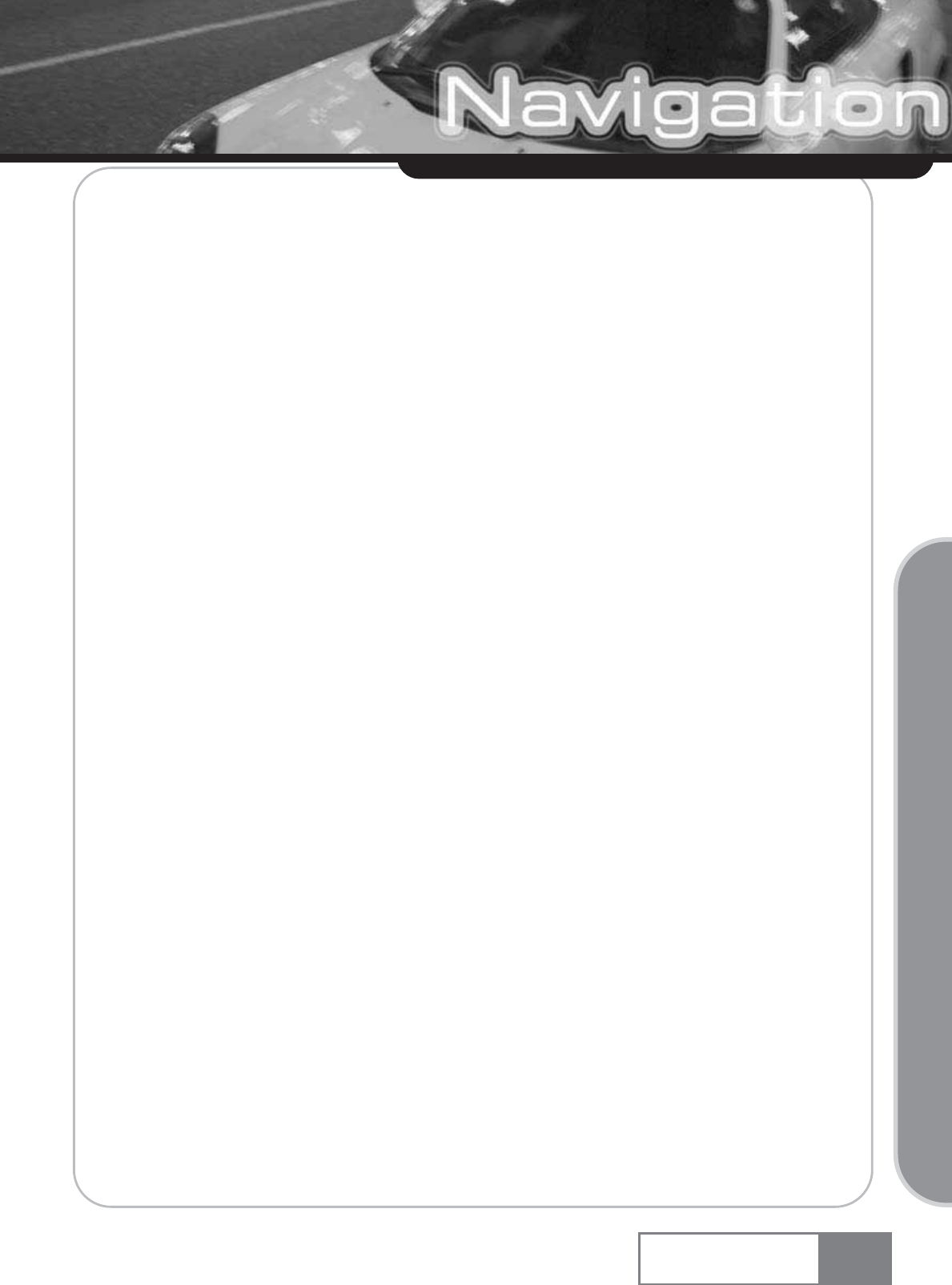
7. Frequently asked questions
I can t find an address.
Please make sure you have correctly spelled your entry. If you do not know how an address is
spelled correctly, simply enter the parts of the address, you know for sure (e.g. New York ,
Times for Times Square in New York City). Then browse in the result list and look for the address.
Also make sure that the city in which you are looking for an address is correct. Sometimes the
official postal address differs from the address you are looking for. In that case, search for an
address nearby that you know of and browse on the map.
If you find the address on the map but you can not find it while searching for it, please let us know
via pnd@support.gate5.net.
There is a failure in the map / POIs are missing.
If you detect an error in the map data (e.g. a street is missing completely), we would like to inform
our map data provider. Please let us know via pnd@support.gate5.net.
I have problems to get a GPS fix.
If you have problems getting a satellite fix with the GPS (you can see how many satellites are being
received on the main menu at the bottom left) please make sure, that you are outside and the GPS
antenna has a good visibility to the open sky. Some models also do support an additional external
active antenna. Please also consult with the hardware manual of your device to get further
information of how to obtain a GPS fix.
Where can I get technical support and updates ?
Please, contact your retail store or the customer sevice center in page 81.
39
Using Navigation System
Navigation System
Basic Operation
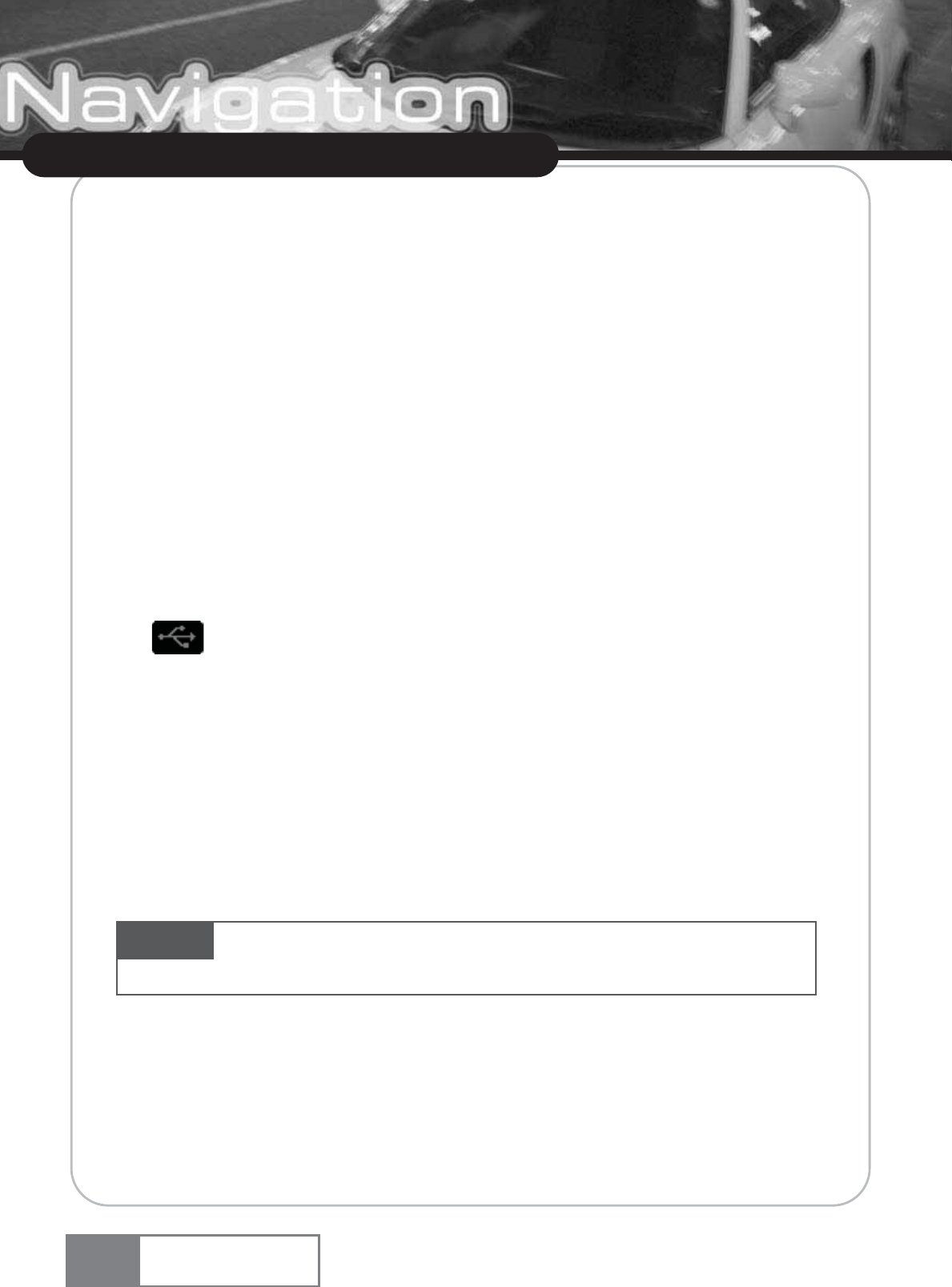
8. Audio player
You can play back music by selecting Audio player in the main menu. Basic functions include Play,
Pause, Stop, Select Next, and Select Previous. Playback function includes Repeat, Repeat Selected,
and Random.
The supported music file formats are MP3, WMA, and WAV.
You can save music files in the Navigation System internal memory or in the USB memory. The
audio player manages the music file by albums.
You can save the music file in the internal memory using V-Up Pro program, and create an album
at this time.
To play back music using the USB memory
(If the icon appears at the right upper side, the device detects the USB memory.)
1. If you save the music file in the root directory of the USB memory, it will be recognized
as ũDefault album 1Ū.
2. If you create a ũMusicŪfolder in the USB memory and save the music file in it, it will be
recognized as ũDefault album 2Ū.
3. If you create a folder inside the ũMusicŪfolder in the USB memory, this folder will be
recognized as an album.
40
Using Navigation System
Navigation System
Caution If you create a sub-folder under a user-defined folder in the main ũMusicŪfolder, it will
not be recognized. Be sure to create just one sub level of folders in theũMusicŪfolder.
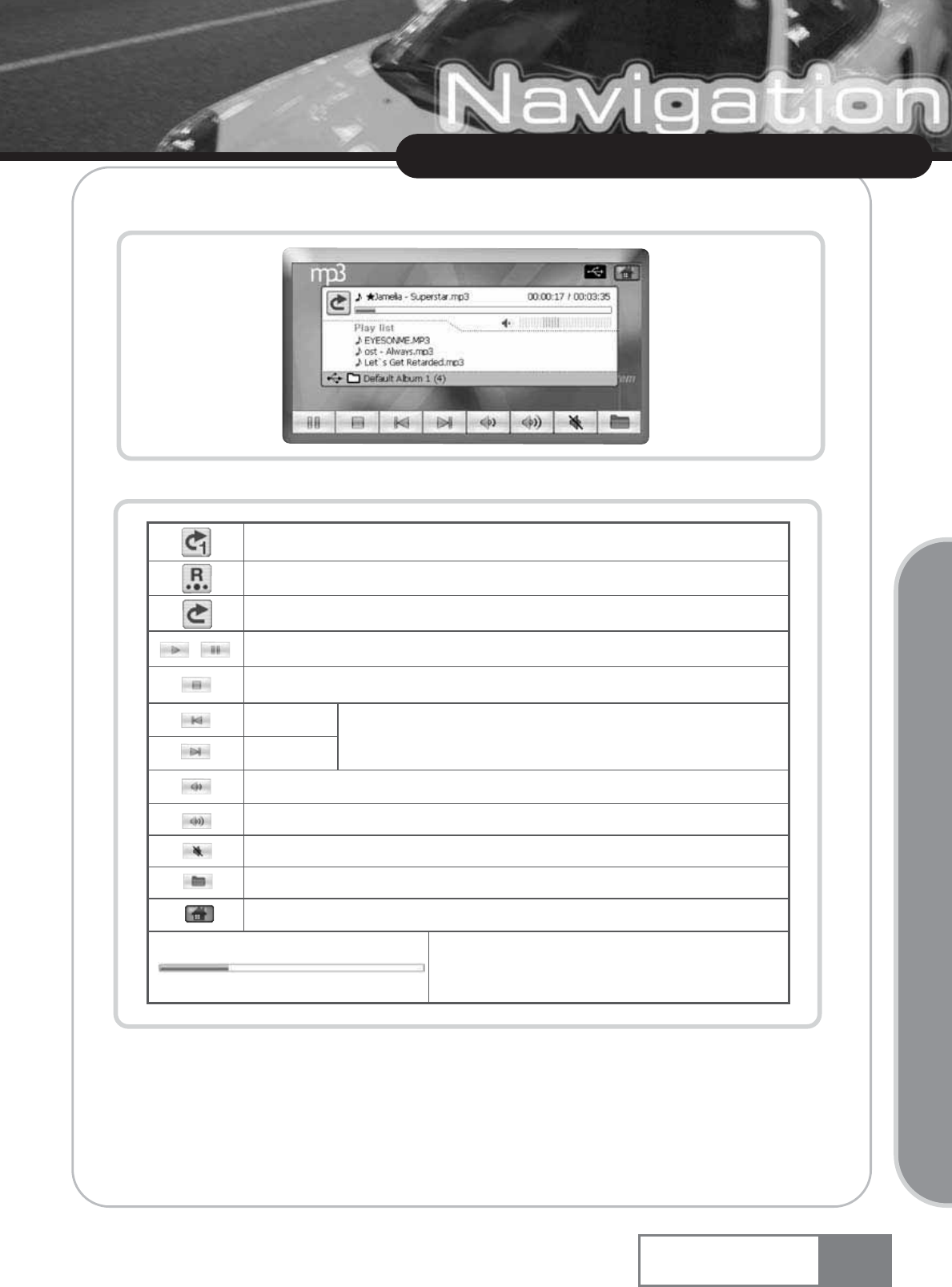
8-1. Basic screen
41
Using Navigation System
Navigation System
Basic Operation
Repeats playback of the selected music file.
Random playback.
Repeats all music files.
Play/Pause : Plays back the music file or pauses it.
Stop : Stops playback.
Next
Previous Moves to the next or previous music file.
Volume control : Increases sound volume.
Volume control : Decreases sound volume.
Mute : Suppresses sound volume.
List : Displays the list of music files.
Main menu : Returns to the main menu.
Progress status bar : You can jump to the
target point of the selected music file.
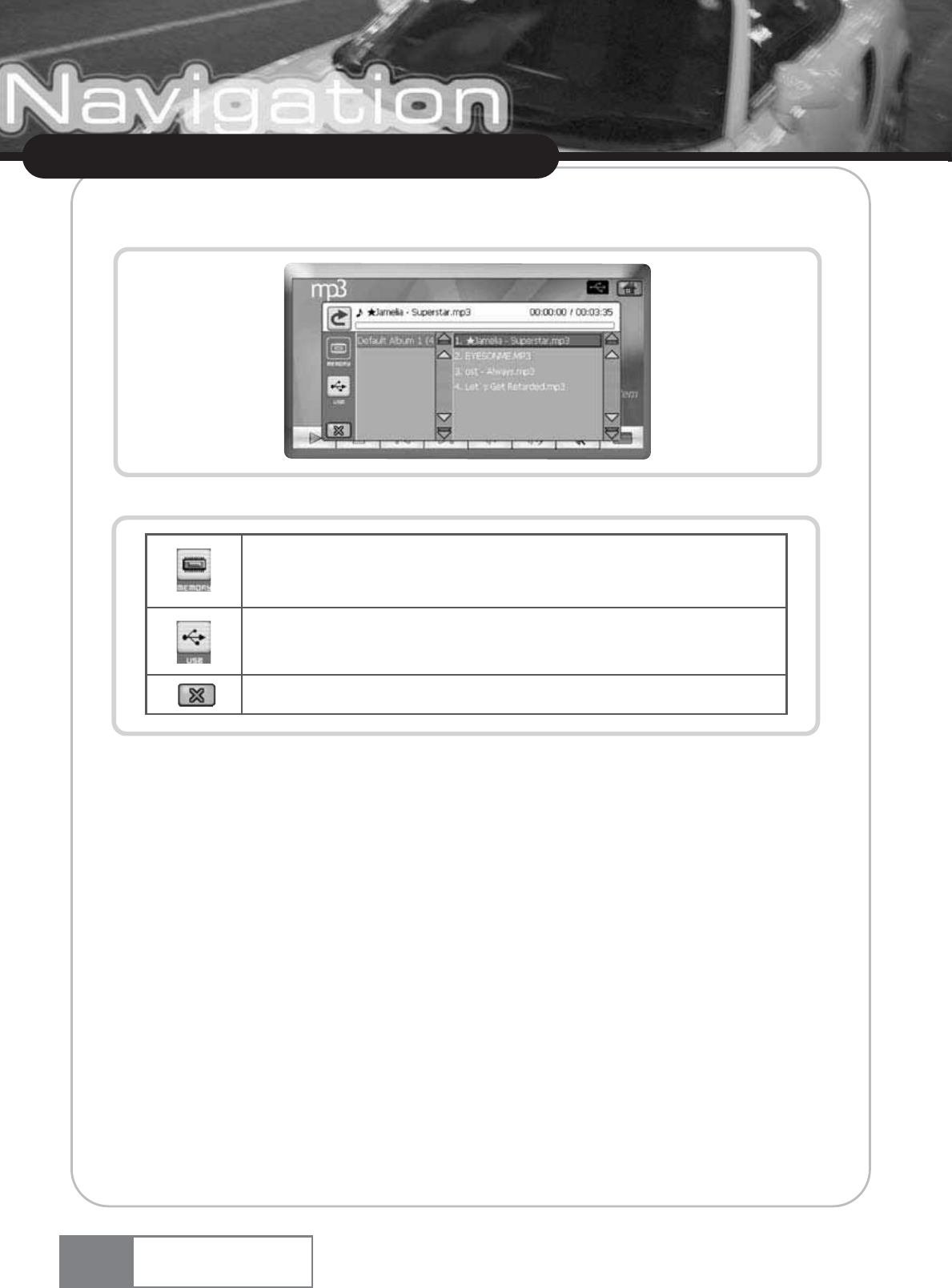
Using Navigation System
8-2. List screen
1. Select the music file to play back from the internal memory or external USB memory.
2. Select the album that contains the desired music file.
3. Select the music file you want.
Navigation System
42
Internal memory : Displays a list of music files saved in the internal memory.
USB memory : Displays a list of music files saved in the external USB
memory.
Close : Closes the list screen.
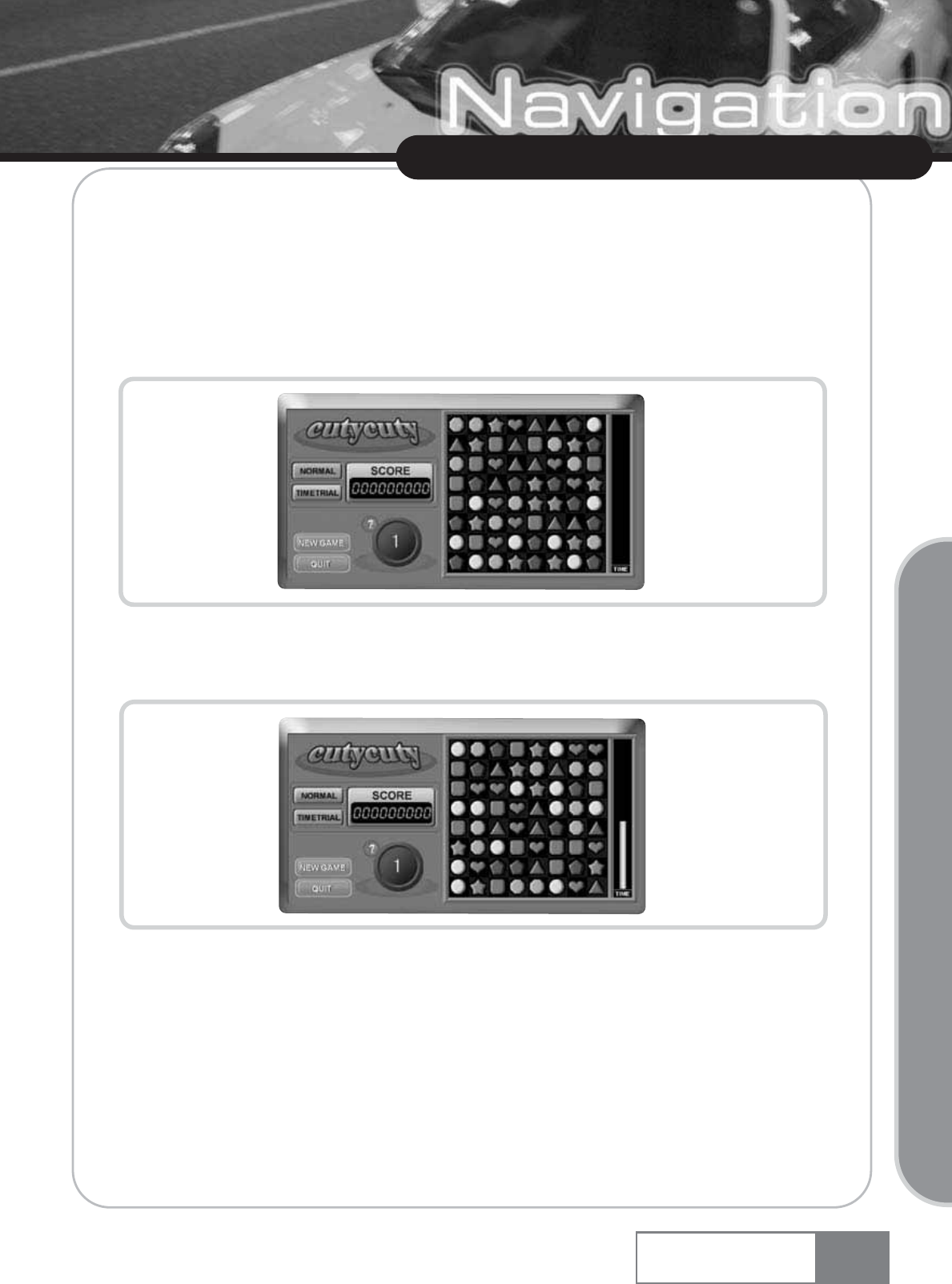
Using Navigation System
9. Game
Select the Game in the main menu.
How to play : If you place more than three of the same items in arow vertically or horizontally, these
items will disappear.
To get higher score, remove as many items as possible at a single time.
Normal mode : The game will be over if no further mioves are possible.
If the bar on the right side is filled, the next level will start.
ҶTime trial mode : The game will be over if the time bar on the right side runs down. If
the bar on the right side is filled, the next level will start.
Ҷ’?’ : This button gives you a hint at the expense of losing some score. This button will be
disabled if the score is not sufficient.
ҶNew Game : Stops the current game and starts a new one.
ҶQuit : Exits the game.
Navigation System 43
Basic Operation
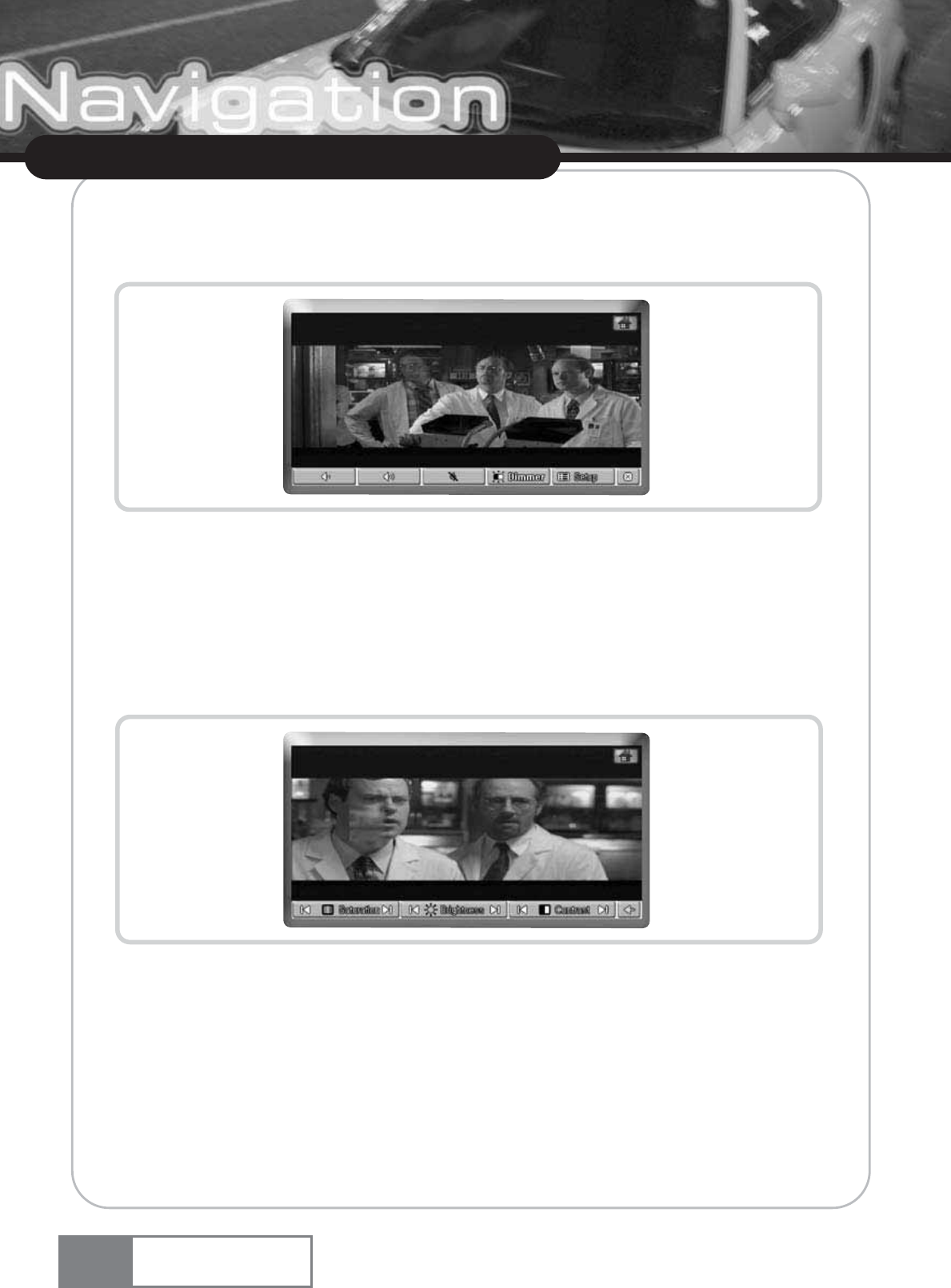
Using Navigation System
10. Aux
You can use the simple Aux function if you set A/V input as ’Others’ in the settings section.
As shown by the above figure, only volume control and screen setting are supported in ’Others’
mode. DVD player control is not supported.
If you press the [Screen Setting] button, the below screen will appear and you can change
saturation, brightness, and contrast.
44 Navigation System
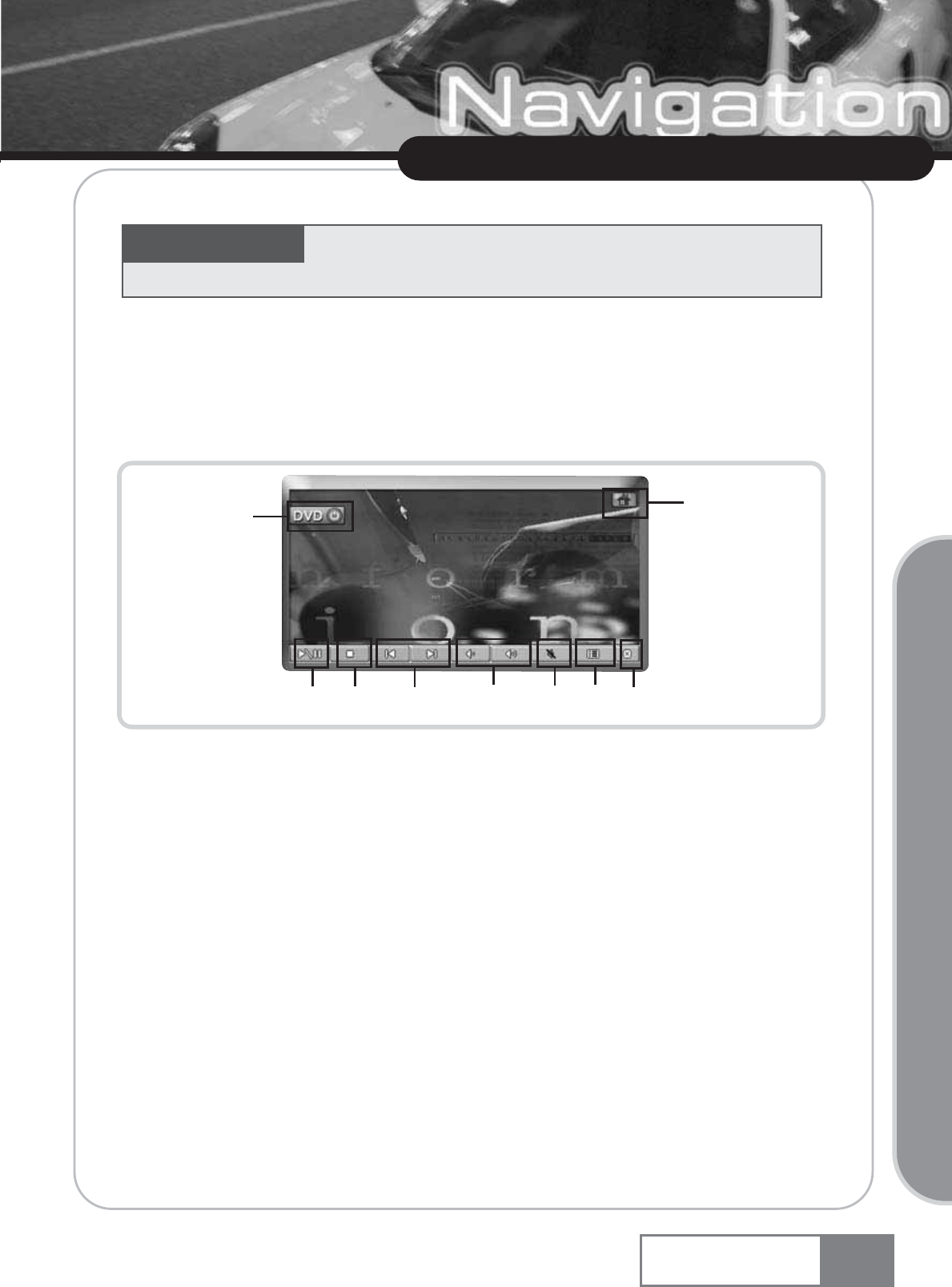
If you have DVD player connected and select VXM or VXD as A/V input in Setup menu
accordingly, you can access the DVD player function via the touchscreen controls. You can also use
the remote controller to use the following functions.
ڸPlay/Pause : Starts or pauses the DVD player.
ڹStop : Stops the DVD player.
ںPrev/Next : Starts the DVD player and moves to previous or next screen.
ڻVolume control : Controls sound volume of the DVD player.
ڼMute : Mutes the DVD player sound.
ڽSetting : The menu will be changed to screen setting and DVD menu setting.
ھHide menu : Hides the menu from the screen.
ڿReturns to the main menu.
ۀDVD player power on/off: Turns on/off the DVD player power.
45
Using Navigation System
Navigation System
Basic Operation
Optional function The following functions are available when connected to the DVD player.
VXM and VXD are the model name.
ڡڤڥ
ڢڣڦ
ڨ
ڧ
ک
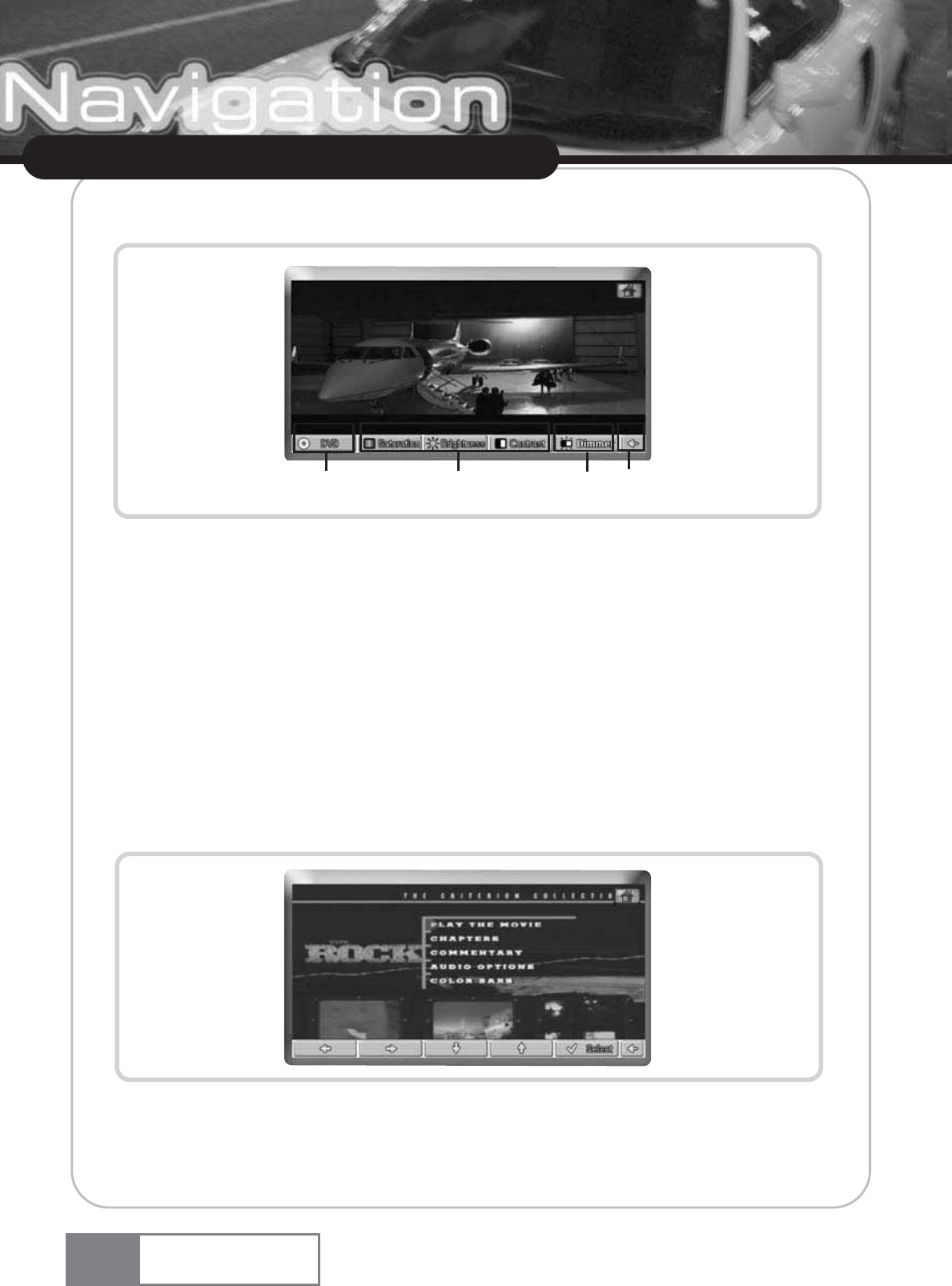
The following screen will appear if you press the [Setting] button.
ڸDVD menu : Switches to the DVD title menu and displays the direction key menu,
which makes cursor movement easier in the DVD title.
ڹSets saturation, brightness, and contrast.
ںDimmer : Controls brightness in 5 discrete levels.
ڻReturns to the previous menu.
The below figure shows the screen when you press the DVD Setting button. You can move the DVD
Title cursor using the direction key either via the remote control or the touchscreen controls.
46
Using Navigation System
Navigation System
ڡڤ
ڢڣ
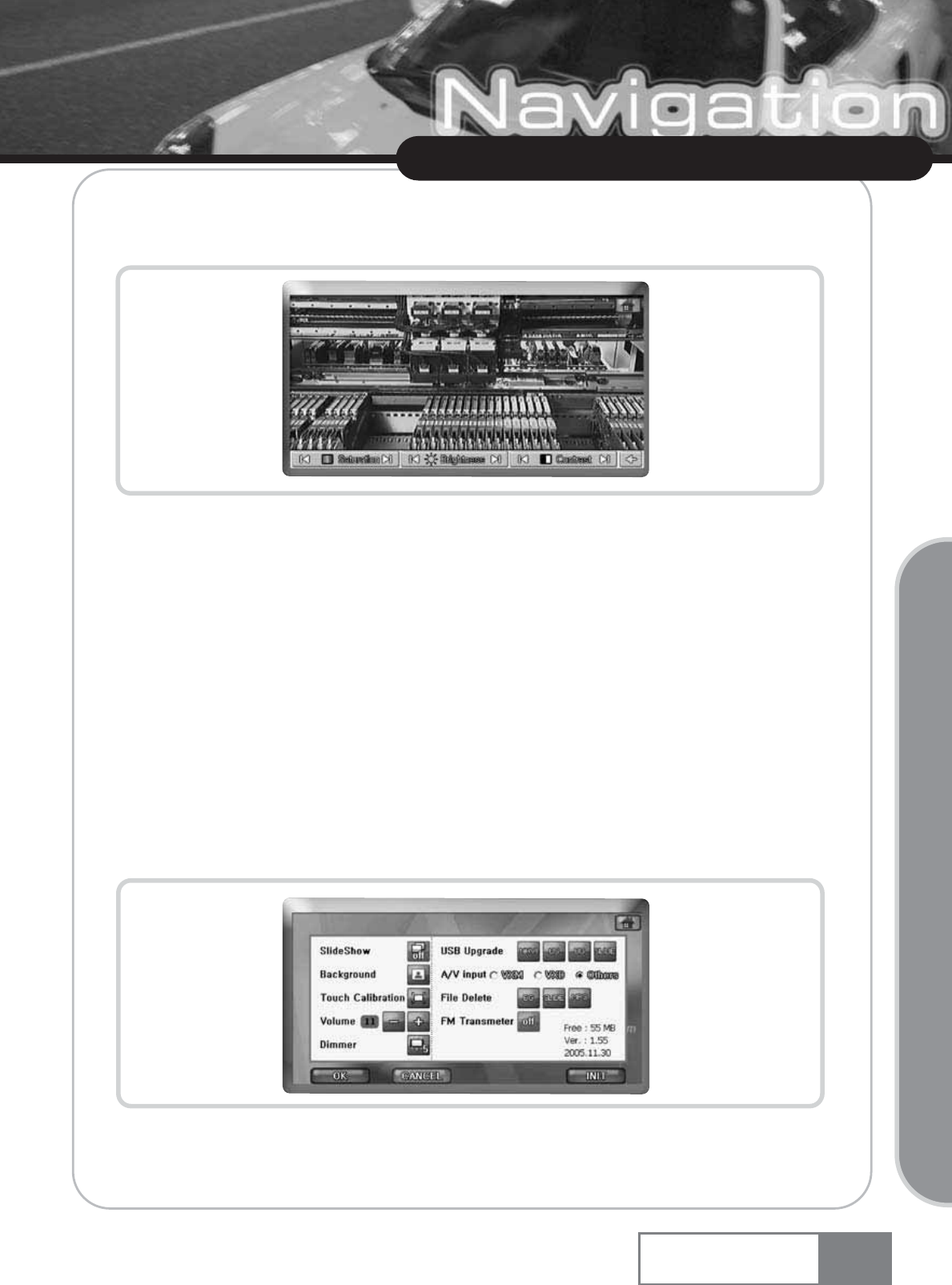
The below figure shows the menu screen when you select saturation setting, brightness setting, or
contrast setting button.
11. Setup
You can change many settings if you select Setup in the main menu.
11-1. Slide show
If no input is made for more than one minute in the main menu, specified images will be
displayed sequentially in a slide show. You can select Off, 10 seconds, 30 seconds, 60
seconds, and 5 minutes for the time interval of image changing when the slide show is
started.
47
Using Navigation System
Navigation System
Basic Operation
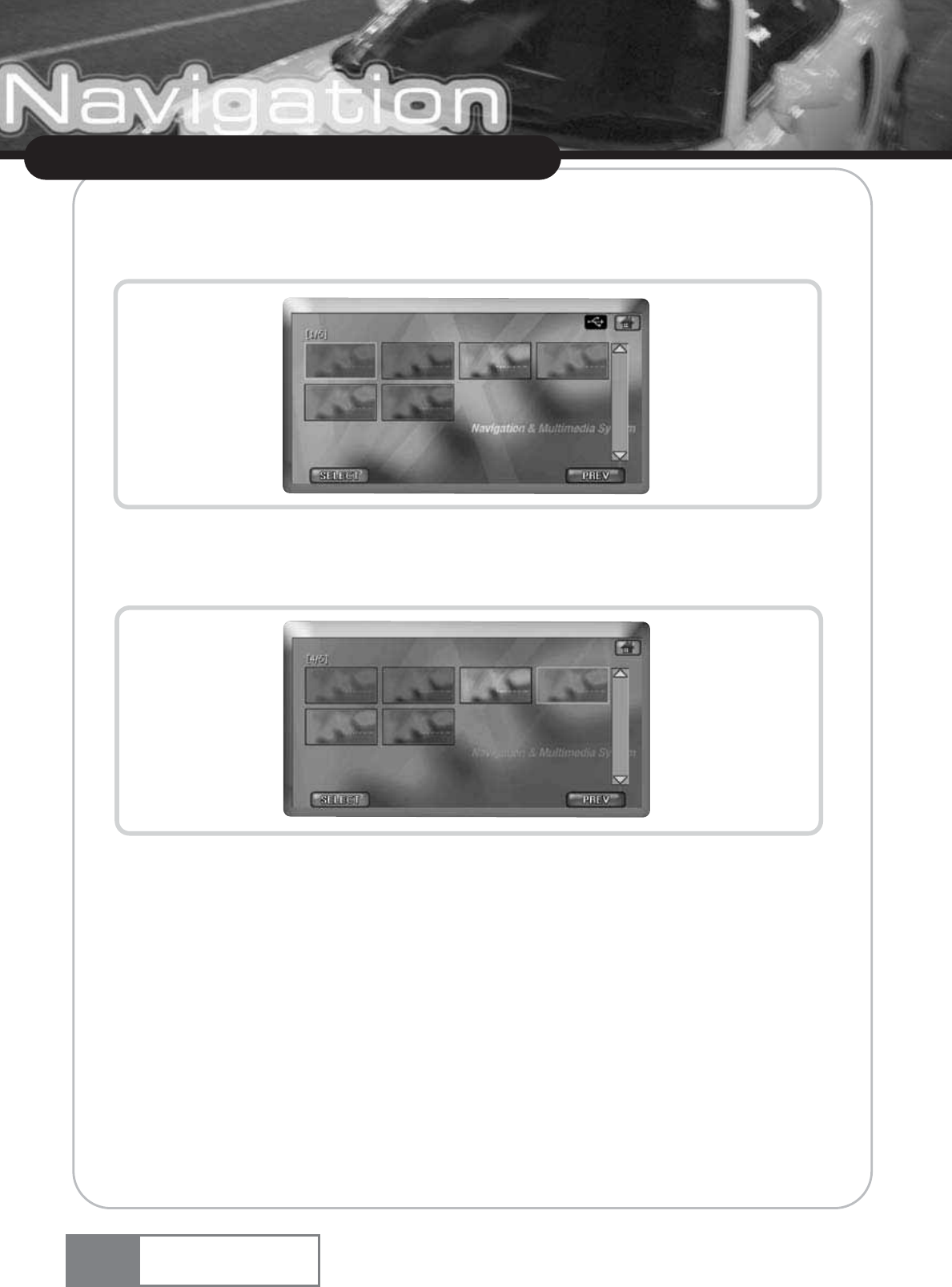
11-2. Background image
You can select the background image you prefer.
1) Select the image to change and press the [SELECT] button.
2) If you press the [Previous] button, the background image will not be changed and the
set up menu will reappear.
48
Using Navigation System
Navigation System
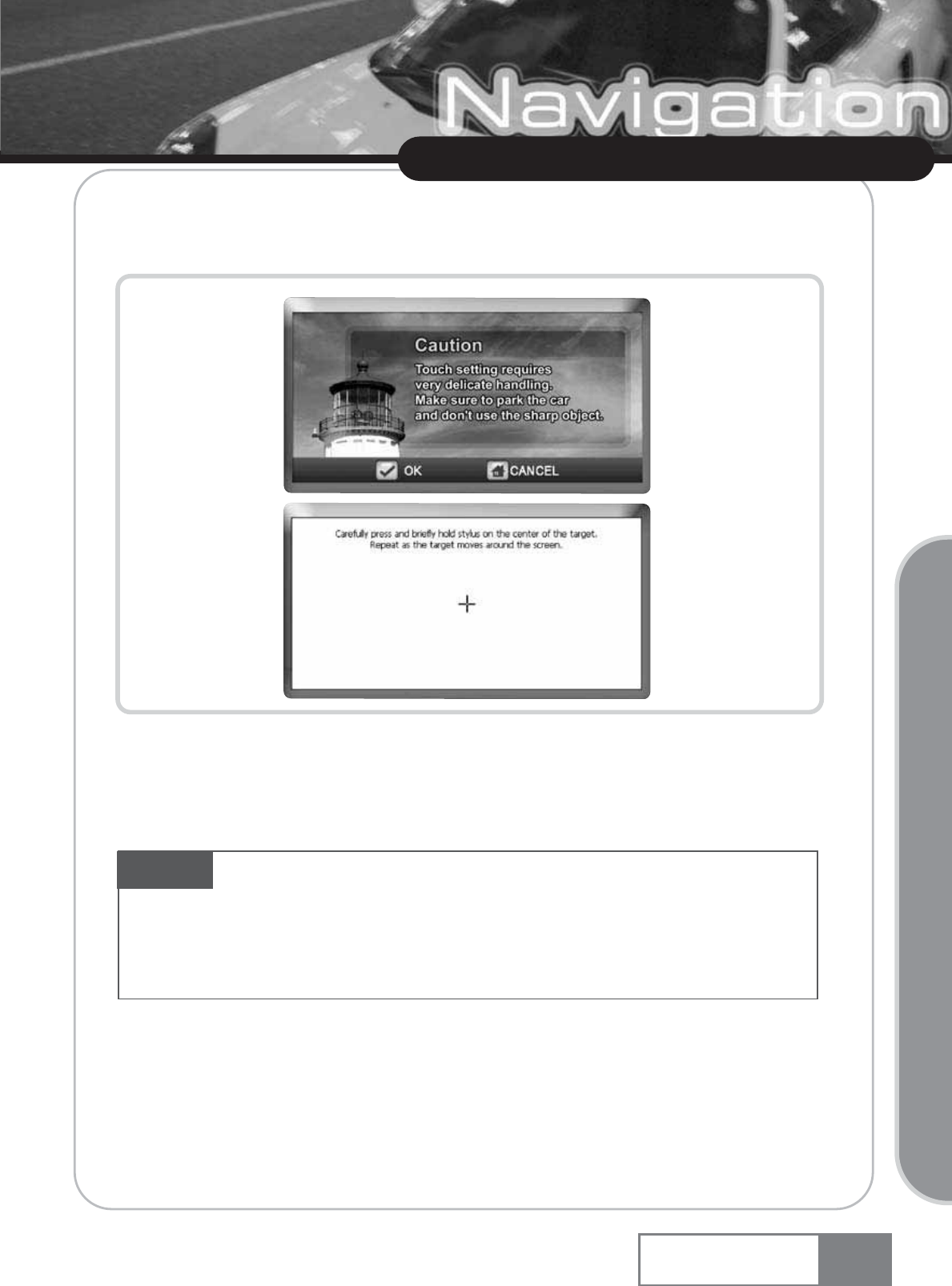
11-3. Touch setting
Touch setting : Select this menu to increase accuracy of the touch screen.
For touch screen setting, press and briefly hold the center of the cross symbol. Then, the cross symbol
will appear at the left upper side, left bottom side, right bottom side, and right upper side one by one.
To complete touchscreen setting, press the center of the cross symbol for 5 times in total.
49
Using Navigation System
Navigation System
Basic Operation
Caution If you press the point that is far away from the cross symbol during touchscreen
setting, the cross symbol will appear indefinitely. Therefore, always stop the car before setting up
the touchscreen setting. Do not use a tool with too sharp tip, since it can damage the touch panel.
Instead, use a round edge object like the test jack for setting.
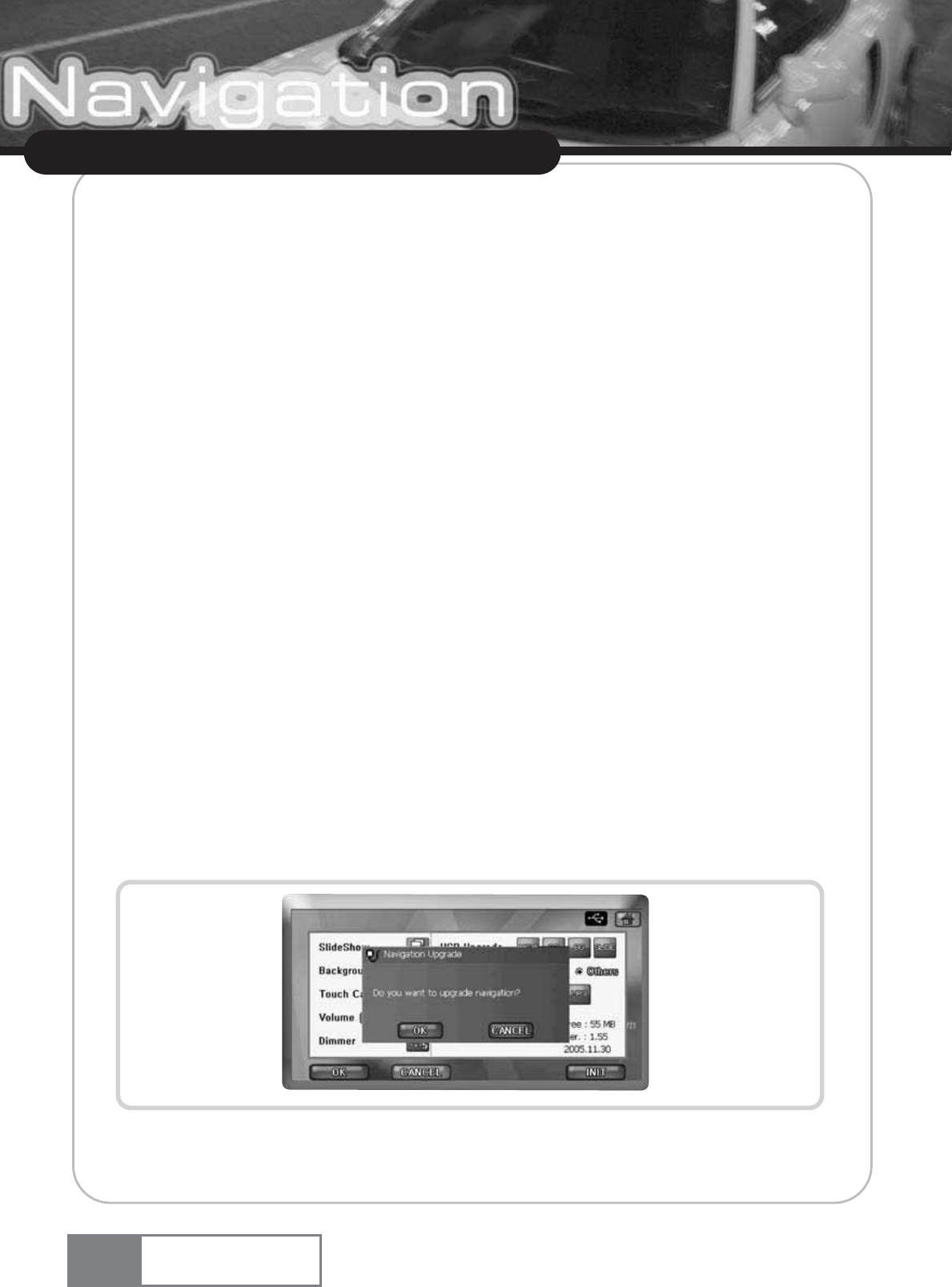
11-4. Volume
You can select from 16 levels of sound volume.
11-5. Dimmer
You can select from 5 levels of screen brightness.
11-6. Upgrade or download using USB memory
You could download navigation map database, OS, background images and slide show images to your
system by using the USB memory stick. Especially, to change the the navigation map in your system, you
have to down another map from DVD-ROM disc provided to USB memory by using V-Up Pro.
And so, If you want to upgrade the latest version of navigation map database and OS for your
system, these could be downloaded from the customer service web site in page 81 and you have to
register at the upgrade web site before upgrading.
ȯNavigation upgrade or download
1) Download and run V-Up Pro from DVD-ROM disc and select USB as a storage media.
2) Save the upgrade or download file in the USB memory.
3) Connect the USB memory to the device. When the USB connection icon appears, select
Navigation Upgrade.
4) Press the [OK] button.
5) When upgrade is complete, restart the unit.
50
Using Navigation System
Navigation System
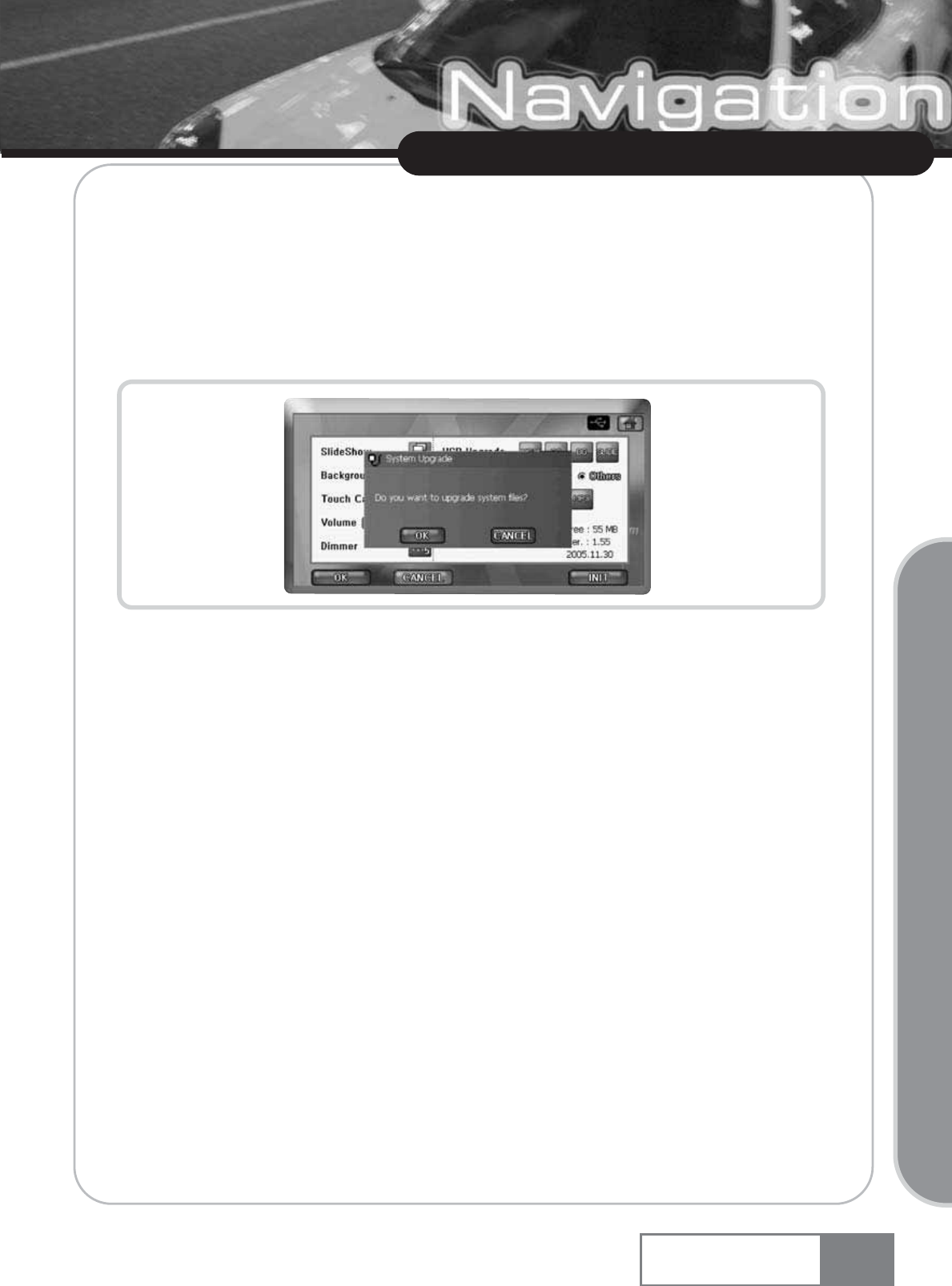
ȯOS upgrade
1) Download and run V-Up Pro from DVD-ROM disc and select USB as a storage media.
2) Save the upgrade file in the USB memory.
3) Connect the USB memory to the device. When the USB connection icon appears,
select OS Upgrade.
4) Press the [OK] button.
5) When upgrade is complete, restart the unit.
ȯBackground download
(Only 480 X 234 size BMP file is supported. You can create a background image
conveniently using the V-Up Pro program that is provided in the DVD-ROM disc.)
1) Create a folder named \upgrade\background\ in the USB memory.
2) Save necessary upgrade files in this folder.
3) Connect the USB memory to the device. When the USB connection icon appears,
select Background Image Upgrade.
51
Using Navigation System
Navigation System
Basic Operation
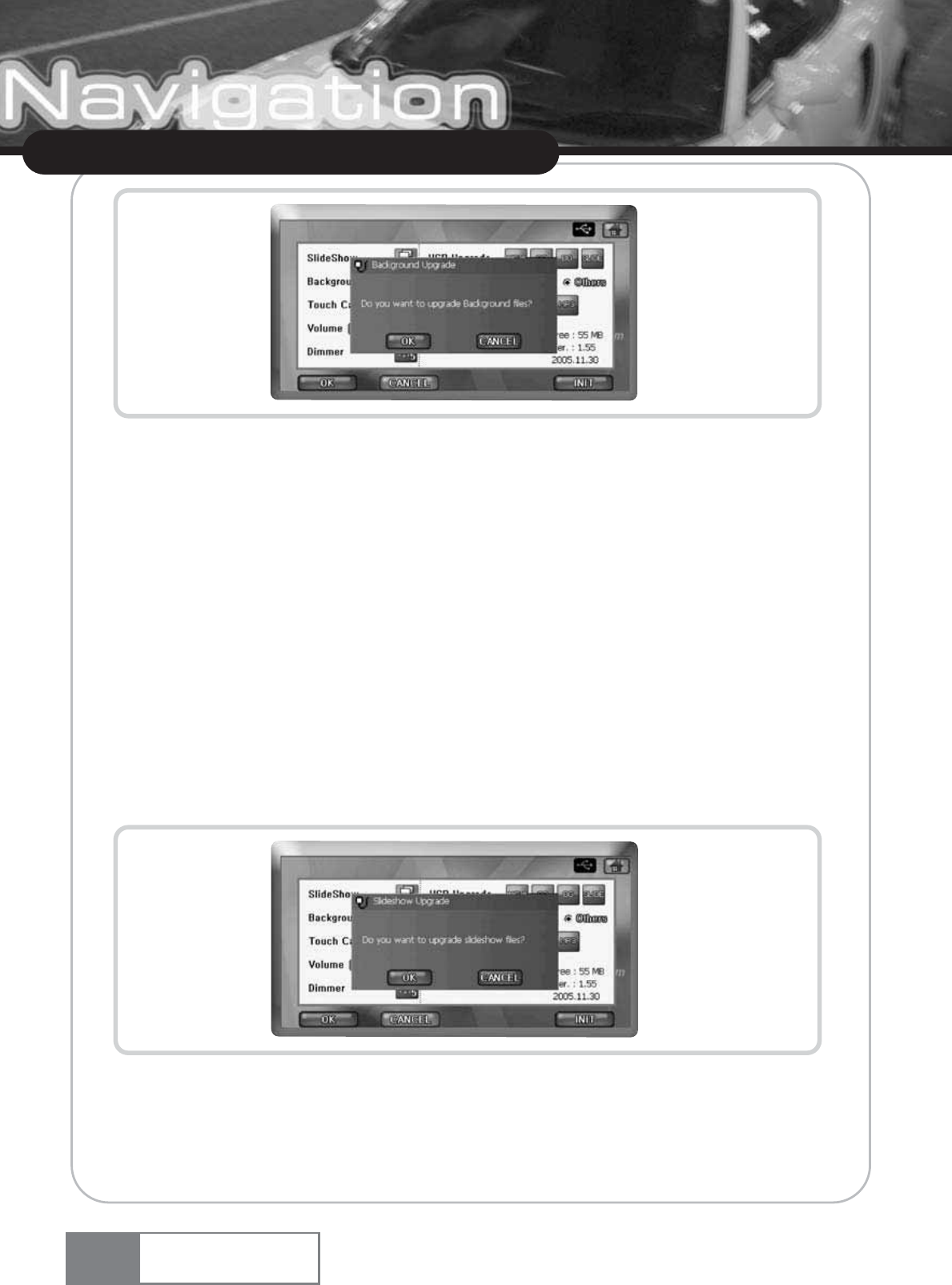
4) Press the [OK] button.
ȯSLIDE download
(Only 480 X 234 size BMP or JPG file is supported. You can create the slide show file
conveniently using the V-Up Pro program that is provided in the DVD-ROM disc.)
1) Create a folder named ’\UPGRADE\SLIDESHOW\’ in the USB memory.
2) Save necessary upgrade files in this folder.
3) Connect the USB memory to the device. When the USB connection icon appears,
select Slide Show Upgrade.
4) Press the [OK] button.
52
Using Navigation System
Navigation System
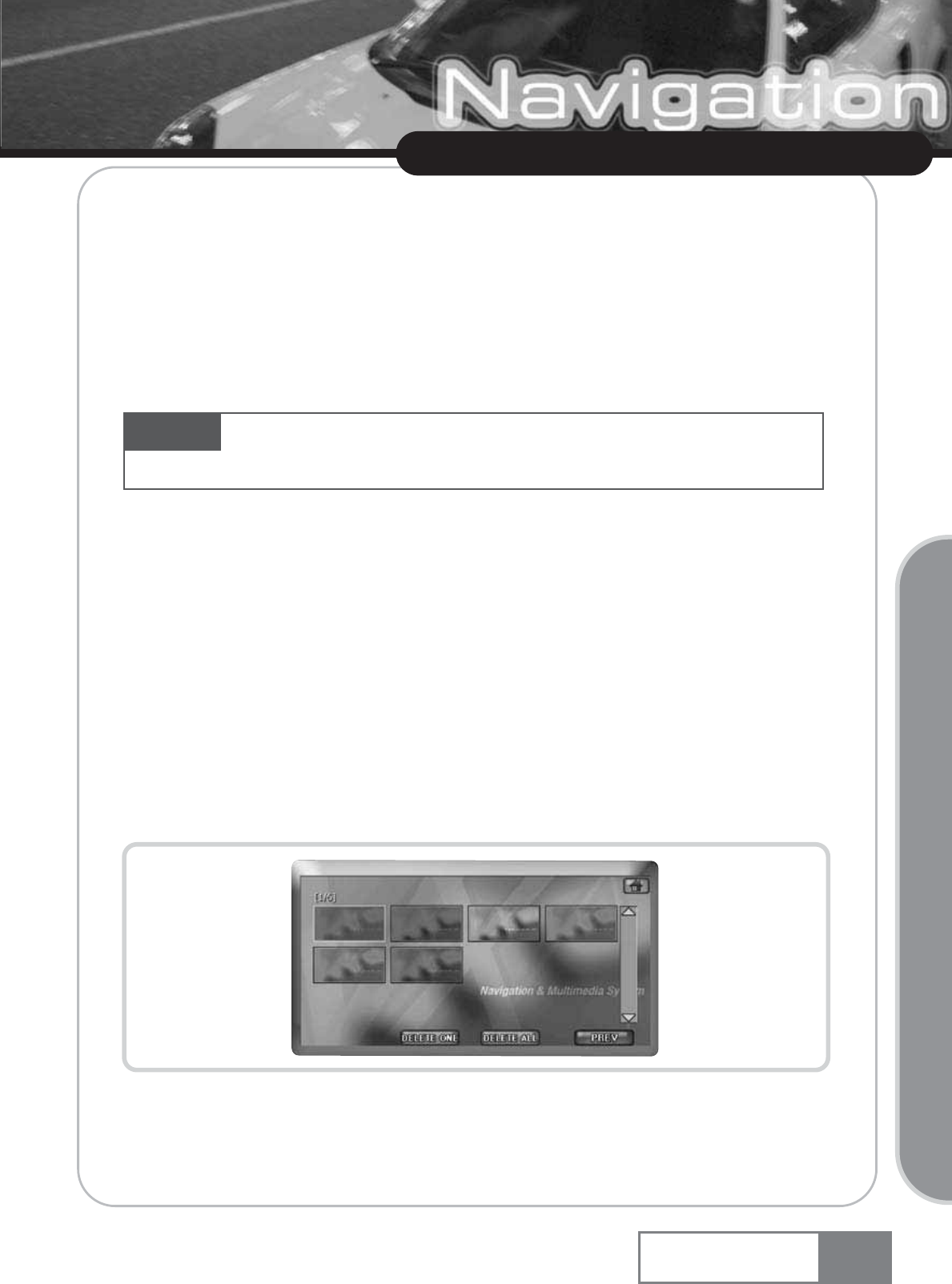
ȯUpgrade will fail if you try to upgrade when the internal memory is not sufficient, or
the external USB memory is not available, or no upgrade files are saved in the USB
memory.
If the internal memory capacity is insufficient, delete some files to secure enough
memory space. When upgrading, see if upgrade files are saved in the USB memory,
and the USB memory is connected properly.
11-7. A/V Input
In Aux mode. You can control the DVD player using this device, when the DVD player is a VXM or
VXD series. To connect other manufacturer’s product, set to ’Others’. Default value is ’Others’.
11-8. Delete file
Using this menu, you can delete the file inside the internal memory.
1) Deleting the background image file
ȯPress the [Delete] button to delete the selected file only, or press the [Delete All] button to
delete all background image files.
53
Using Navigation System
Navigation System
Basic Operation
Caution Make sure to fully understand the instructions provided with upgrade files, since failed
upgrade may result in product malfunction.
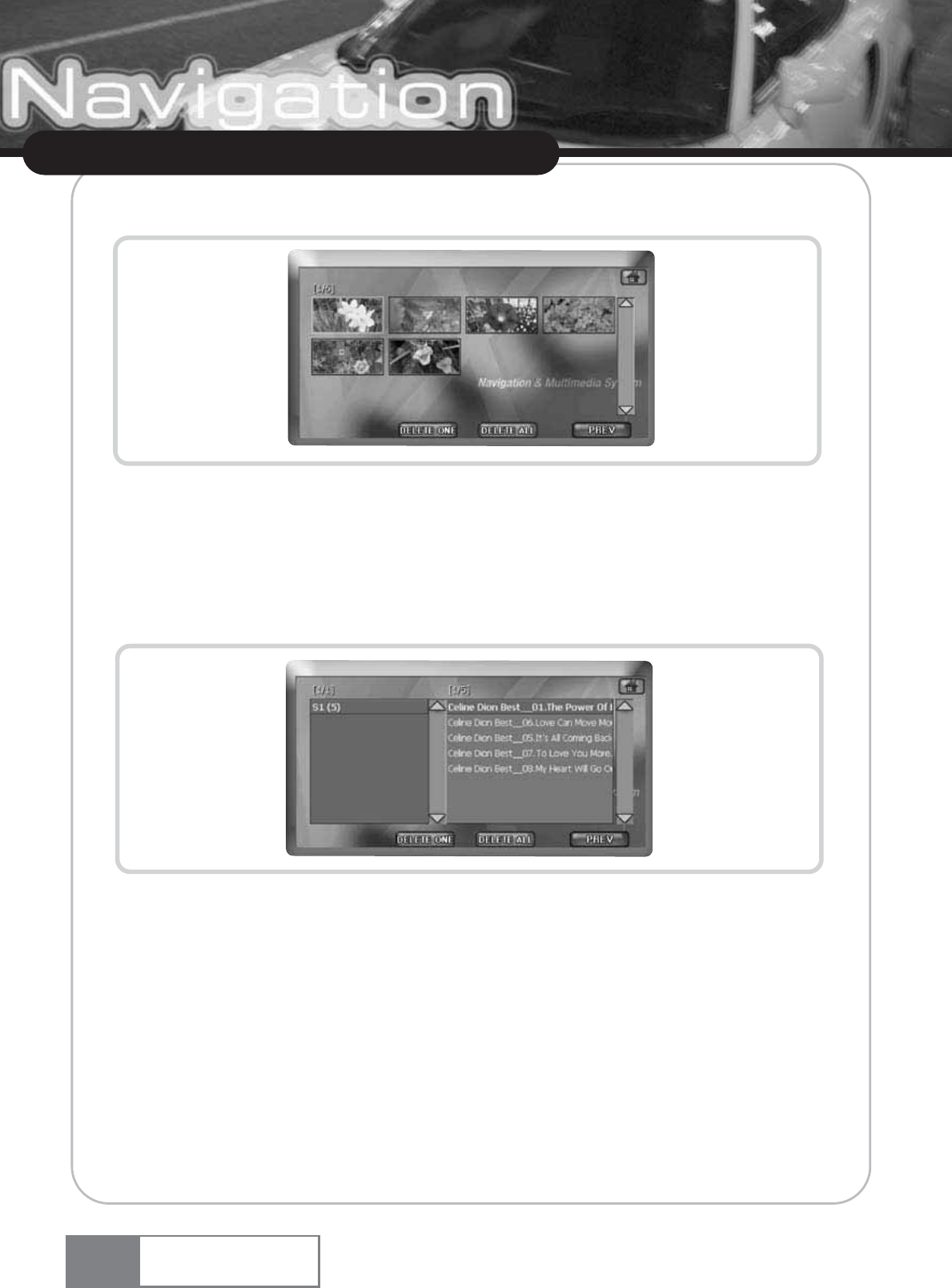
2) Deleting the slide show file
ȯPress the [Delete] button to delete the selected file only, or press the [Delete All]
button to delete all slide show files.
3) Deleting the music file
ȯPress the [Delete] button to delete the selected file only, or press the [Delete All]
button to delete all music files in the album.
54
Using Navigation System
Navigation System
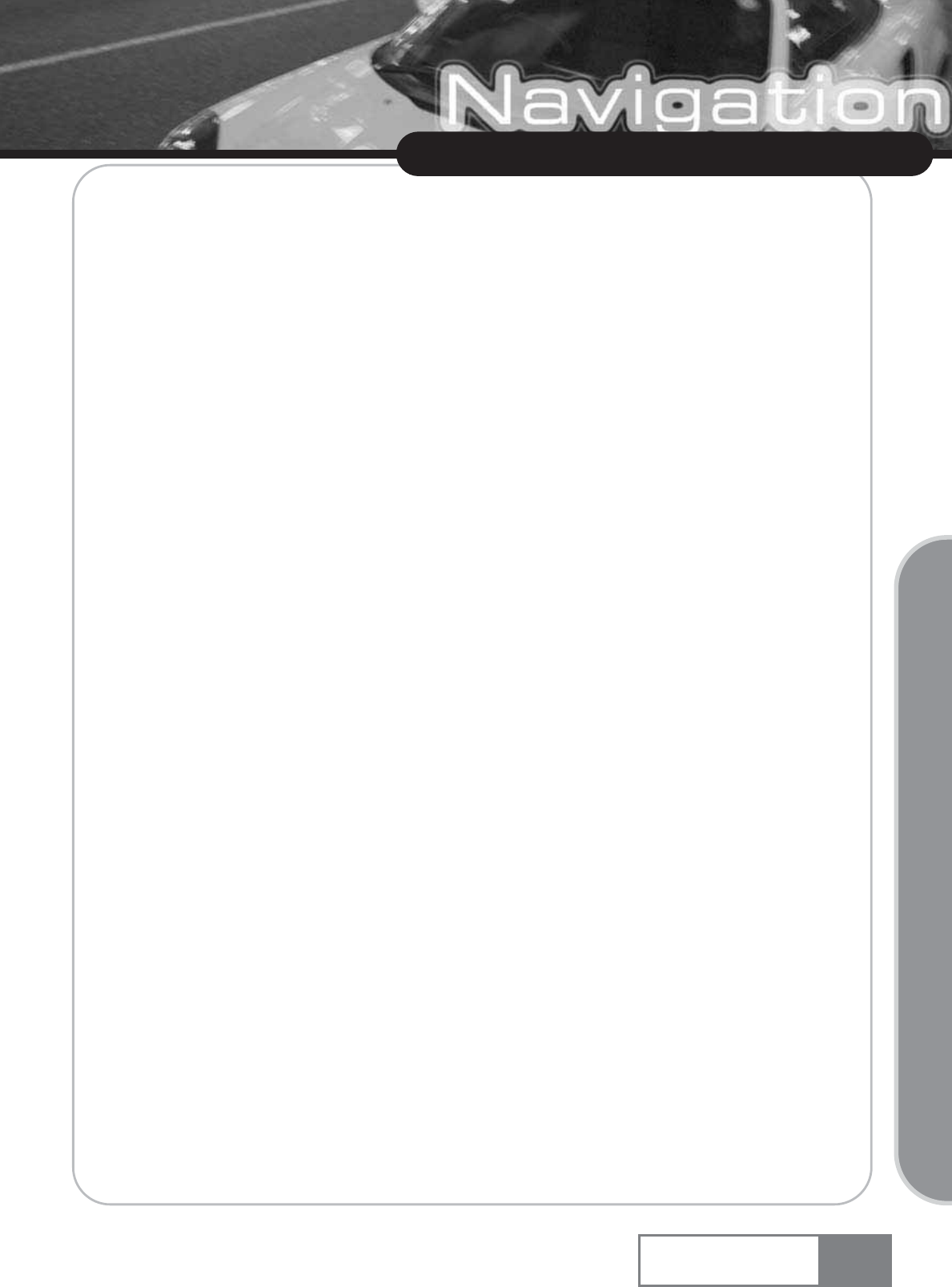
11-9. Confirm settings
You can save all settings by pressing this button.
11-10. Cancel settings
You can cancel all settings you made by pressing this button.
11-11. Restore default
The factory default setting will be restored, if you press this button.
55
Using Navigation System
Navigation System
Basic Operation
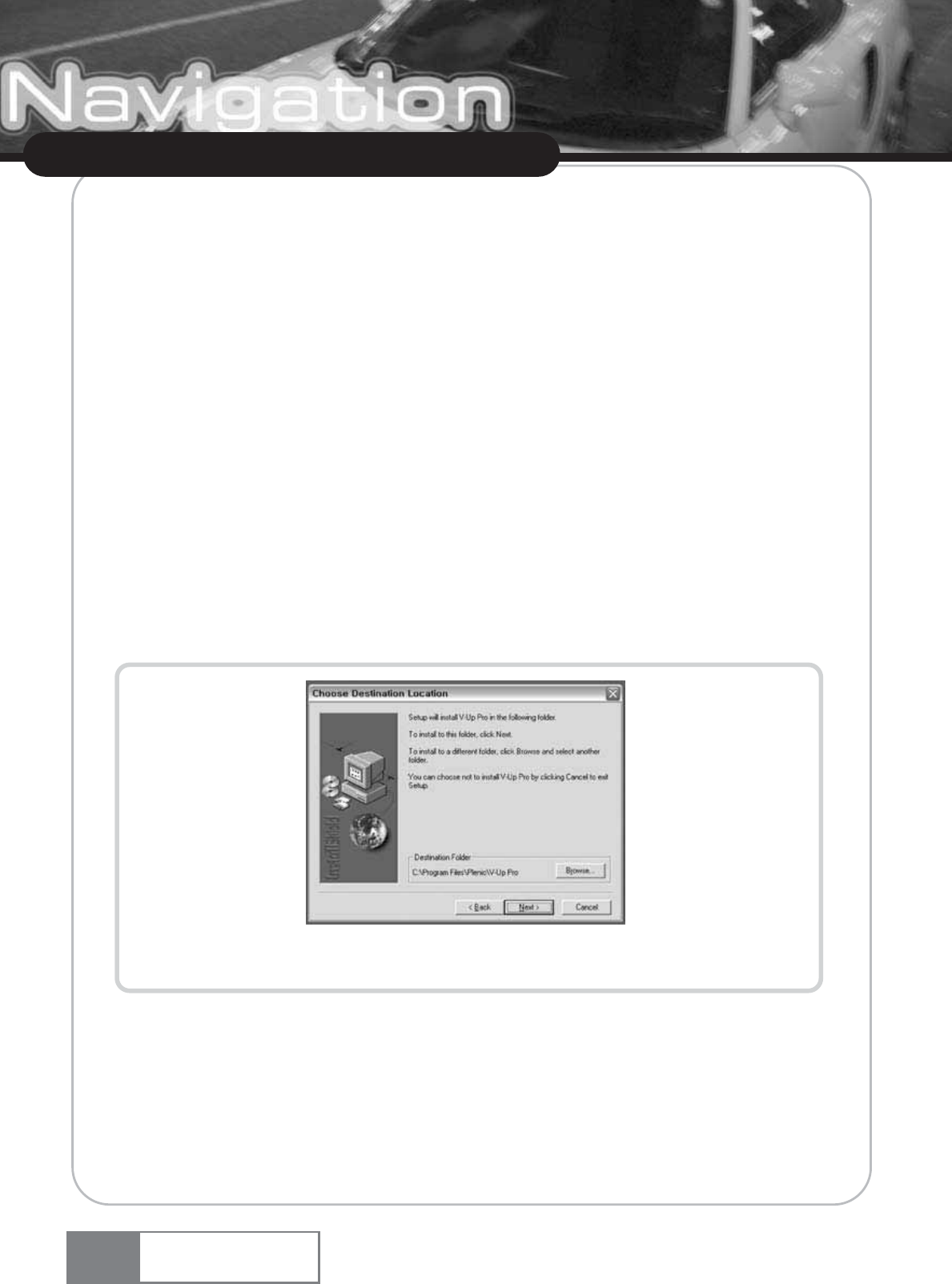
1. Installing ActiveSync and V-Up Pro Program
1-1. Install ActiveSync Program
A. Execute ActiveSync installation file (MSASYNC_3_8.EXE) in DVD-ROM disc provided.
B. Carry out ActiveSync program installation.
C. Connect the navigation set to PC using USB cable.
D. If PC find unknown device, update device using device driver file (wceusbsh.inf) in DVD-ROM disc.
ƕIf device update correctly, you could see the device information at device manager.
(Device name : DVS Korea USB EZ-Link Cable)
1-2. Install V-Up Pro Program
A. Execute V-Up Pro installation file in DVD-ROM disc and carry out the following installation
procedure.
B. Specify the installation folder. See Figure 1-1.
Figure 1-1. Specifying V-Up Pro installation folder
56
V-Up Pro
Navigation System
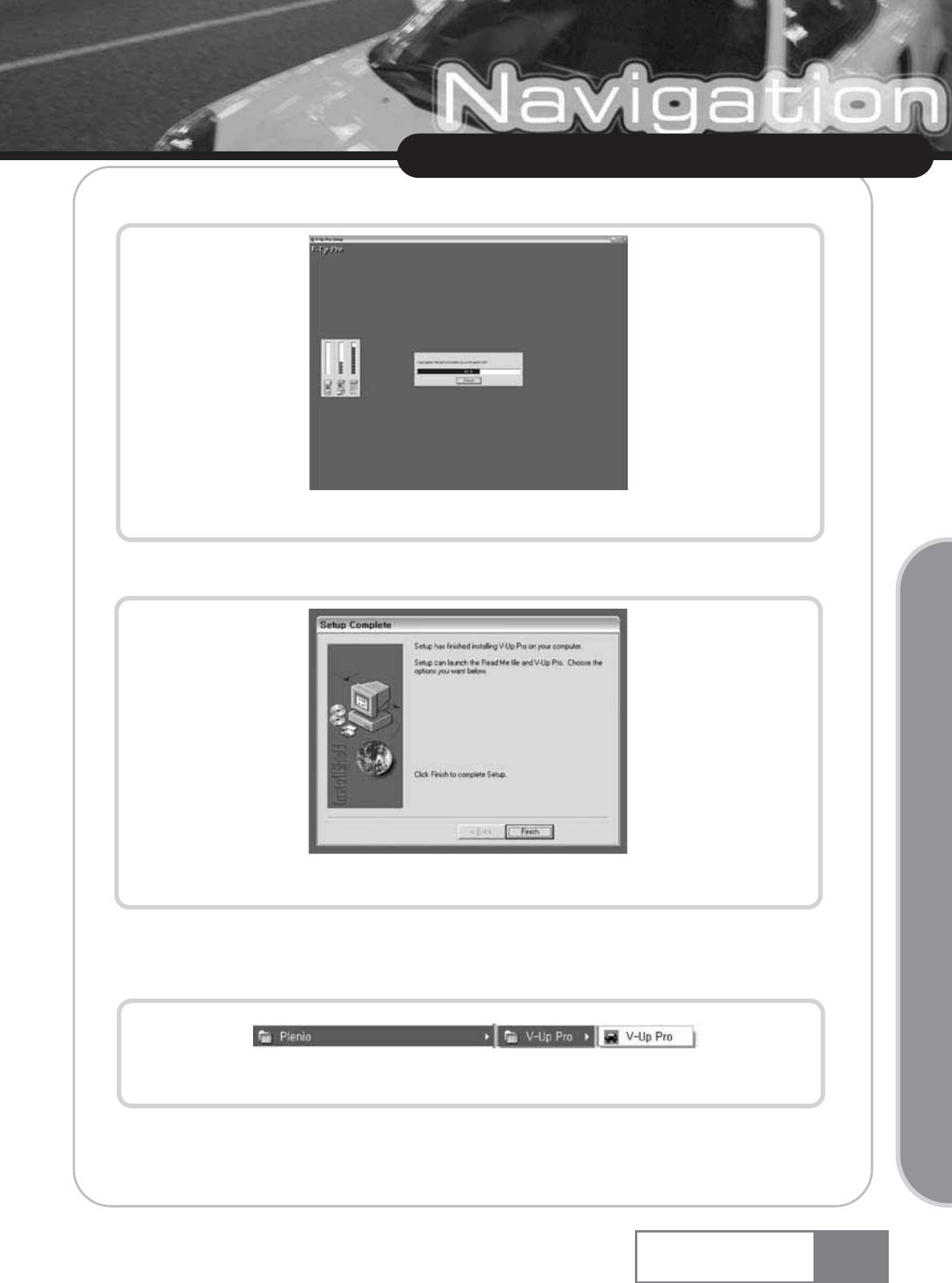
C. Program installation will be started. See Figure 1-2.
Figure 1-2. V-Up Pro Installation Progress
D. If successfully installed, the ūSetup CompleteŬmessage will be displayed. See Figure 1-3.
Figure 1-3. Completion of V-Up Pro installation
E. The following program group and the shortcut icon will be created in Programs menu as
shown in Figure 1-4.
Figure 1-4. V-Up Pro shortcut icon
ƕIf you need technical support and download the latest version, please contact the your
retail store or visit customer service web site in page 81.
57
V-Up Pro
Navigation System
V-Up Pro
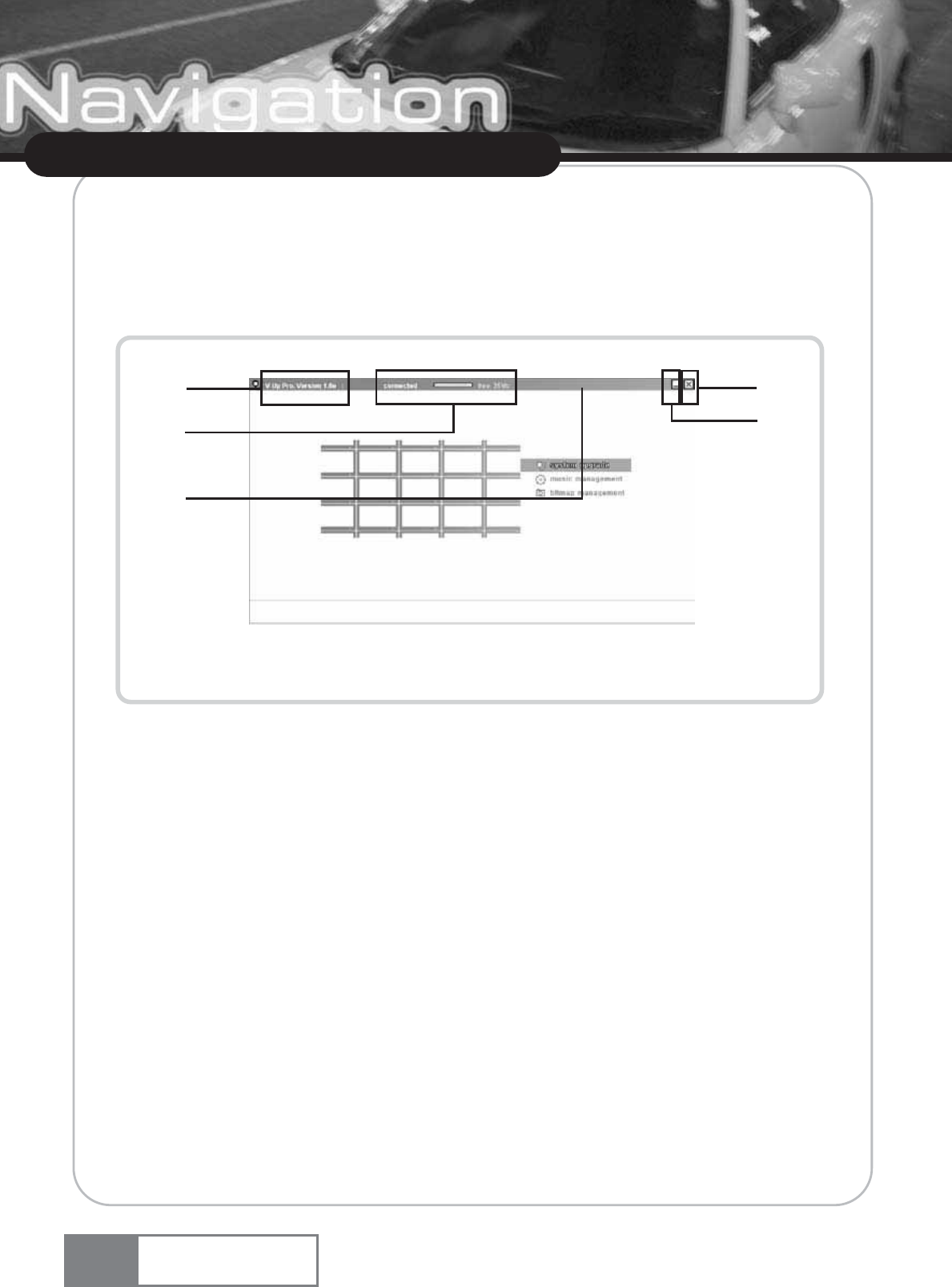
V-Up Pro
2. Running V-Up Pro Program
A. Select Start آPrograms آPlenio آV-Up Pro آV-Up Pro shortcut icon.
B. V-Up Pro will be started. See Figure 2-1.
Figure 2-1. V-Up Pro main screen
ڸV-Up Pro program version
ڹConnection status and remaining memory capacity
ںMinimize window button
ڻClose window button
ڼTitle Bar: You can move the V-Up Pro program window.
Navigation System
58
ڡ
ڢ
ڥ
ڣ
ڤ
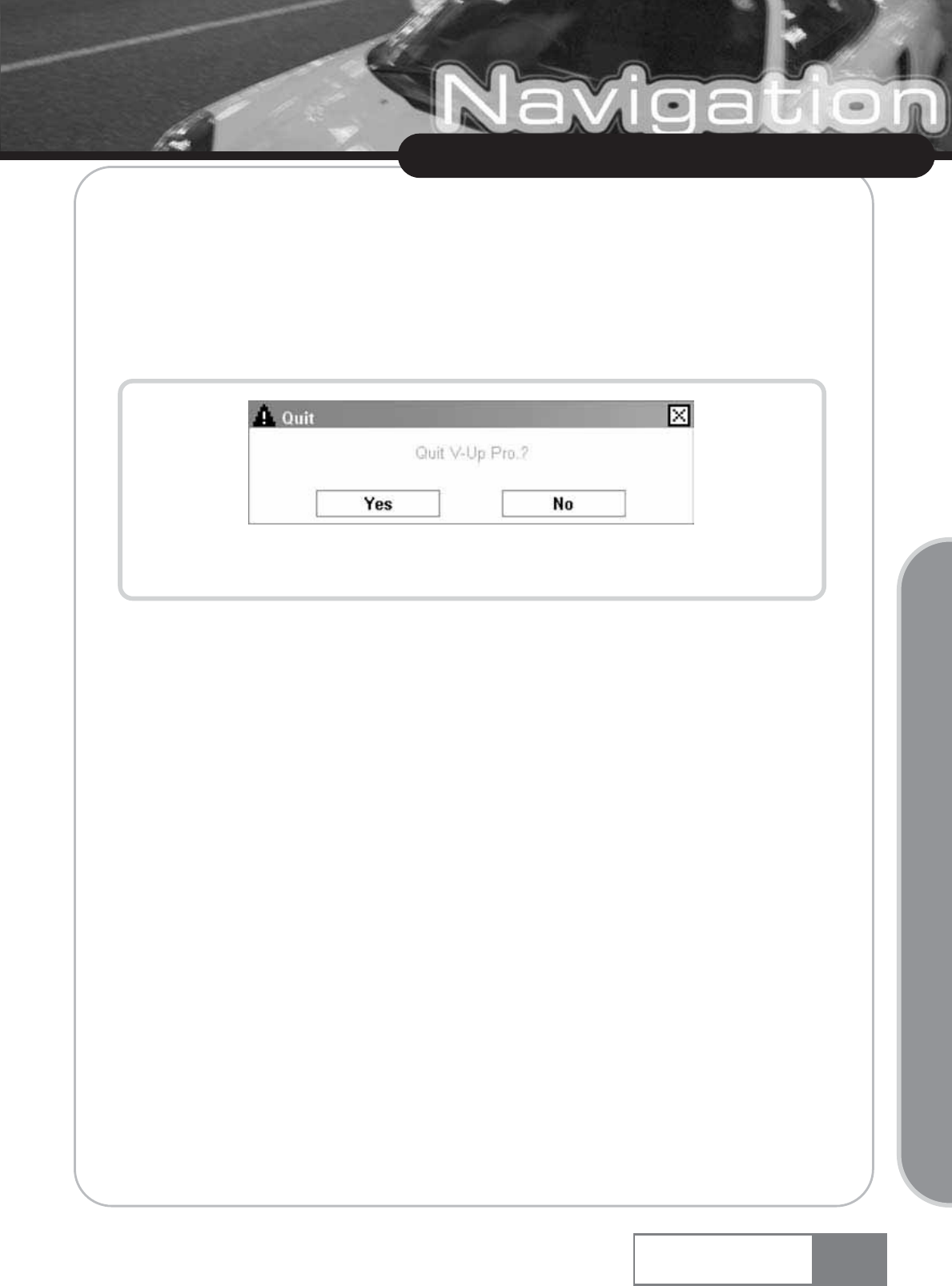
V-Up Pro
V-Up Pro
3. Closing V-Up Pro Program
A. When you click the [Close] button, the program closing confirmation window will appear as
shown in Figure 3-1.
B. Click [Yes] to exit from V-Up Pro program.
Figure 3-1. V-Up Pro closing confirmation window
Navigation System 59
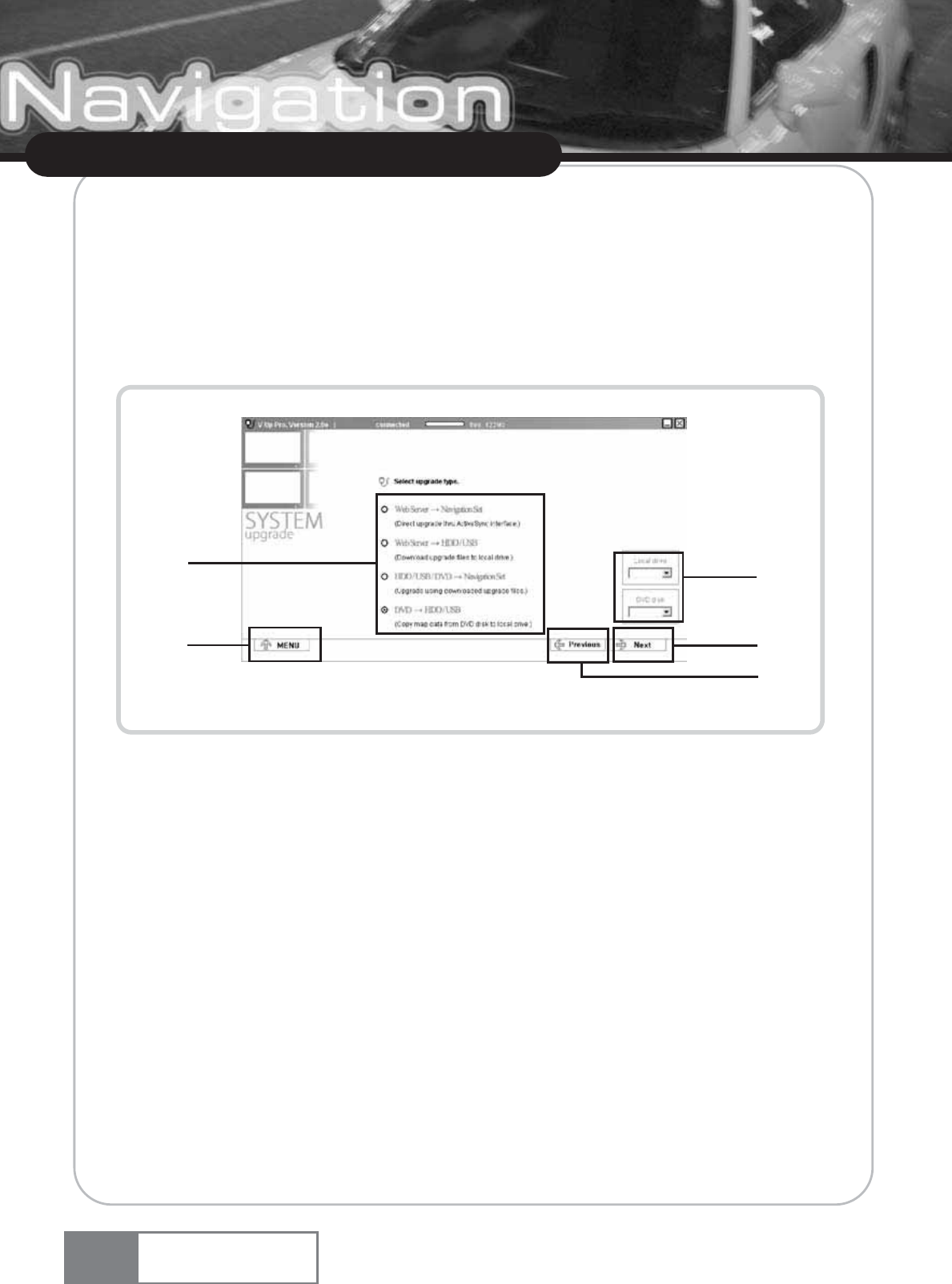
V-Up Pro
4. System Upgrade
A. Execution
A-1) Click the ūSystem UpgradeŬicon in the V-Up Pro main screen.
A-2) Then, the screen shown in Figure 4-1 will appear.
Figure 4-1. System upgrade running screen
ڸSelect the upgrade type (radio button)
ڹLocal drive and DVD-ROM disc selection combo box
ں[Move Previous] button
ڻ[Move Next] button
ڼ[Move to V-Up Pro Main Menu] button
Navigation System
60
ڡڢ
ڥ
ڣ
ڤ
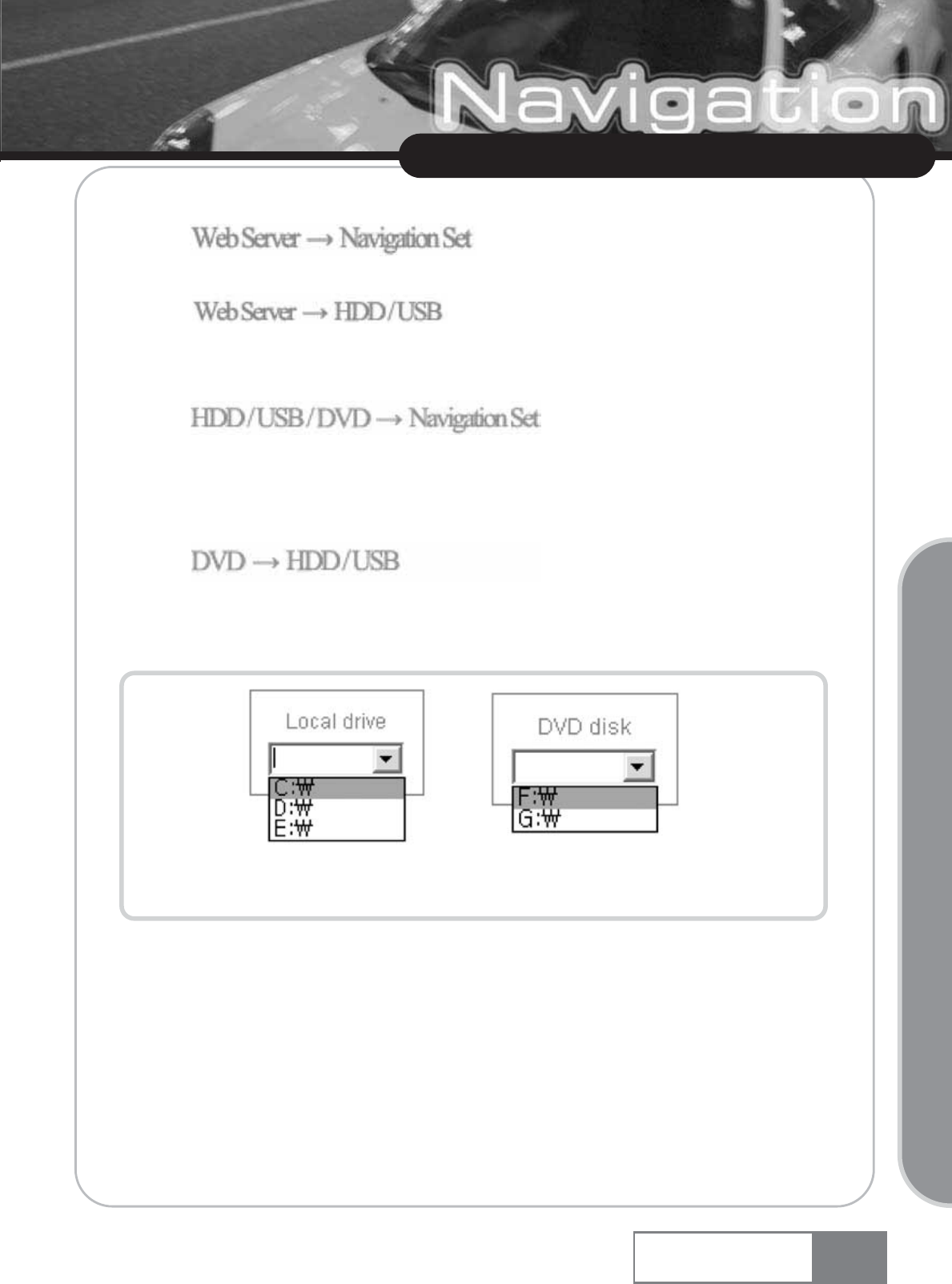
V-Up Pro
V-Up Pro
A-3) Select the upgrade type using the radio button shown in Figure 4-1.
Transfers upgrade files directly to the navigation set through ActiveSync connection.
Saves upgrade files in the local drive specified by the user.
(See Figure 4-2 for specifying the local drive.)
Reads upgrade files from the user-specified local drive and transfers them to the
navigation set.
(See Figure 4-2 for specifying the local drive.)
Reads upgrade files from the user-specified DVD-ROM disc and transfers them to local drive.
(See Figure 4-2 for specifying the local drive and DVD-ROM disc.)
Figure 4-2. Specifying local drive and DVD-ROM disc
A-4) Move to the next step by clicking the [Next] button (Figure 4-1 ڻ) after selecting the
upgrade type.
Navigation System 61
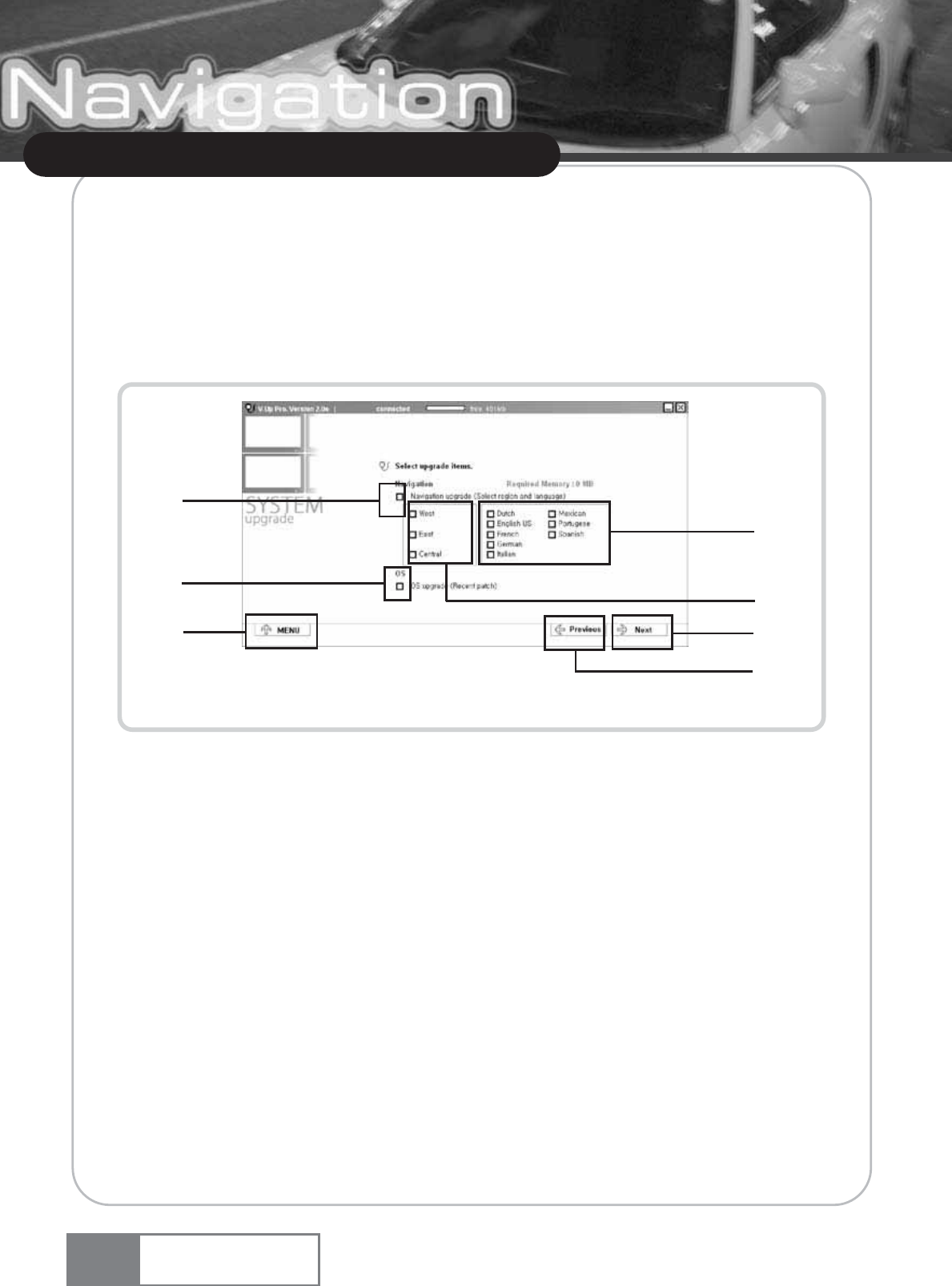
V-Up Pro
B. Selecting upgrade items
ƕUpgrade selection window will appear only when ūUpgrade directlyŬor ūDownload
upgrade filesŬis selected.
B-1) Select the item to upgrade using the ūSelect upgrade itemsŬcheck box (Figure 4-3 ڸ).
(Navigation, OS)
Figure 4-3. Upgrade items selection window
ڸNavigation selection check box
ڹOS selection check box
ںMap coverage selection check box
ڻVoice Language selection check box
ڼ[Move Previous] button
ڽ[Move Next] button
ھ[Move to V-Up Pro Main Menu] button
Navigation System
62
ڡ
ڣ
ڧڦ
ڤ
ڢ
ڥ
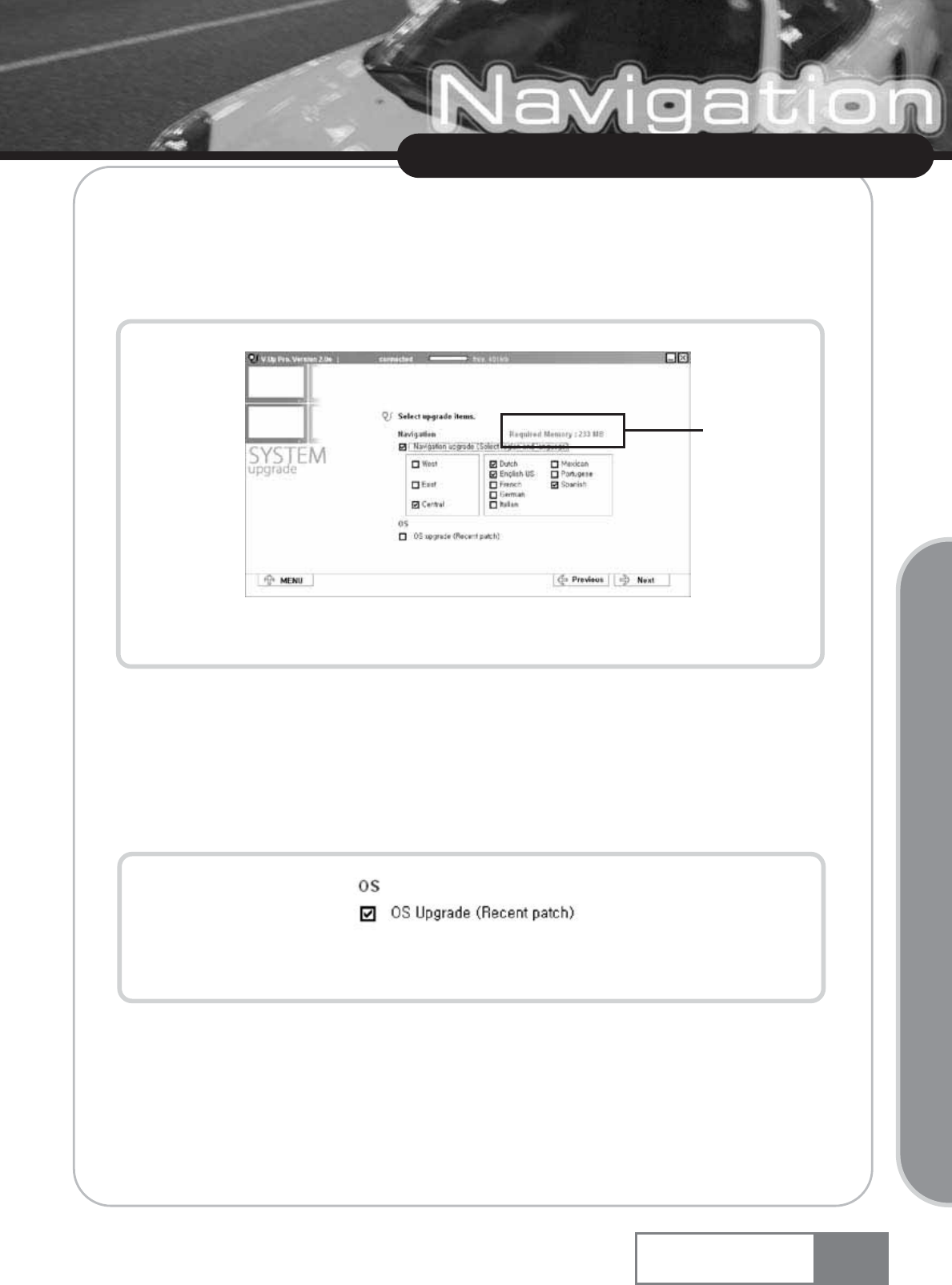
V-Up Pro
V-Up Pro
B-2) To upgrade the navigation, select the navigation selection check box (Figure 4-3 ڸ) and
select the target area using the map coverage and voice language check box (Figure 4-3 ں).
See Figure 4-4.
Figure 4-4. Navigation data selection screen
ڸCalculate and display checked componentsŪmemory.
B-3) To upgrade to the latest OS, select the OS selection check box (Figure 4-5) and click the
[Next] button (Figure 4-3 ڽ).
Figure 4-5. OS upgrade selection screen
Navigation System 63
ڡ
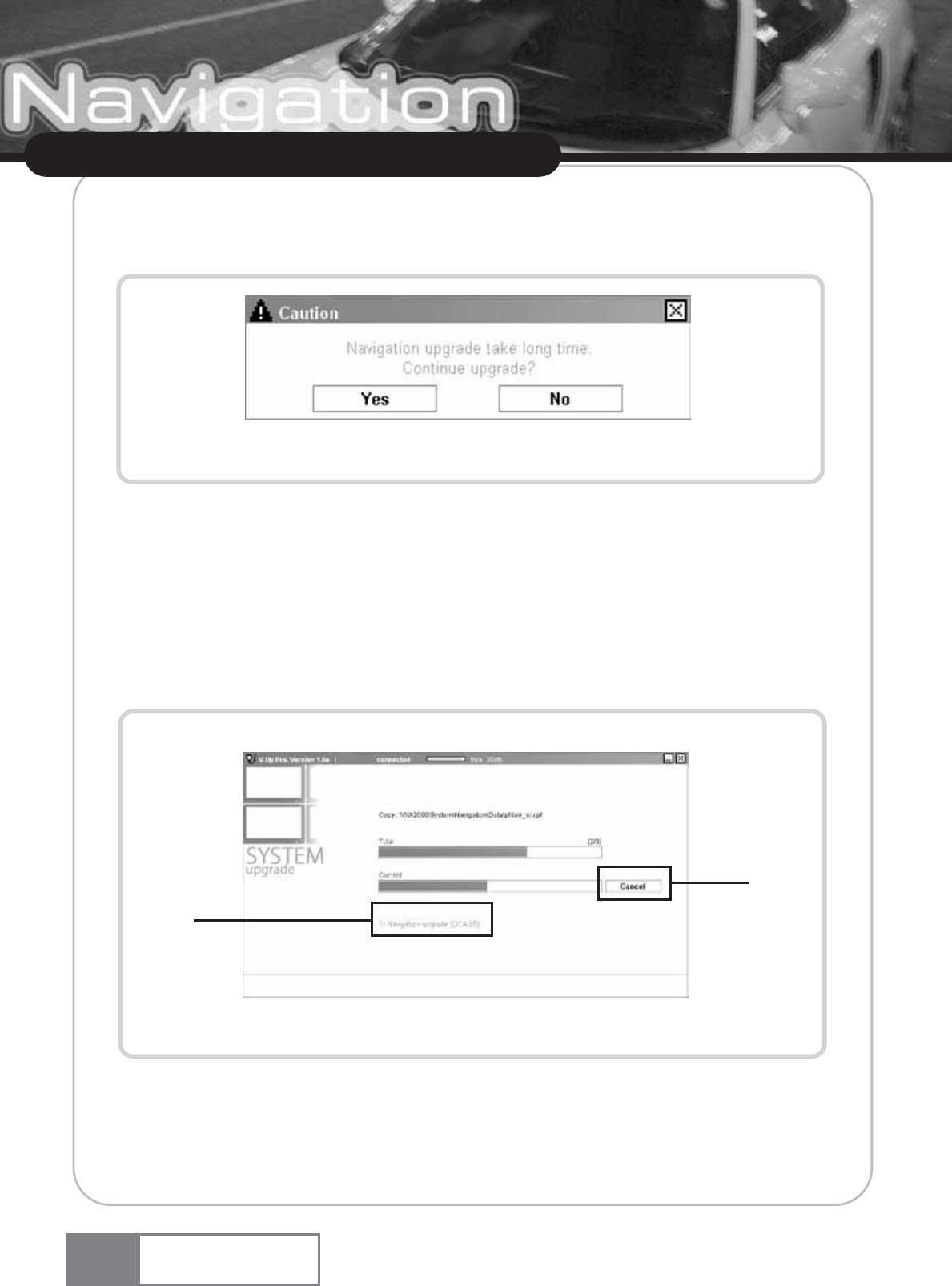
ƕThe alarm message window appears when navigation upgrade is selected (Figure 4-6).
Select the [Yes] button to continue upgrade.
Figure 4-6. Navigation upgrade alarm window
C. Upgrade
C-1) If the upgrade type and item are properly selected, the upgrade progress screen will
appear as shown in Figure 4-7.
ƕThe selected upgrade item list will appear at the Figure 4-7 ڹposition.
Figure 4-7. Upgrade progress screen
ڸUpgrade cancellation button
ڹUpgrade list display section
V-Up Pro
Navigation System
64
ڢ
ڡ
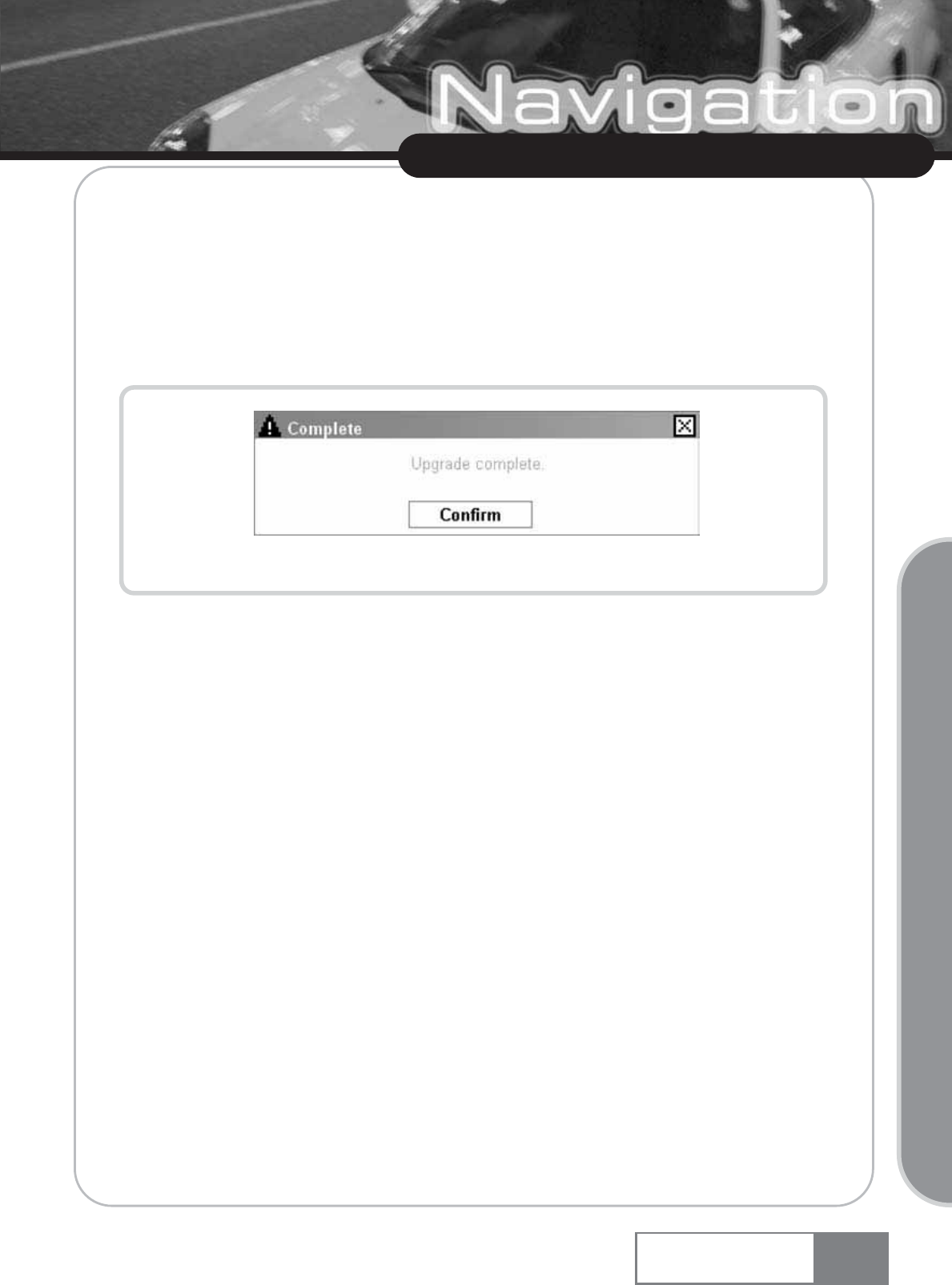
C-2) Click the [Cancel] button (Figure 4-7 ڸ) to stop upgrading and return to the previous step.
D. Upgrade completion
D-1) When upgrade is complete successfully, the Complete message window shown in Figure
4-8 will appear.
Figure 4-8. Upgrade complete message window
V-Up Pro
V-Up Pro
Navigation System 65
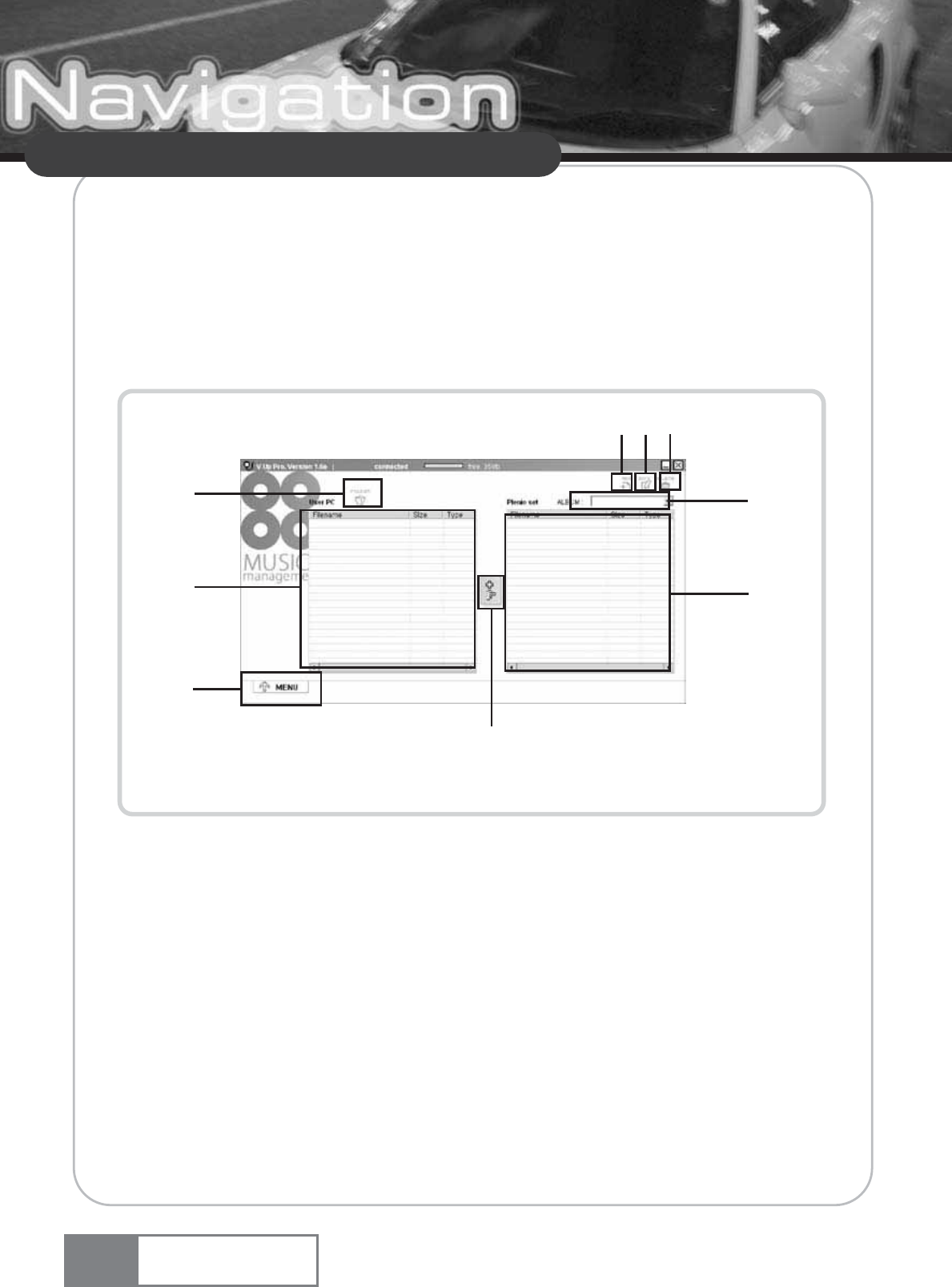
V-Up Pro
5. Music Management
A. Execution
A-1) Click the ūMusic ManagementŬicon in the V-Up Pro main screen.
A-2) The screen shown in Figure 5-1 will appear.
Figure 5-1. Music Management execution screen
ڸOpens the music file from the user PC.
ڹCreates a music album in the navigation set.
ںEdits a music album in the navigation set.
ڻDeletes a music album, and music file selection in the navigation set.
ڼSelects the music album in the navigation set.
ڽCopies the music file.
ھDisplays the music file in the user PC.
ڿDisplays the music file in the navigation set.
(Displays the music file in the selected album.)
ۀMoves back to the V-Up Pro main menu.
Navigation System
66
ک
ڨ
ڧ
ڡ
ڦ
ڥ
ڢڣڤ
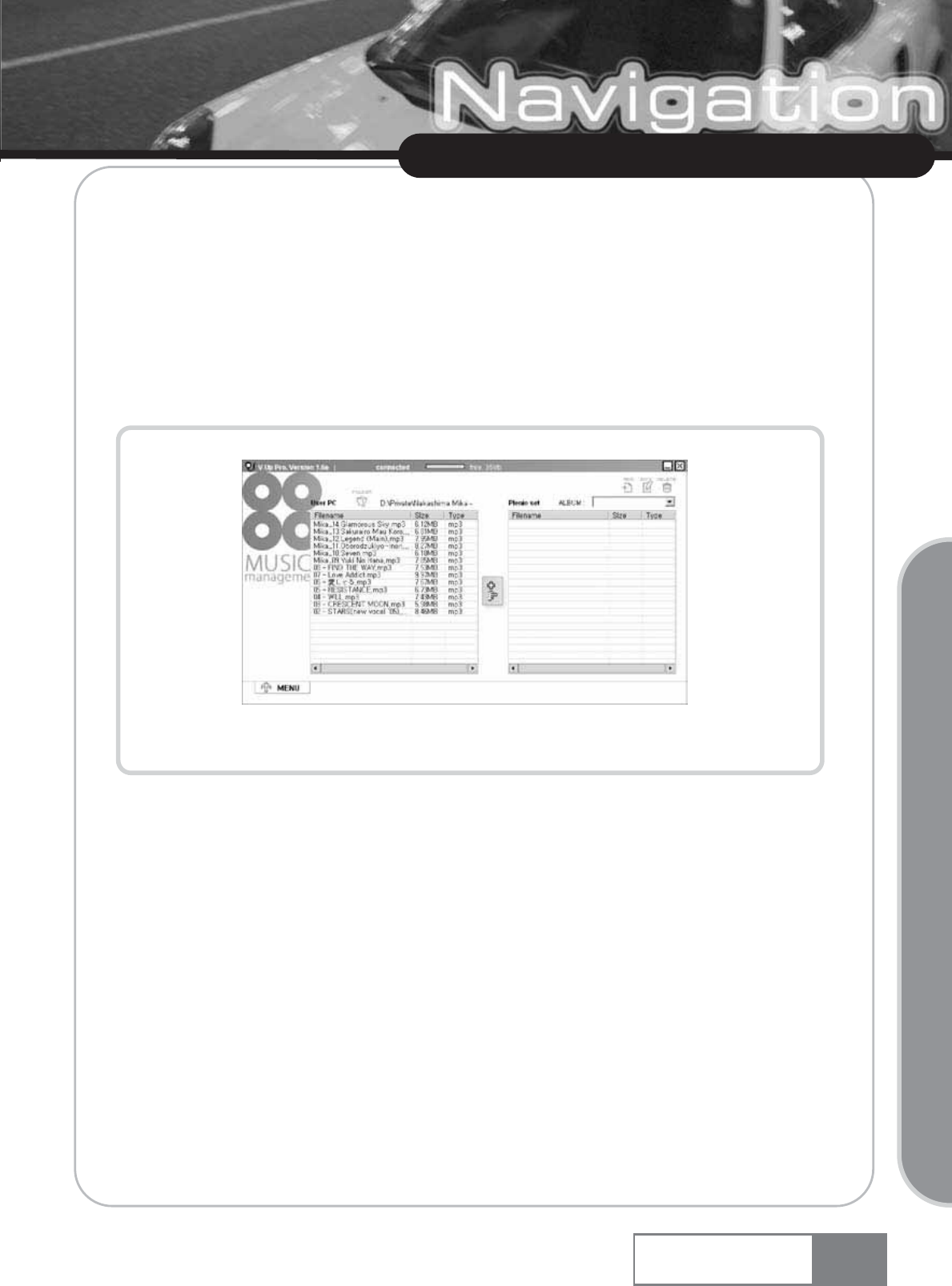
V-Up Pro
V-Up Pro
B. Opening music file from user PC
B-1) Click the ūOpen Music FileŬbutton (Figure 5-1 ڸ) and select the music file folder in the
user PC.
B-2) If any music file is available in the selected folder, it will be displayed in the music file list
window. See Figure 5-2.
ƕSupported music file type: MP3, WMA,WAV.
Figure 5-2. Displaying the music file in the user PC
Navigation System 67
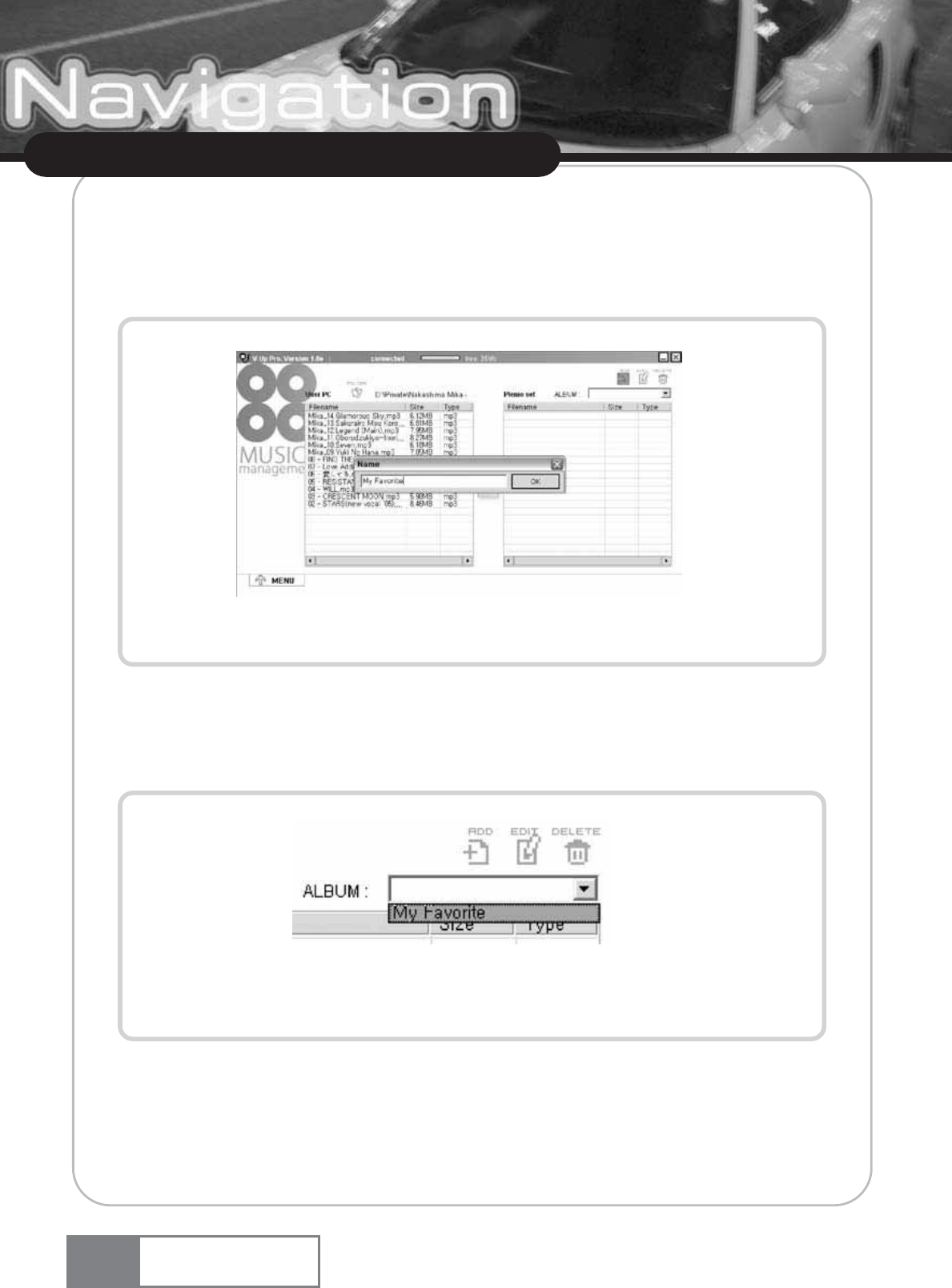
V-Up Pro
C. Creating and selecting music album in the navigation set
C-1) Click the ūCreate music albumŬbutton (Figure 5-1 ڹ) and input the name of the album to
create in the ūNameŬinput window. (See Figure 5-3.)
Figurer 5-3. Music album name input window
C-2) Click [OK] to register the album name in the music album selection input combo box
(Figure 5-1 ڼ). See Figure 5-4.
Figure 5-4. Music album selection combo box
C-3) Select the album from the music album selection combo box. (If any music file is available
in the selected music album, it will be displayed in the music file list window.)
Navigation System
68
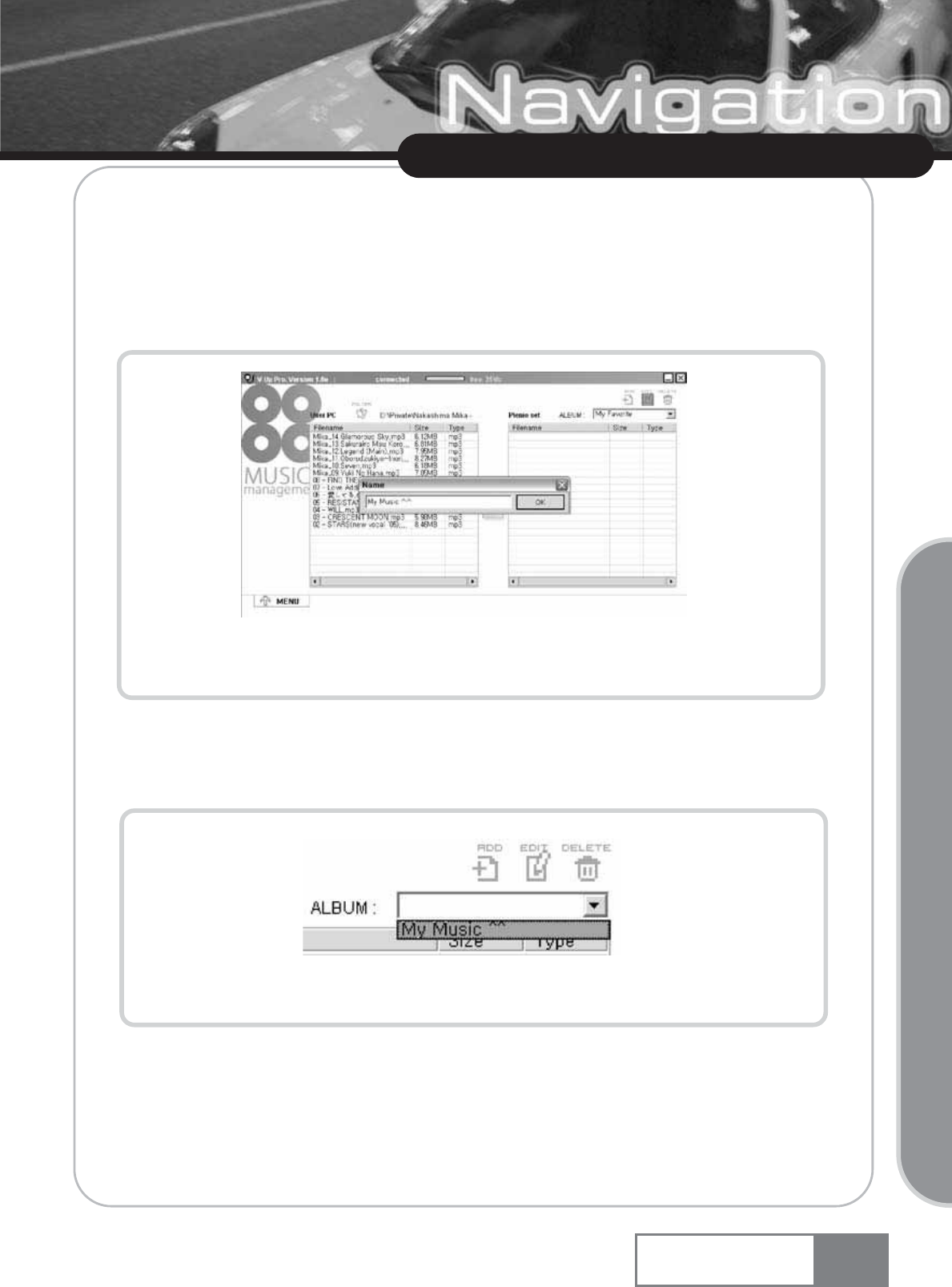
V-Up Pro
V-Up Pro
D. Editing music album in the navigation set
D-1) Select the music album to change its name from the music album selection combo box.
D-2) Click the ūEdit music albumŬbutton (Figure 5-1 ں) and input the album name to change.
See Figure 5-5.
Figure 5-5. Music album name edit window
D-3) Click the [OK] button to register the edited album name in the music album selection
combo box. See Figure 5-6.
Figure 5-6. Edited music albums selection combo box
Navigation System 69
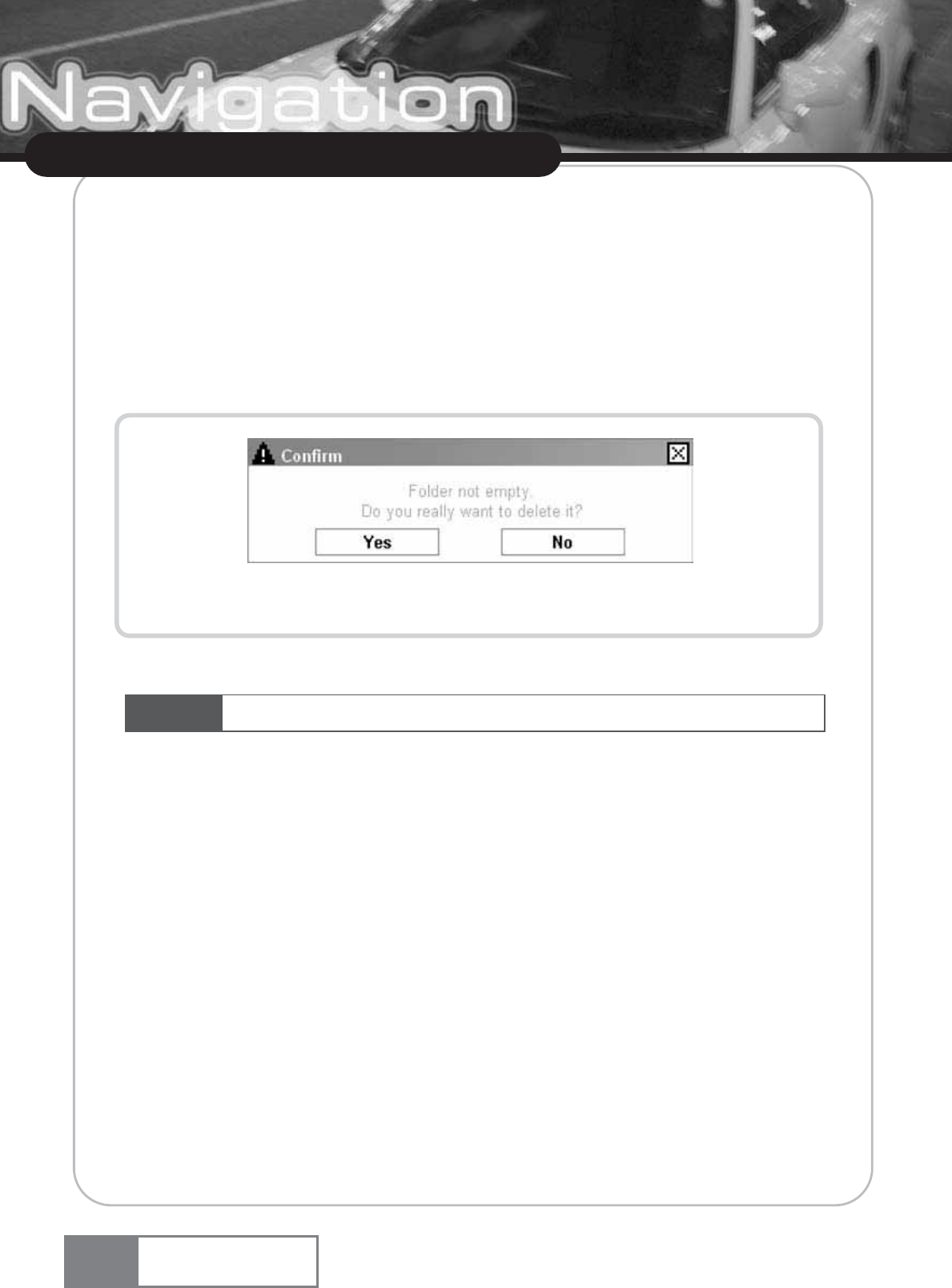
V-Up Pro
E. Deleting music album from the navigation set
E-1) Select the music album to delete from the music album selection combo box.
E-2) Click the ūDelete music albumŬbutton (Figure 5-1 ڻ).
E-3) If no music file is available in the selected music album, the music album will be deleted.
E-4) If any music file is available in the selected music album, the Confirmation window will
appear. See Figure 5-7.
Figure 5-7. Music album deletion confirmation window
E-5) Click the [Yes] button to delete the selected music album.
F. Copying music file to the navigation set
F-1) Select the music album to copy from the music album selection combo box. If no music
album is available, the new music album must be created in advance.
F-2) Open the music file in the user PC. (See ūOpening music file from the user PC.Ŭ)
F-3) Select the music file to copy from the ūMusic file in the user PCŬlist window. (Multiple
selections are supported. See Figure 5-8.)
Navigation System
70
Note All music files in the selected music album will be removed from the navigation set.
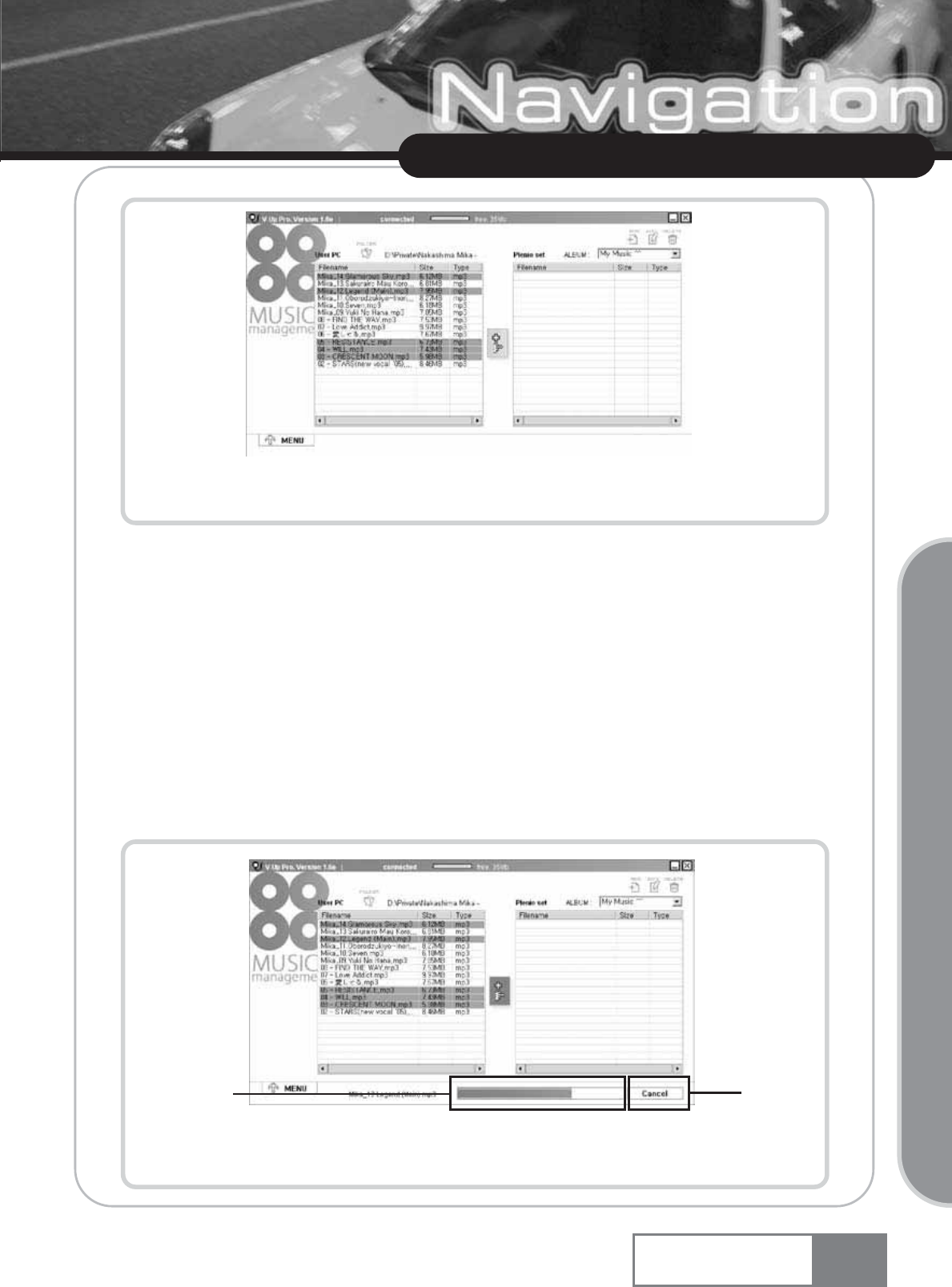
V-Up Pro
V-Up Pro
Figure 5-8. Selecting music file in the user PC
F-4) Click the ūCopy music fileŬbutton (Figure 5-1 ڽ) button.
F-5) While the file(s) is being copied, the file copy progress bar (Figure 5-9 ڸ) will be
displayed.
F-6) When file copying is complete, the copied music file will be displayed in ūMusic file in
the navigation setŬlist window.
G. Cancelling music file copy
G-1) To stop file copy while in progress, click the [Cancel] button (Figure 5-9 ڹ).
Figure 5-9. Music file copy
Navigation System 71
ڡڢ
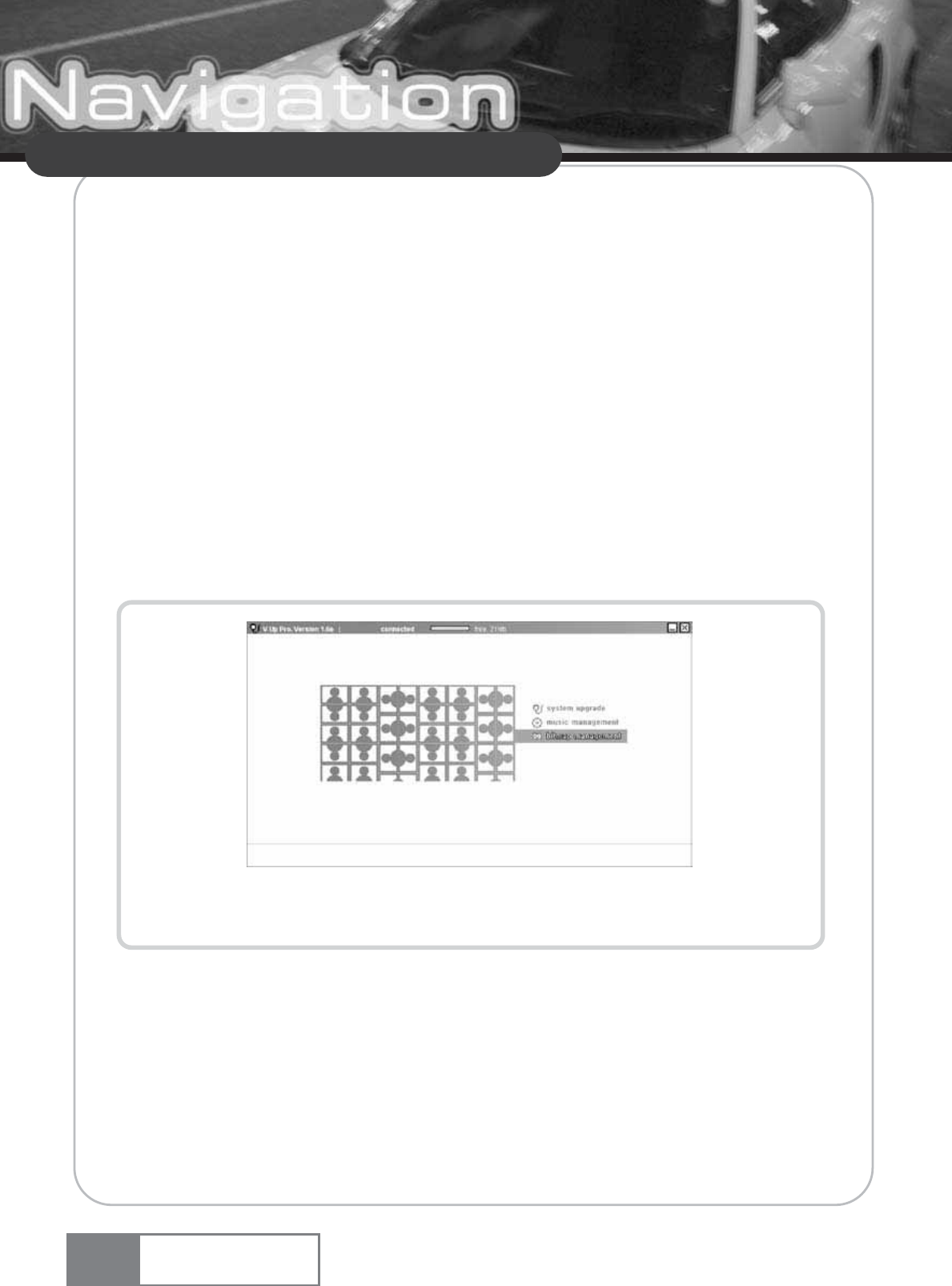
V-Up Pro
H. Deleting music file from the navigation set
H-1) Select the music file to delete from the ūMusic file in Plenio setŬlist window.
(Multiple selections are supported.)
H-2) Click the ūDelete music fileŬbutton (Figure 5-1 ڻ).
H-3) The selected music file will be deleted.
6. Bitmap Management
A. Execution
A-1) Click the ūBitmap ManagementŬicon in the V-Up Pro main window. (See Figure 6-1.)
Figure 6-1. Selecting “Bitmap Management”
Navigation System
72
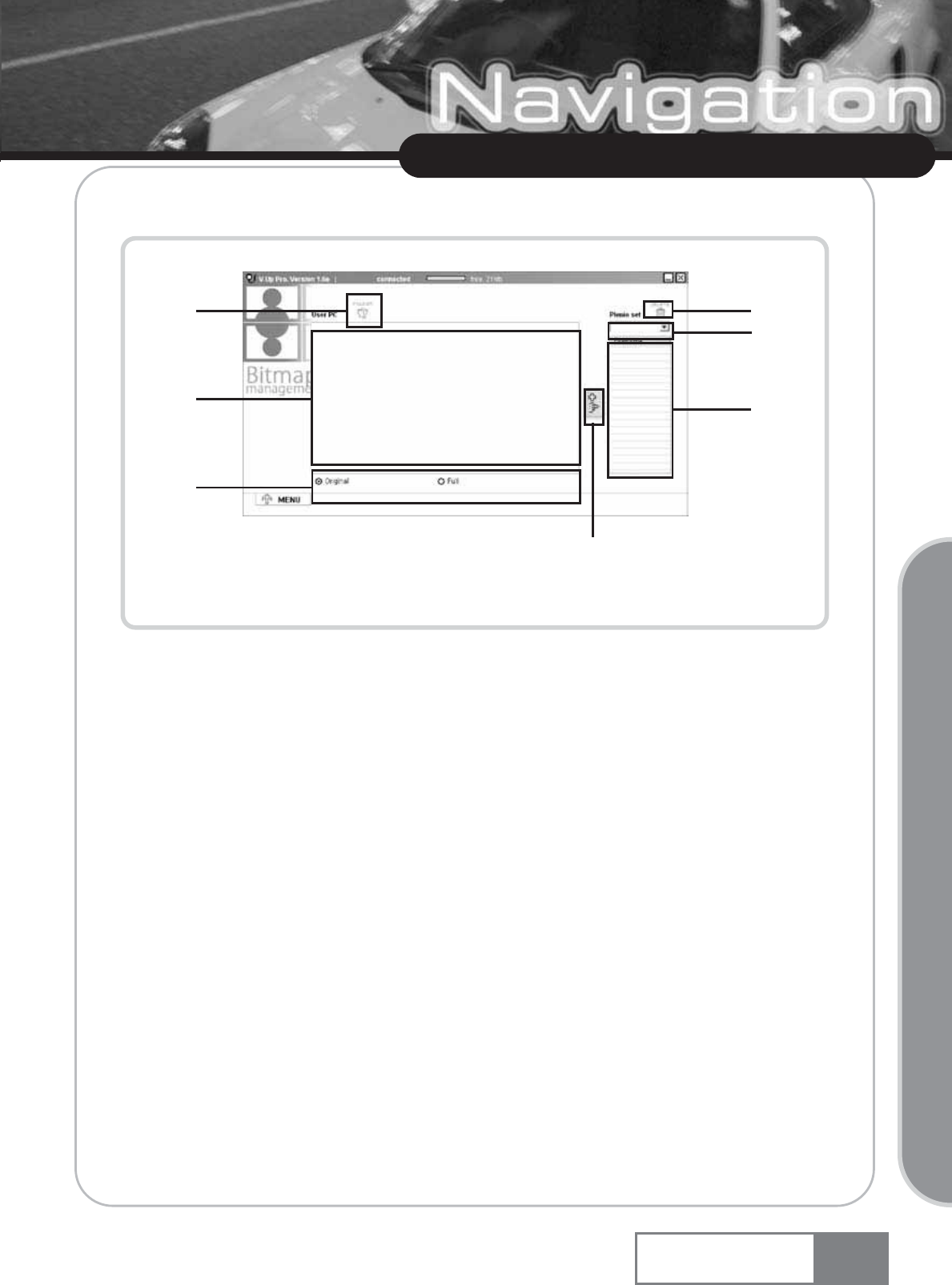
V-Up Pro
V-Up Pro
A-2) The screen shown in Figure 6-2 will appear.
Figure 6-2. Bitmap Management execution screen
ڸOpens the image file from the user PC.
ڹDisplays the image file.
ںDeletes the image file from the navigation set.
ڻBackground image/Slide show folder selection combo box.
ڼList of the image file(s) in the selected folder
ڽImage file copy button
ھRadio button to select the Image file output type
Navigation System 73
ڧ
ڥ
ڢ
ڡڤ
ڦ
ڣ
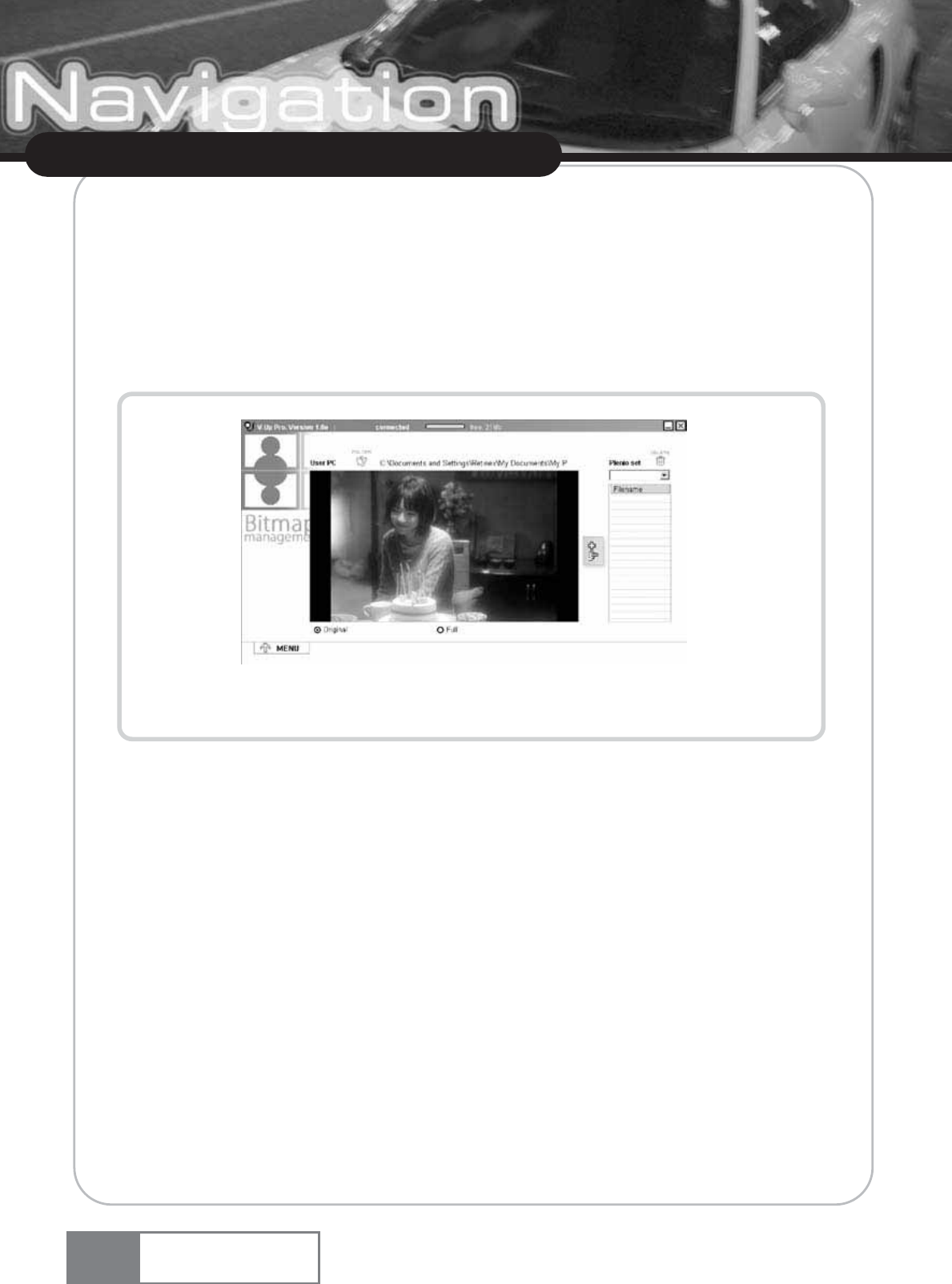
V-Up Pro
B. Opening image file from user PC
B-1) Click the ūOpen image fileŬbutton and select the image file to open.
B-2) Image will be resized to fit into the the navigation set display resolution. See Figure 6-3.
ƕSupported image file format : bmp, jpg
ƕThe navigation set supporting resolution : 480x234
Figure 6-3. Displaying the selected image file.
Navigation System
74
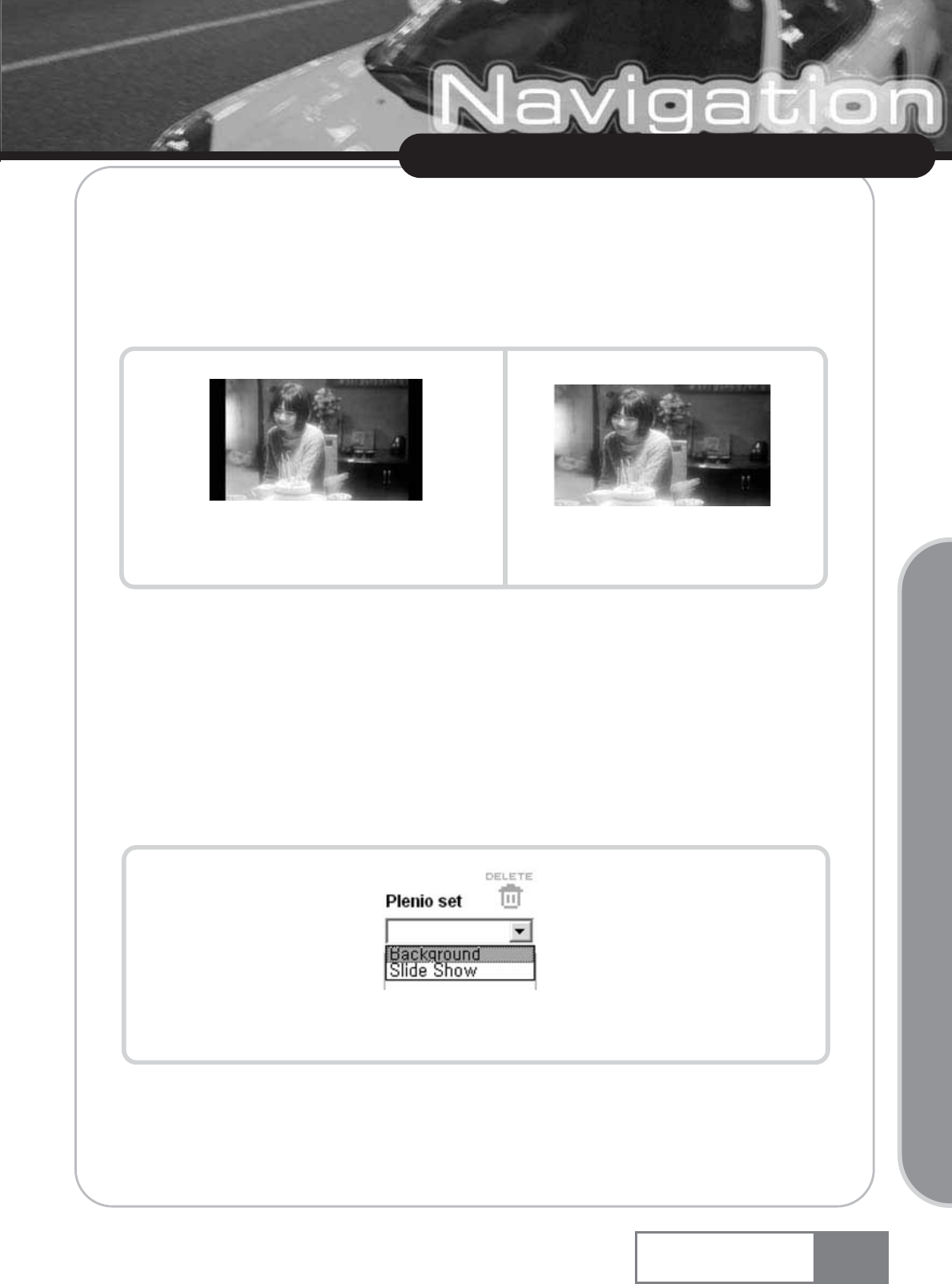
V-Up Pro
V-Up Pro
C. Resizing image
C-1) You can select 1) Keep aspect ratio, or 2) Full screen image before saving it.
C-2) Use the radio button that set the image file output format (Figure 6-2 ھ) to change the
display type.
Example 1. Image with aspect ratio Example 2. Full screen image
D. Selecting target folder to save in the navigation set
D-1) Select the target folder to save using the ūSelect background/slide show folderŬcombo
box. See Figure 6-4.
(1) Background folder : Saves the bit map file that can be a background image of the
navigation set.
(2) Slide show folder : Saves the bit map file that composes the slide show.
Figure 6-4. Selecting target folder
Navigation System 75
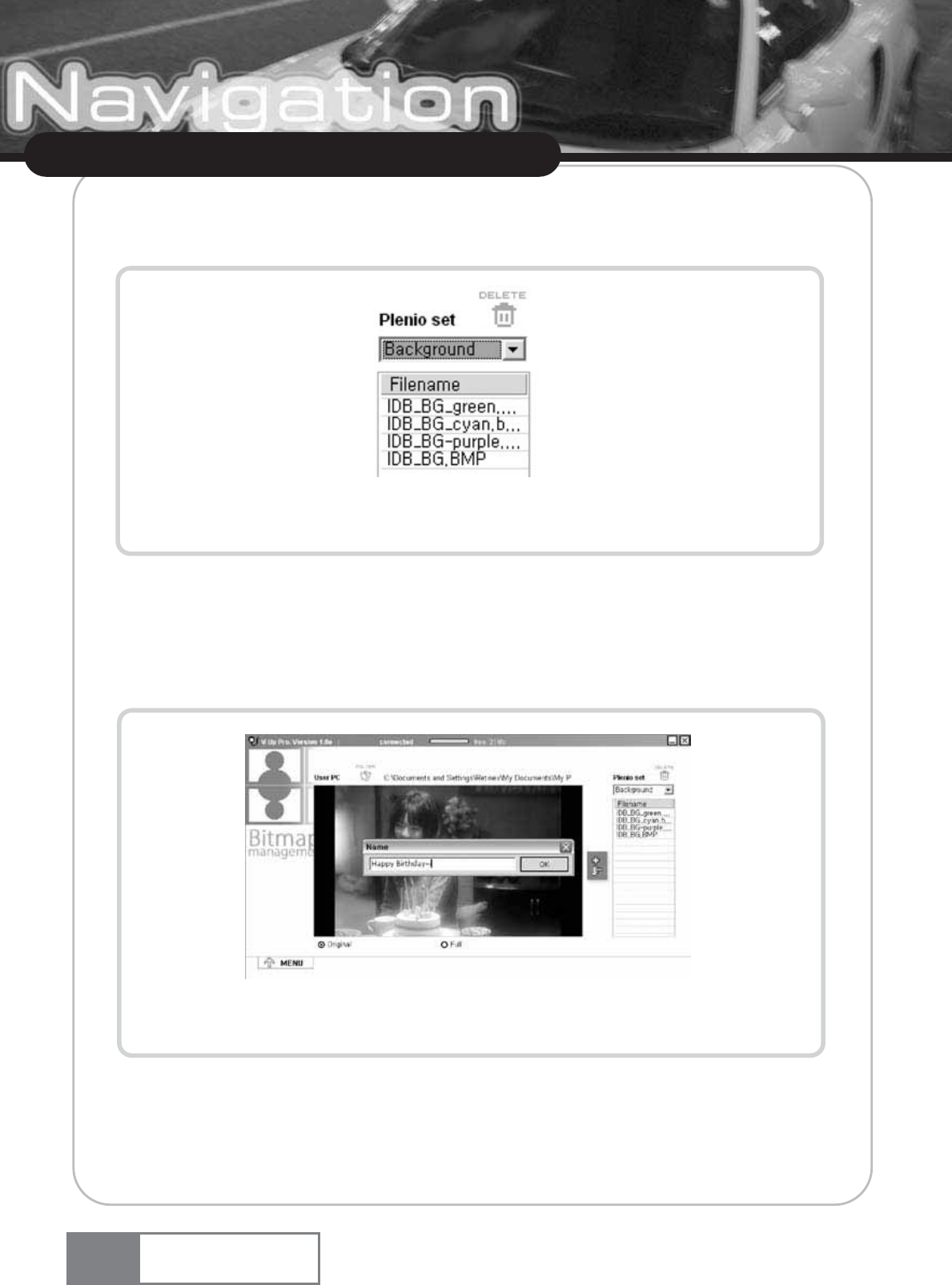
V-Up Pro
D-2) If any bit map file is in the selected target folder, the file will be displayed in the image file
list window (Figure 6-2 ڼ). See Figure 6-5.
Figure 6-5. List of file(s) in the background folder
E. Copying image file to the navigation set
E-1) When you click the ūCopy image fileŬbutton (Figure 6-2 ڽ), the image file name input
window will appear. See Figurer 6-6.
Figure 6-6. Image file name input window
E-2) The image file displayed in the output window (Figure 6-2 ڹ) will be saved in the target
folder with the entered name.
Navigation System
76
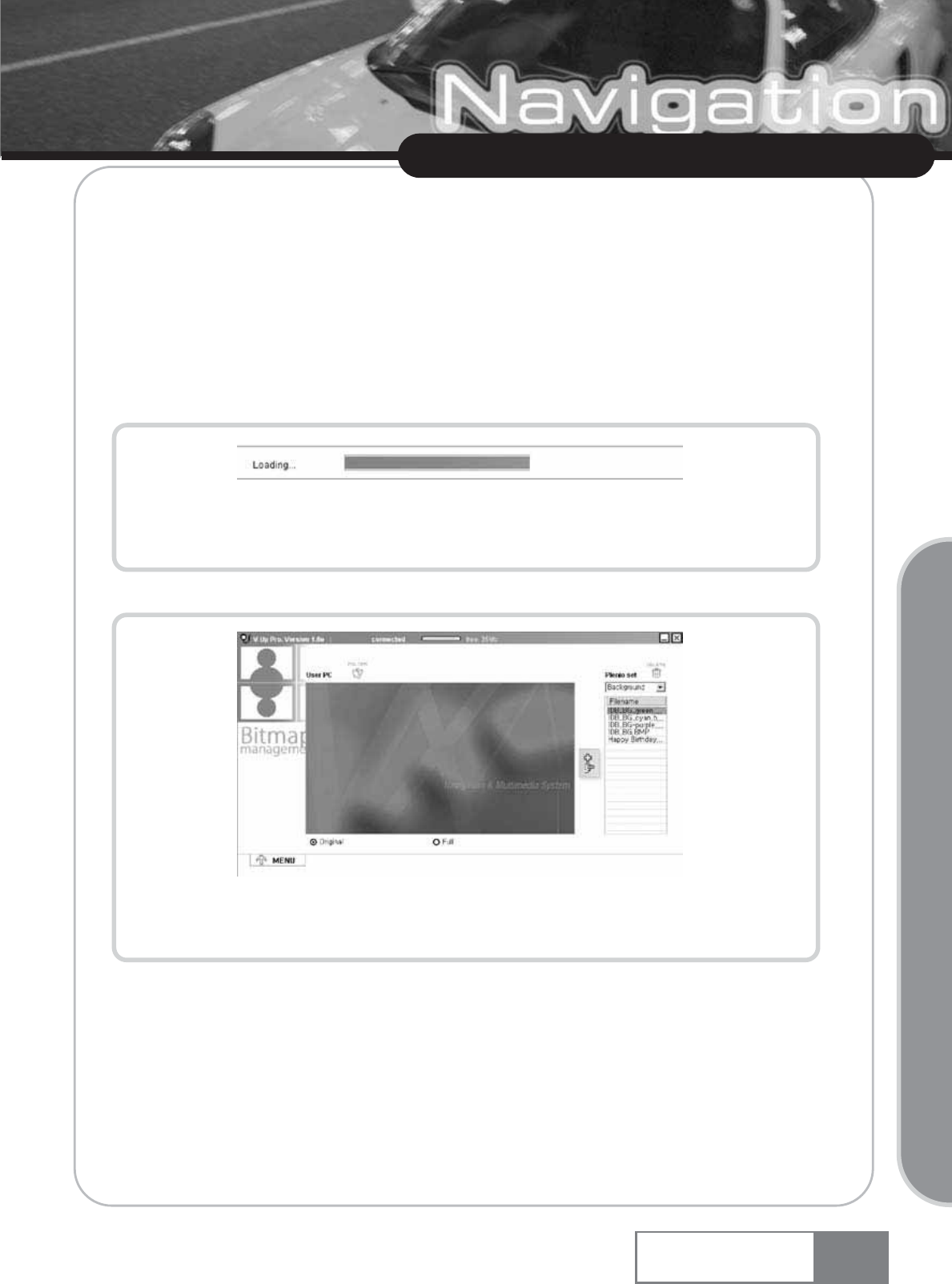
V-Up Pro
V-Up Pro
F. Previewing bit map in the navigation set
F-1) The image file list window (Figure 6-2 ڼ) displays the list of image files in the selected
target folder, as well as provides the image file preview function.
F-2) Select one image in the image file list window (Figure 6-2 ڼ).
F-3) When the image file is opened (See Figure 6-7), the selected image file will be displayed in
the image file display window. See Figure 6-8.
Figure 6-7. Image file loading status
Figure 6-8. Image file opened from the navigation set
Navigation System 77
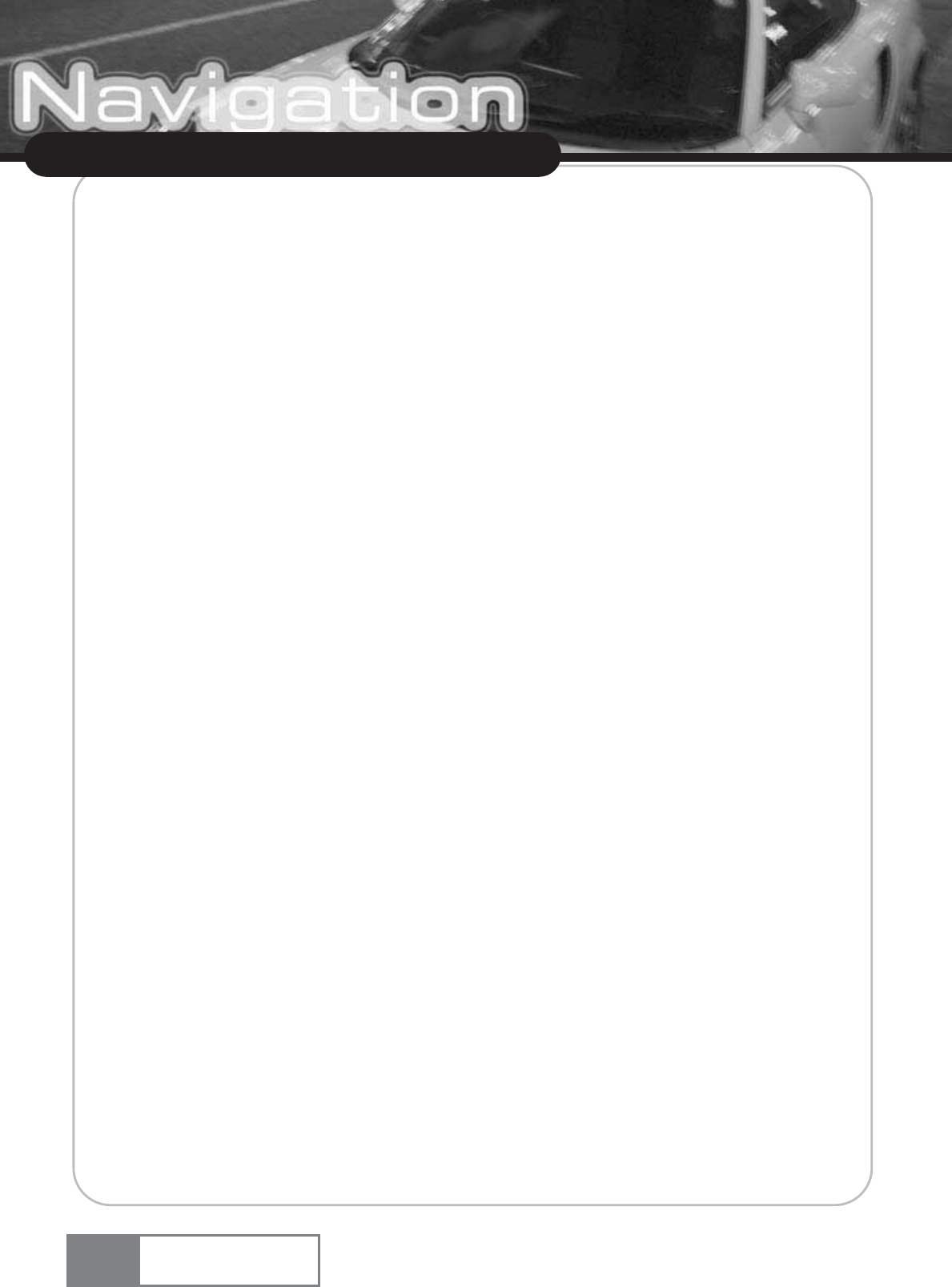
V-Up Pro
G. Deleting image file from the navigation set
G-1) Select the image file to delete from the ūimage file in the selected folderŬwindow.
(Multiple selections are supported.)
G-2) Click the ūDelete image fileŬbutton (Figure 6-2 ں).
G-3) The selected image file will be deleted.
Navigation System
78
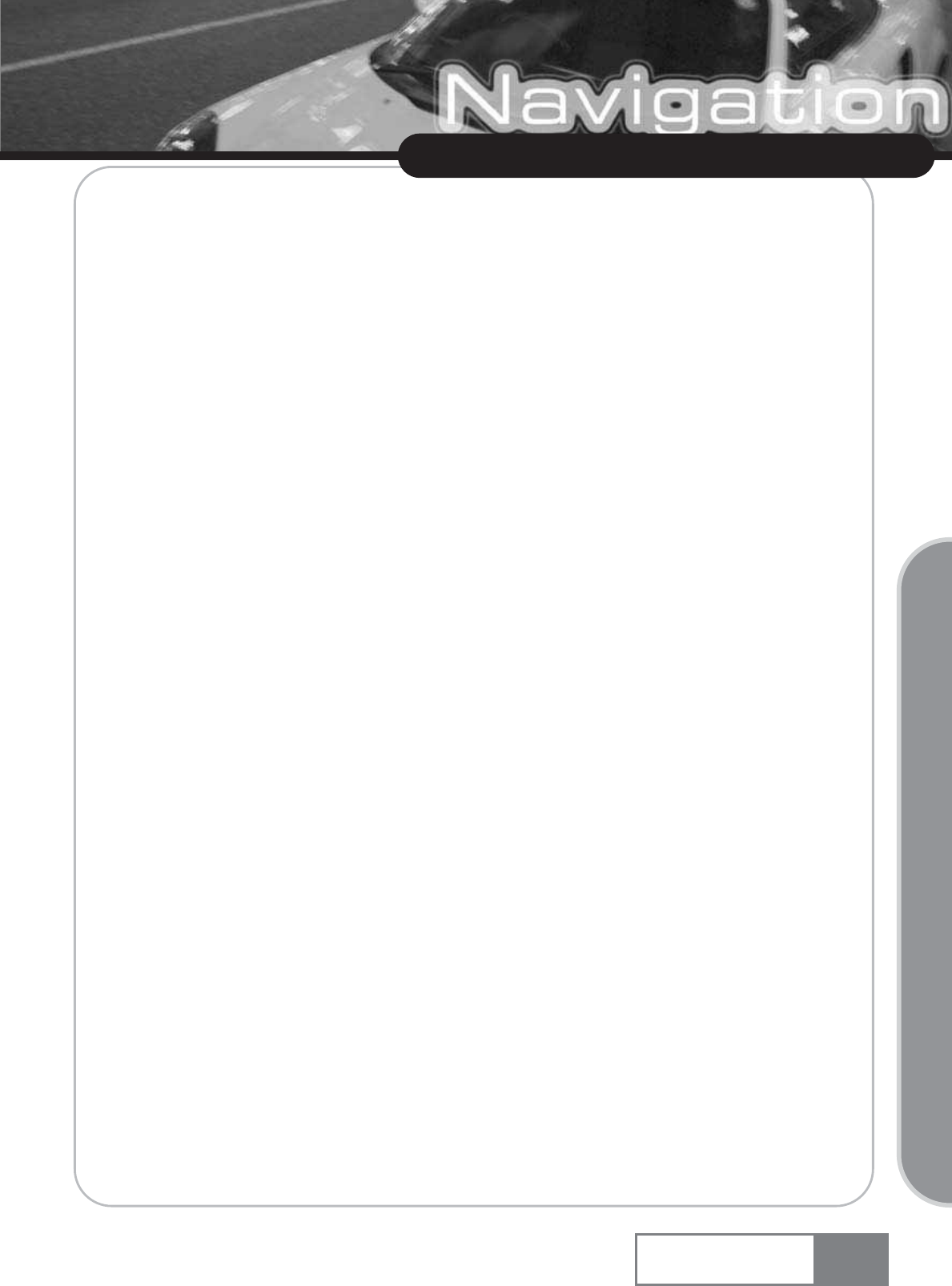
Upgrading Navigation System
Upgrading Navigation System
Downloading Navi or OS
You can download ActiveSync installation file and various download files from the DVD-ROM disc.
What is V-Up Pro?
V-Up Pro is the Navigation System management program and performs the following functions.
1. Managing the music files (MP3, WMA, and WAV)
2. Managing background images and slide shows
ȯYou can download ActiveSync and the latest version of ActiveSync from the dvssales
web site.
ȯConnect Navigation System to the PC using the USB cable included in the product package.
ȯYou can use various functions when you run the installed V-Up Pro program.
Navigation System 79
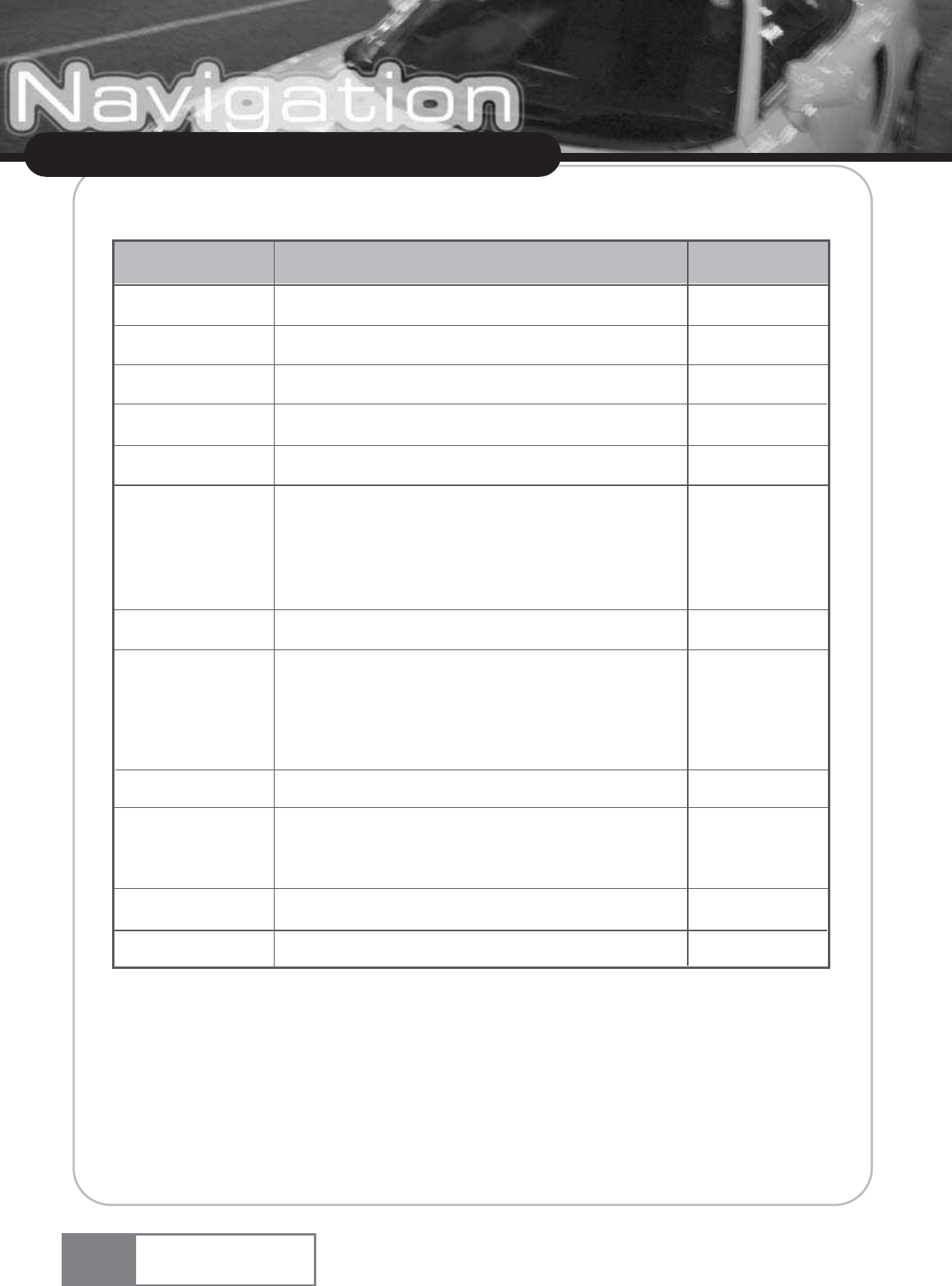
Upgrading Navigation System
Specification
Navigation System
80
Item
OS
CPU
RAM
FLASH
DISPLAY
AUDIO
GPS module
GPS sensitivity
Input power
Temperature
Size
Weight
MS WINDOWS CE.NET 4.2
SAMSUNG S3C2440A
64M Bytes
512M Bytes
7ŕTFT LCD (Touch screen support)
Internal speaker (1 watt)
Line-out output
Connect to the car audio using
SiRF star III GPS engine, external type
First start sensitivity: -134dBm
Restart sensitivity: -146dBm
Sensitivity in motion: -153dBm
12V, 1A
In storage: -35 ~ 75ŪC
In running: -10 ~ 60ŪC
182֮ţ117֮ţ34.2֮
493g
Details Remark
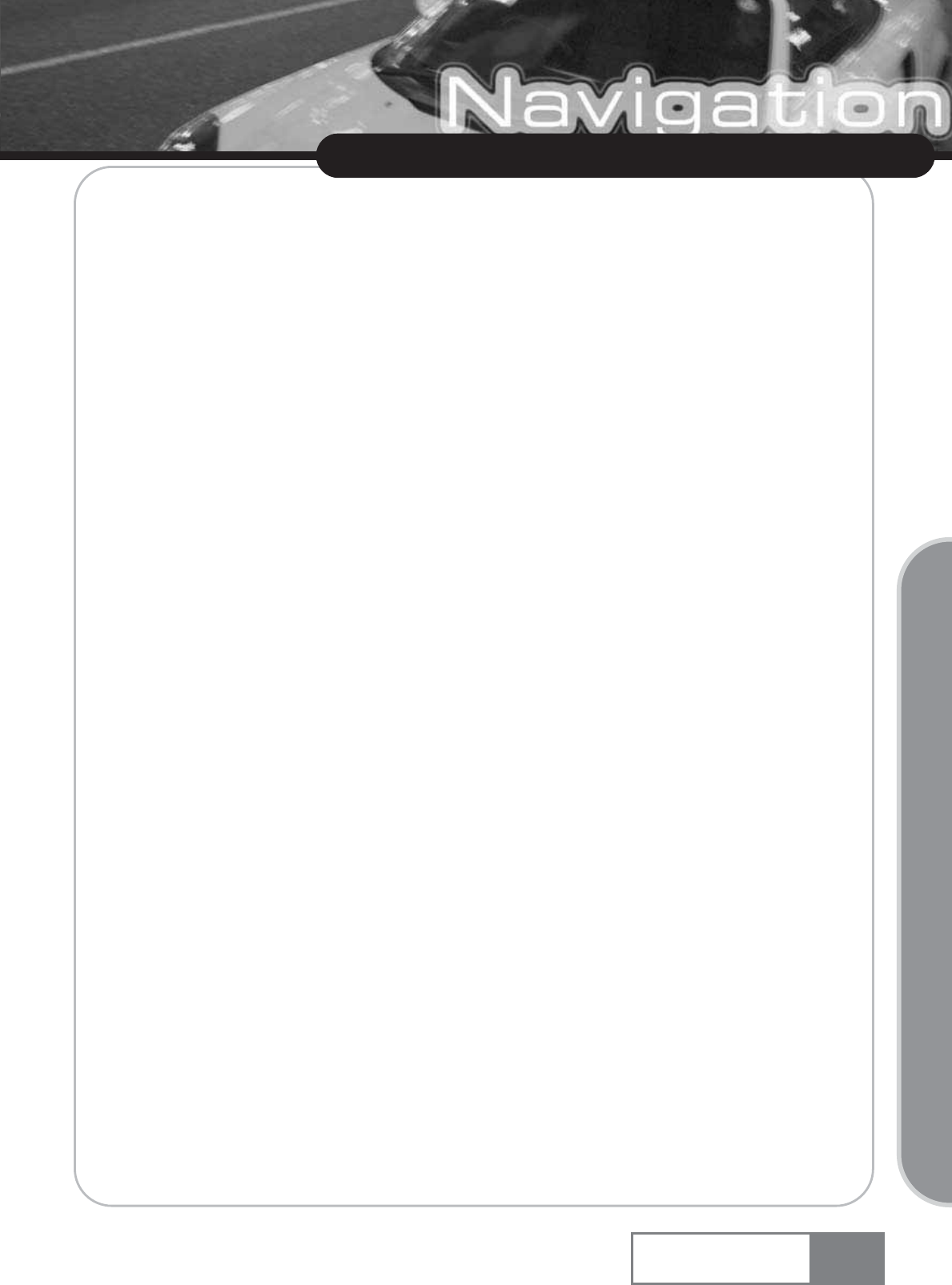
Customer support and Product Enquiry
Customer support and Product Enquiry
Customer support and Product Enquiry
The product warranty period is calculated from the date of product purchase. Therefore, make sure
to write down the purchase data and keep your sales receipt for proper after service.
[If the product purchase date cannot be known, the product warranty period will start 3 months
from the manufacturing date or import customs clearance date.]
Customer Service Center
Customer service and complaint reporting
You can make an enquiry or ask advice about the product through a phone call or in the web site.
DVS SALES,INC 1180 ASTER AVE, SUNNYVALE, CA 94086
TEL : 408 260 3303
FAX : 408 260 3304
EMAIL : cs.dvs@dvs.co.kr
HOME PAGE : www.dvssales.com
Navigation System 81
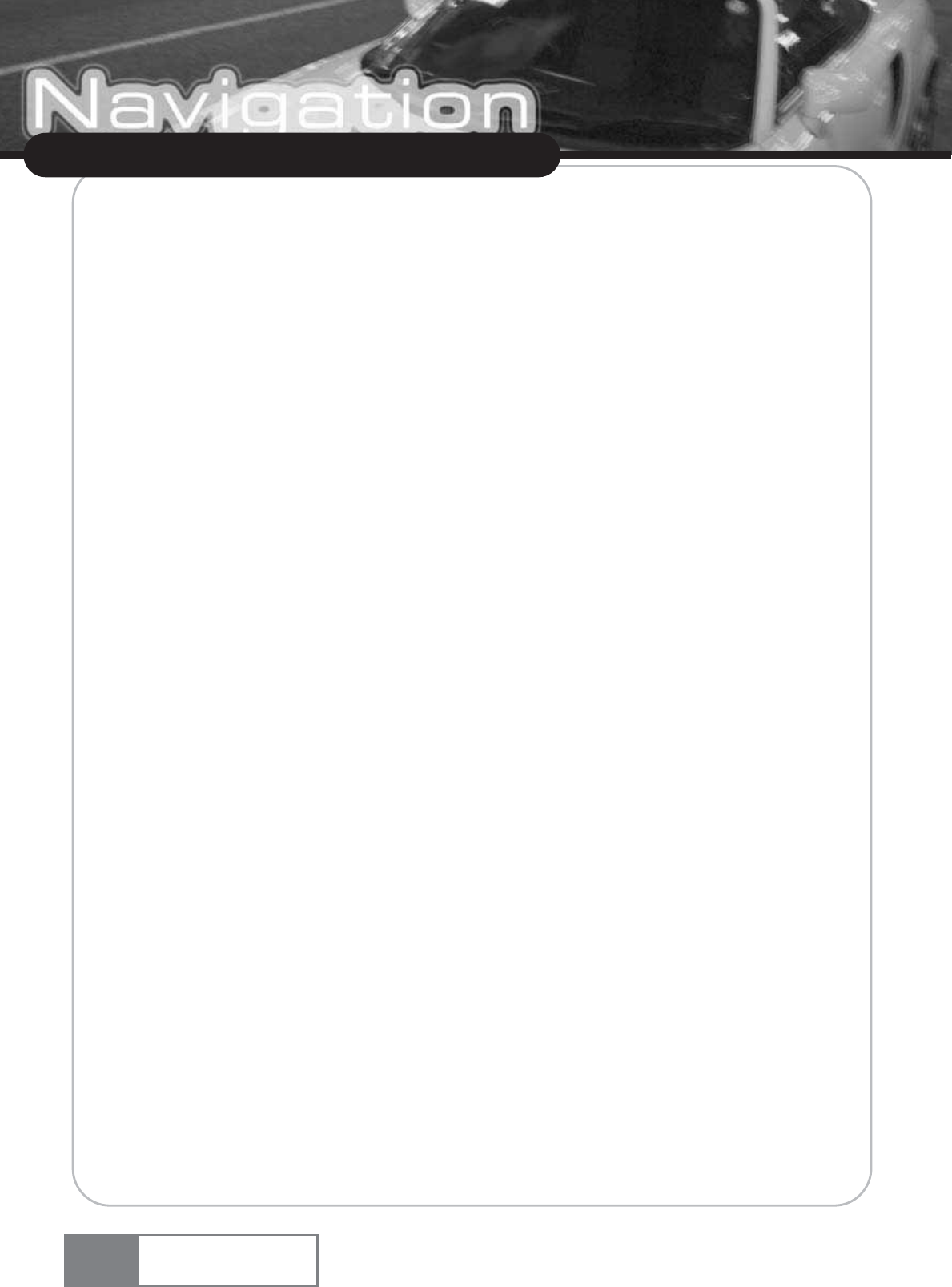
82
MEMO
Navigation System
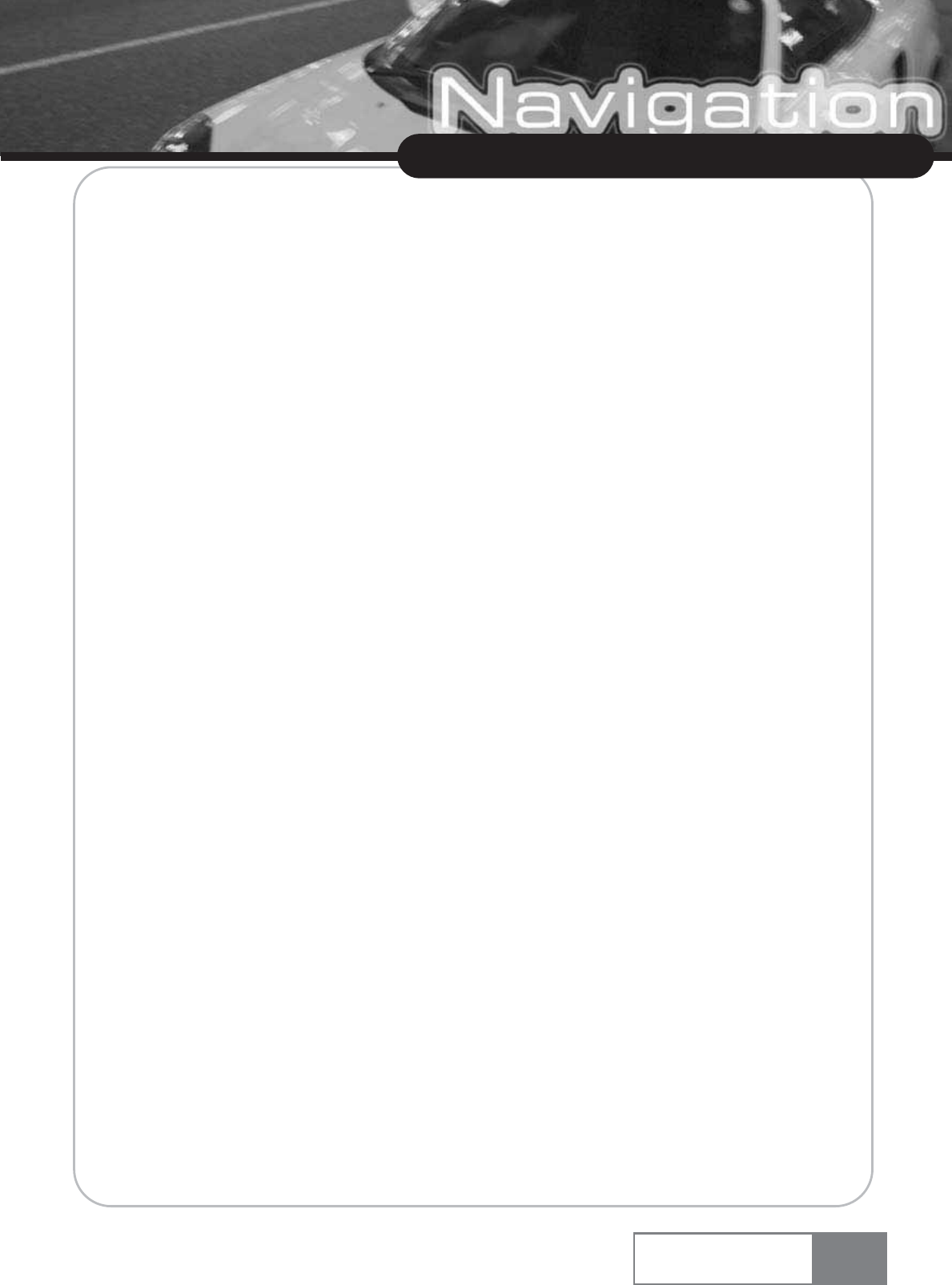
83
MEMO
Navigation System
